- Research article
- Open access
- Published: 22 March 2016

Primary care providers’ experiences caring for complex patients in primary care: a qualitative study
- Danielle F. Loeb ORCID: orcid.org/0000-0003-1688-8799 1 ,
- Elizabeth A. Bayliss 2 , 3 ,
- Carey Candrian 1 ,
- Frank V. deGruy 3 &
- Ingrid A. Binswanger 1 , 2
BMC Family Practice volume 17 , Article number: 34 ( 2016 ) Cite this article
22k Accesses
59 Citations
10 Altmetric
Metrics details
Complex patients are increasingly common in primary care and often have poor clinical outcomes. Healthcare system barriers to effective care for complex patients have been previously described, but less is known about the potential impact and meaning of caring for complex patients on a daily basis for primary care providers (PCPs). Our objective was to describe PCPs’ experiences providing care for complex patients, including their experiences of health system barriers and facilitators and their strategies to enhance provision of effective care.
Using a general inductive approach, our qualitative research study was guided by an interpretive epistemology, or way of knowing. Our method for understanding included semi-structured in-depth interviews with internal medicine PCPs from two university-based and three community health clinics. We developed an interview guide, which included questions on PCPs’ experiences, perceived system barriers and facilitators, and strategies to improve their ability to effectively treat complex patients. To focus interviews on real cases, providers were asked to bring de-identified clinical notes from patients they considered complex to the interview. Interview transcripts were coded and analyzed to develop categories from the raw data, which were then conceptualized into broad themes after team-based discussion.
PCPs ( N = 15) described complex patients with multidimensional needs, such as socio-economic, medical, and mental health. A vision of optimal care emerged from the data, which included coordinating care, preventing hospitalizations, and developing patient trust. PCPs relied on professional values and individual care strategies to overcome local and system barriers. Team based approaches were endorsed to improve the management of complex patients.
Conclusions
Given the barriers to effective care described by PCPs, individual PCP efforts alone are unlikely to meet the needs of complex patients. To fulfill PCP’s expressed concepts of optimal care, implementation of effective systemic approaches should be considered.
Peer Review reports
Complex patients, defined by the Agency for Healthcare and Quality (AHRQ) as persons with two or more chronic conditions where each condition may influence the care of the other condition, are commonly cared for in primary care [ 1 ]. Complex patients with multiple chronic conditions have increased medical costs, a higher number of preventable complications, higher rates of avoidable hospitalizations, and decreased quality of life [ 2 , 3 ]. In 2006, over 25 % of adult patients and 75 % of those over 65 reported having more than one chronic condition [ 4 ]. One study of 148 primary care practices found that 45 % of adult patients had two or more chronic conditions [ 5 ]. Family physicians in Wisconsin reported addressing more than four problems per visit in over half of the visits for diabetes care [ 6 ].
Complex patients’ experience well-described barriers to self-care have been well studied [ 7 , 8 ]. Less is know from the provider perspective. Physicians and pharmacists have highlighted a lack of time, poor communication with specialists, and fragmented care as barriers to effective care [ 9 ]. In studies focused on clinical decision-making for patients with multiple chronic conditions, a lack of time and adequate reimbursement emerged as barriers to clinical decision-making [ 10 , 11 ].
Although barriers to medication prescribing and decision-making for primary care physicians (PCPs) caring for complex patients have been previously described, less is known about the potential impact and meaning for PCPs of caring for these patients on a daily basis. Developing a greater understanding of PCP experiences caring for complex patients is important because providing such care in the context of scarce time and resources may be associated with physician burnout [ 12 , 13 ]. Burnout in PCPs has been associated with a higher likelihood of leaving practice [ 14 ]. Among New York PCPs, participants described significant time pressures, chaotic work pace, and low level of control over their work [ 15 ]. In the United Kingdom, General Practitioners described tension between addressing their patients’ agendas and meeting quality measures, which increased when treating patients with multiple chronic conditions [ 10 ]. In the 2015 Commonwealth Fund International Health Policy Survey of Primary Care Physicians, only 16 % of US physicians felt that the healthcare system worked well, 33 % felt the quality of care patient received in the healthcare system had gotten worse in the last 3 years, 43 % stated their job was very or extremely stressful, and 34 % were somewhat or very dissatisfied practicing medicine [ 16 ]. Thus, the increasing patient complexity in the setting of limited time and clinical support may represent an important source of career dissatisfaction and burnout for PCPs [ 17 ].
Little is known about the strategies PCPs employ when faced with challenges providing care for complex patients. In order to better understand the day-to-day challenges of PCPs, the strategies they use to meet these challenges, and how to better support PCPs, we sought to characterize PCPs experiences with complex patients. Through open-ended interviews we explored their perceived barriers and facilitators to effective care and their strategies to address barriers.
Study design, setting, population and recruitment
Using a general inductive approach, our qualitative research study was guided by an interpretive epistemology. Because interpretive traditions take human interpretation as a starting point for developing knowledge about the social world, discourse, and its resulting accomplishments, was central to this study to understand participants’ values, beliefs and motivations. Therefore, we conducted a qualitative study of PCPs using previously described open-ended in-depth interviews [ 18 , 19 ]. Briefly, we recruited 15 internists from two university-based clinics (UCs) and three safety net community health clinics (CHCs) affiliated with the University of Colorado School of Medicine. We invited participation by sending email notices to all physicians in the practices (34 and 28 physicians from the UCs and the CHCs, respectively). We used systematic non-probabilistic sampling [ 20 ] to achieve an even distribution of gender, years in practice, and practice location. In line with interpretative and participatory forms of research, participants were viewed as active agents participating in the actual co-construction of meaning, rather than mere subjects representing and reproducing meaning. This distinction mattered for how we classified, organized, and interpreted the data focusing on meaning and intentionality over and above casual explanations. We came to agreement about what is real intersubjectivly, which informed our ability to generate solutions, grounded in lived experience, for handling complex patients. We completed the interview process after 15 interviews with 8 UC and 7 CHC participants after reaching thematic saturation.
Instrument and interview procedures
The interview instrument was developed by the Primary Investigator (D.F.L) and revised iteratively through input from the full research team and other qualitative and health services researchers. It was then refined after three pilot interviews. The interview guide was designed to elicit PCPs’ views of patient factors, physician competence, and healthcare system issues associated with caring for complex patients (Fig. 1 ). The guide also included questions about the role of mental illness in patient complexity. Because we were specifically interested in interpreting facilitators and barriers to care, our analysis sought to identify PCP strategies employed to improve care. We started the interviews by providing participants with a definition of complexity (Fig. 2 ), thereby allowing us to define a common focus of study (i.e., patient complexity) while allowing underlying experiences or processes related to complexity to also emerge from the data.
Interview Guide: Sample Questions
Definition of complex patient provided to participants [ 1 ]
Schematic Illustration of Primary Care Providers (PCPs) Caring for complex patients in context of local and healthcare system barriers with inadequate resources
Participants were asked to bring de-identified clinical notes from three patients who met the definition to the interview to keep the discussion focused on concrete cases seen in clinical practice rather than broad generalization. Participants were also asked to complete a brief demographic survey.
The Primary Investigator (D.F.L.), a PCP, and another investigator (C.C.), conducted the interviews from July through December 2010. The one-on-one interview format was selected to allow deep exploration of individual clinician experiences and reactions to these experiences in a confidential setting [ 21 ]. Participants were not compensated. Interviews were conducted in a private space, lasted approximately 60 min, were digitally recorded, uploaded to a secure drive, and professionally transcribed.
Interview transcripts and a demographic survey were our primary data sources. Transcript files were entered into qualitative data analysis software (ATLAS.ti Scientific Software Development GmbH, Berlin, Germany). We used an interpretive and participatory approach to explore patterns and themes [ 22 , 23 ]. Members of the team included health services researchers, including: two general internists (D.F.L and I.A.B) and two family medicine physicians (E.A.B. and F.V.D.) and a Doctor of Health Communication (C.C.). The PI (D.F.L.) and another team-member (C.C.) conducted the interviews. Recognizing our unique positions and our own interpretive frameworks, the analysis was guided by qualitative research ethics that allowed us to interpret interviews not simply as representational of all PCPs. Rather, since the research team consisted of PCPs and health services researchers, our interpretation involved a generative discussion of meaning with the potential to better understand our shared situation around complex patients [ 24 ].
D.F.L. performed initial coding using an inductive coding approach [ 22 ]. Codes were initially broadly categorized according to the domains of patient care explored in the interviews [ 25 ]. Then, two other team members (I.A.B. and E.A.B.) independently coded two of the interviews and worked with the primary coder to resolve differences and create the final codebook. Other team members (C.C. and F.V.D.) reviewed a subset of transcripts. The full team met to discuss emerging themes and discrepancies. We coded data for manifest content meaning (surface content, e.g., PCPs shared that helping complex patients avoid hospitalizations was rewarding for them) and latent content meaning (underlying meaning, e.g., grouping the activity of helping patients avoid hospitalization into the category of optimal care) [ 26 ].
COREG checklist can be viewed online (Additional file 1 ). This study was approved by the Colorado Multiple Institutional Review Board. All participants signed written consent to participate in the study.
Participant characteristics ( N = 15) are described in Table 1 .
Overview of PCP experiences
PCPs described complex patients as those with multidimensional needs, such as socio-economic, medical, and mental health. A vision of optimal care for complex patients emerged from the data, but PCPs also encountered significant local and larger healthcare system level barriers to providing such care. To overcome these barriers, PCPs depended on professional values and individual care strategies. We developed a schematic illustration to illustrate this problem of inadequate PCP resources to meet the challenge of caring for complex patients (Fig. 3 ).
Complex patients
Participants described complex patients as those with medical, mental health, and social needs. One CHC participant described a typical highly complex patient:
[This 52-year-old patient] has diabetes, hypertension, gout, hyperlipidemia, peptic ulcer disease, asthma. His med list is at least two pages long. He was homeless and had depression and schizoaffective [disorder]… He had only been out of jail for a couple weeks. He had no insurance or anything…. He wasn’t eating regularly, so he was afraid to take his insulin…
Optimal care
Participants described the needed care for complex patients and PCPs’ ideal role in this care, which we termed “optimal care”. We defined optimal care as the activities they described performing in their role as PCPs that were most helpful to their patients and rewarding for them. Coordinating care, preventing hospitalizations, and building patient trust were identified as key elements of optimal care.
Coordinating care
For most participants, managing discussions among specialists and helping patients to make informed decisions was one of their most important roles. One CHC participant discussed the importance of the PCP leading the healthcare team:
I also think that for some things you just need to have someone who is in charge. For the complicated patients who haven’t done well, nobody has said, ‘I'm in charge. I'm taking care of you’. You know, ‘I’m going to be the captain of this ship.’
One UC participant described coordinating care for her complex patients as both necessary and fulfilling.
Every time I see him I’ve ended up… contacting 6 or 7 other providers. We’ve all decided that’s what it is going to take to make sure that this individual gets what he needs… I feel like I do have a role and I really feel like I’m fulfilling my role as a coordinator for him…and I see it helping him become more confident in his decisions and about his ability to take care of himself.
Preventing hospitalizations
Many participants were highly satisfied helping their patients avoid hospitalizations by care coordination, frequent follow-up visits, and careful attention to their medical regimens. One CHC participant explained, “Being outpatient, many things can fall through. When you can make a smooth transition for a patient without them ending up in the hospital… that is a success story.”
Building trust
PCPs discussed developing a trusting relationship with their patients as therapeutic for patients and as fundamental to their ability to provide optimal care. One UC physician reported:
[I]t’s almost like we’re attached to each other. [Complex patients] always know that even if all the other doctors [specialists] they are seeing aren’t listening, they can come and have a central place where I can help coordinate. So I feel like they trust me, which is probably the most rewarding aspect of their care.
Healthcare system factors
PCPs described healthcare system factors that interfered with their ability to provide optimal care, including payment systems, patient insurance issues, poor access to mental healthcare, and the fragmentation of care.
Payment systems
Some UC participants expressed the belief that the prevalent fee-for-service payment system undermined effective patient care, because payment was focused on discrete services rather than coordination of care. One UC PCP described large amounts of uncompensated time coordinating care:
A patient I take care of who has multiple sclerosis comes in once a year…otherwise it’s all done by phone or communication with her visiting nurse. Over the course of a year I might spend 15 or 20 h on her care. I get paid for the 40 min that she spends in my office once a year.
Uninsured or underinsured patients
Both UC and CHC participants cited lack of insurance or underinsurance as a barrier to optimal care for complex patients. For example, on UC PCP explained:
[H]e has insurance, but with all of his 20 different medications, it costs him over $200 a month for his prescriptions. So he [rations]…he doesn’t take all of his meds… This is a guy who works 40 h a week, who has insurance, but still can’t afford everything.
Poor mental health care access
PCPs at all clinics expressed frustration with challenges in accessing mental health care. One UC participant discussed the lack of resources for patients with suicidal ideation:
I think the access to mental health assistance is so poor… You know, somebody comes in and says they are going to hurt themselves, our only option is to send them to the emergency room… Often times you can’t get them to be seen anywhere.
Fragmentation of care
PCPs described barriers that were consistent with the concept of care fragmentation, defined in the literature as “having multiple decision makers make a set of health care decisions that would be made better through unified decision making” [ 27 ], interfered with patient care. This issue was particularly salient for patients with mental illness. One UC PCP expressed frustration over the challenges he found communicating with psychiatrists outside of his system. Referring to patients seen at a local behavioral health organization: “They don’t use the same record system. So, I can’t see what the psychiatrist is doing if they [my patients] do manage to land in a psychiatry office. It is hard to call and speak with them.”
Local system factors
Within local healthcare systems, participants struggled with insufficient clinical support, challenges communicating with specialists, and productivity demands.
Insufficient clinical support
Providers reported lack of case management and social work support in their local clinics as important barriers to optimal care. Social workers were identified as an important needed resource to improve care for complex patients. One PCP from a UC stated:
We essentially don’t have the social worker.... I mean getting people to appointments and making sure they have [transportation service] or does someone need to be checked up on. We don’t have help with any of that, and, to be honest, a lot of it just goes to the wayside because we don’t have help…
While participants in the CHCs did have a social worker, they did not have case management or mental health services. With case management support PCPs believed they could more effectively use their time.
Communication with specialists
While communication with specialists was fundamental to PCP’s ability to provide comprehensive care to complex patients, many participants described this communication as time consuming and, at times, impossible. One UC PCP explained, “The reality is, you can try to page the doctor [specialist]… but you end up leaving a message and then they may or may not get back to you.”
Productivity demands
PCPs at both UCs and CHCs expressed frustration over productivity demands. CHC PCPs focused on lack of flexibility with visit length.
There is no ability to have more time with individual patients. If you are a provider who has a lot of complicated patients, that doesn’t affect [i.e., lower] your productivity expectations or [lower] your panel size expectations.
UC PCPs focused on pressures around billing and compensation unrelated to patient care:
[T]he things that really matter have almost nothing to do with how we’re paid. In order to take care of these people, we have to have the background knowledge of their life experiences and their multiple diseases and their multiple medicines. Their spouse died of cancer and they’ve had problems with depression and a life long history of alcohol… What we get paid for is…[how] many body parts we examine and…[how] many different things that we’ve asked them…
PCP professional values
When discussing successful approaches to managing patient complexity, participants emphasized the importance of values of professionalism and self-reflection. They relied on these professional values to provide optimal care in the face of significant system barriers.
Professionalism
The theme of professionalism emerged, which was described as rendering appropriate care despite barriers. PCPs ensured patients received the care they needed, despite inadequate resources, by spending extra time caring for complex patients. Personal sacrifice and the placement of patient needs over their own personal needs were noted as integral to the provision of effective care. For example, one UC participant stated: “So really I think, if you approach it with an attitude of service that you are a servant to these people and you really have to kind of efface your own needs…”
Another UC participant discussed the importance of following complex patients closely regardless of whether those activities are compensated:
Like sometimes it is like staying late at night to call a patient when they are in the hospital somewhere to make sure they are going to make an appointment to come back in and be seen. Or you know, you make a referral and hey, I noticed you didn’t go to your referral. What’s going on? Why didn’t you make it? … It takes time and we don’t get paid for any of that. Nobody cares whether or not you stay late to do that.
A CHC participant expressed a similar idea, “And the professional piece, realizing that sometimes I do need to work through lunch with the dementia patient where the family is fighting.” However, that PCP continued to note the possible consequence of self-sacrifice, “I mean the flip side of that is I’m so frustrated with our system that I don’t do a lot of clinic.”
Self-reflection
PCPs emphasized the importance of self-reflection when treating complex patients, especially those with challenging communication styles. A UC PCP explained, “I guess I try to be careful. When something about a patient makes you unhappy or uncomfortable, some of it has to be about you, you know? And so I think just recognizing maybe it’s not all them.”
PCP personal strategies
PCPs described the following strategies for taking care of complex patients: getting to know their patients, frequent visits, prioritizing issues, and setting limits.
Getting to know patients
The most common strategy PCPs expressed was the importance of getting to know their patients. Once PCPs understood patients’ complex milieu of medical, mental health, and social issues, they were better able to prioritize issues and help their patients make healthcare decisions in alignment with their goals. A CHC PCP described, “[it’s] seeing where they are and where they are willing to go and to try to meet them part way.” The PCP offered the following example:
The one gentleman who has had the significant alcohol problem … it wasn’t that he admitted he was going to quit drinking, because he is just nowhere near that right now, but he was willing to admit the amount he is drinking and the amount he is eating, is really not good for his overall health. And he knows the alcohol is not good for his overall health. But he doesn’t really want to starve to death. And that is sort of what he’s doing right now. And so he is willing, maybe, to cut back on the alcohol and eat a little bit more. I mean it’s not really that much of an accomplishment, but I think it’s a start …
Another CHC PCP explained the personal reward of getting to know patients well:
I think in talking to people and realizing what else is going on with them, and that is driving some of their difficult or not adherent behavior, or other things, I find that to be rewarding.
Frequent visits
PCPs scheduled frequent visits with their complex patients to avoid crises, lapses in the medication treatment, and hospitalizations.
Prioritizing issues
One of the strategies emphasized was prioritizing issues during patient visits. A CHC PCP suggested, “Try to focus on whatever issues are most going to affect the patient’s health in terms of their quality of life and their ability to function.”
Setting limits
Setting limits with individual patients emerged as a theme. Setting limits was particularly important in caring for patients with chronic pain requesting opioids and with patients with challenging communication styles. On CHC PCP explained their approach, “I go in there, and I’m honest: This is what I’m going to do; this is what I’m not going to do; and, then, that’s the way I follow through.”
Systemic changes
Participants described systemic changes to their practice that would improve the care of complex patients, such as additional assistance from team members. One UC participant expressed the need for team-based approaches: “[I]t really needs to be more than just the physician… I mean especially with the complex patients.” The UC clinics were starting to transition to a Patient Centered Medical Home (PCMH) model. The same provider described positive early experiences with this model.
We have switched to a Medical Home team orientation over the last year and it’s been extremely rewarding… for a medically complex patient it helps… to have other staff help proactively monitor people’s complex conditions.
While participants had minimal experiences with team-based models of care, some perceived teams as strategies to meet the challenges involved in caring for complex patients.
In this study, we used in-depth semi-structured interviews to understand PCP experiences treating complex patients in primary care settings. PCPs described: 1) strong desires to provide optimal care for complex patients with multidimensional needs, 2) significant barriers to optimal care delivery at a local and system level, and 3) reliance on professional values and individual care strategies to overcome these barriers.
PCPs described optimal care for their complex patients in terms of actions they could take that would help their patients’ overall health and quality of life. Specifically, they focused on coordinating care among specialists, preventing hospitalizations, and building patient trust. This description of optimal care aligns with recommendations for a shift from problem-oriented care to goal-oriented care [ 28 , 29 ]. Goal-oriented care focuses on patient-defined goals rather than disease-specific guidelines. This shift has been supported by research that highlights potential negative consequences of following guideline-concordant care for multiple different concomitant diseases in the same patient [ 30 ].
Within their local institutions, PCPs reported that insufficient clinical support, challenges communicating with specialists, and productivity pressures interfered with their care of complex patients. These findings are consistent with past qualitative research on prescribing and decision-making for complex patients [ 9 – 11 ]. Further, the time pressures and lack of clinical support raise a risk of burnout in these providers. In the Minimizing Error, Maximizing Outcome (MEMO) study, adverse workflow (time pressure and chaotic environments), low work control, and unfavorable organizational culture were strongly associated with low physician satisfaction, high stress, burnout, and intent to leave [ 15 ].
PCPs relied on professional values and personal strategies to navigate local institutional and healthcare system barriers to provide optimal care to their complex patients. This emphasis on professionalism, specifically self-sacrifice, and self-reflection by PCPs in this study is consistent with core values of professionalism articulated by physician professional organizations. Professionalism has been identified as one of six Core Competencies for internal medicine residents [ 31 ]. American and European Internal Medicine boards and societies [ 32 ] have identified 1) the primacy of patient welfare; 2) patient autonomy; and 3) social justice as three principles of professionalism. While reliance on professionalism and self-sacrifice is consistent with core competencies, it may not overcome the system barriers preventing optimal care. Further, since professionalism often was described as working longer hours and sacrificing PCP’s personal needs, these strategies may contribute to PCP burnout.
Participants endorsed changes consistent with team-based care models to help them effectively manage complex patients. Team-based interventions [ 33 , 34 ] based on the Chronic Care Model [ 35 ] have been developed for managing high-risk [ 36 ] patients with chronic diseases in the primary care setting. Transitioning to team-based models may address some of the barriers to optimal care identified by PCPs in our study. Among VA primary care personnel, those working in clinics that were appropriately staffed, emphasized participatory decision making, and had an increased proportion of time team members spend working to the top of their competency level reported lower rates of burnout [ 37 ]. Working in a tight team structure and greater perceptions of team culture have been associated with less clinician exhaustion [ 38 ].
Readers should generalize these findings with caution. First, all participants were affiliated with a single university in the Rocky Mountain region, but worked diverse settings, including an academic medical center and urban, community health centers. These clinical sites were chosen because of their concentration of complex patient populations. Second, the providers in this study were relatively young and most had been in practice for less than 10 years. Physicians in practice for longer may develop greater skills for managing complex patients. Third, four of the five researchers who conducted this study were PCPs. Thus, the analysis was likely influenced by their own professional roles, which may have informed a rich understanding and generative discussion of meaning regarding the care of complex patients [ 24 ]. Lastly, we used the term “complex patients” in materials with participants because it is commonly used in the United States when referring to patients with multiple chronic conditions. However, we have some concern that this term can have a pejorative connotation. AHRQ has more recently been using the term “patients with complex care needs”. Other commonly used terms include multimorbidity and multiple chronic conditions.
Our study identified core struggles in the daily practice of managing complex patients. PCP reliance on professional values and individual strategies to manage systemic challenges may not necessarily produce optimal care and may contribute to PCP burnout. It remains to be shown whether these barriers to optimal care can be reduced with new models of care.
National Quality Forum. Multiple Chronic Conditions (MCC) Measurement Framework. Washington, D.C.; 2012. http://www.qualityforum.org/Projects/Multiple_Chronic_Conditions_Measurement_Framework.aspx
Fortin M, Bravo G, Hudon C, Lapointe L, Almirall J, Dubois MF, Vanasse A. Relationship between multimorbidity and health-related quality of life of patients in primary care. Qual Life Res. 2006;15(1):83–91.
Librero J, Peiro S, Ordinana R. Chronic comorbidity and outcomes of hospital care: length of stay, mortality, and readmission at 30 and 365 days. J Clin Epidemiol. 1999;52(3):171–9.
Article CAS PubMed Google Scholar
Chronic care: Making the case for ongoing care [ http://www.rwjf.org/content/dam/farm/reports/reports/2010/rwjf54583 ]
Ornstein SM, Nietert PJ, Jenkins RG, Litvin CB. The prevalence of chronic diseases and multimorbidity in primary care practice: a PPRNet report. J Am Board Fam Med. 2013;26(5):518–24.
Article PubMed Google Scholar
Beasley JW, Hankey TH, Erickson R, Stange KC, Mundt M, Elliott M, Wiesen P, Bobula J. How many problems do family physicians manage at each encounter? A WReN study Ann Fam Med. 2004;2(5):405–10.
Bayliss EA, Ellis JL, Steiner JF. Barriers to self-management and quality-of-life outcomes in seniors with multimorbidities. Ann Fam Med. 2007;5(5):395–402.
Article PubMed PubMed Central Google Scholar
Koch G, Wakefield BJ, Wakefield DS. Barriers and facilitators to managing multiple chronic conditions: a systematic literature review. West J Nurs Res. 2015;37(4):498–516.
Smith SM, O’Kelly S, O’Dowd T. GPs’ and pharmacists’ experiences of managing multimorbidity: a ‘Pandora’s box’. Br J Gen Pract. 2010;60(576):285–94.
Bower P, Macdonald W, Harkness E, Gask L, Kendrick T, Valderas JM, Dickens C, Blakeman T, Sibbald B. Multimorbidity, service organization and clinical decision making in primary care: a qualitative study. Fam Pract. 2011;28(5):579–87.
Fried TR, Tinetti ME, Iannone L. Primary care clinicians’ experiences with treatment decision making for older persons with multiple conditions. Arch Intern Med. 2011;171(1):75–80.
PubMed PubMed Central Google Scholar
Shanafelt TD, Sloan JA, Habermann TM. The well-being of physicians. Am J Med. 2003;114(6):513–9.
Freeborn DK. Satisfaction, commitment, and psychological well-being among HMO physicians. West J Med. 2001;174(1):13–8.
Article CAS PubMed PubMed Central Google Scholar
Soler JK, Yaman H, Esteva M, Dobbs F, Asenova RS, Katic M, Ozvacic Z, Desgranges JP, Moreau A, Lionis C, et al. Burnout in European family doctors: the EGPRN study. Fam Pract. 2008;25(4):245–65.
Linzer M, Manwell LB, Williams ES, Bobula JA, Brown RL, Varkey AB, Man B, McMurray JE, Maguire A, Horner-Ibler B, et al. Working conditions in primary care: physician reactions and care quality. Ann Intern Med. 2009;151(1):28–36. W26-29.
Osborn R, Moulds D, Schneider EC, Doty MM, Squires D, Sarnak DO. Primary care physicians in ten countries report challenges caring for patients with complex health needs. Health Aff (Millwood). 2015;34(12):2104–12.
Article Google Scholar
Varkey AB, Manwell LB, Williams ES, Ibrahim SA, Brown RL, Bobula JA, Horner-Ibler BA, Schwartz MD, Konrad TR, Wiltshire JC, et al. Separate and unequal: clinics where minority and nonminority patients receive primary care. Arch Intern Med. 2009;169(3):243–50.
Loeb DF, Bayliss EA, Binswanger IA, Candrian C, deGruy FV. Primary care physician perceptions on caring for complex patients with medical and mental illness. J Gen Intern Med. 2012;27(8):945–52.
Loeb DF, Binswanger IA, Candrian C, Bayliss EA. Primary care physician insights into a typology of the complex patient in primary care. Ann Fam Med. 2015;13(5):451–5.
Mays N, Pope C. Rigour and qualitative research. BMJ. 1995;311(6997):109–12.
Giacomini MK, Cook DJ. Users’ guides to the medical literature: XXIII. Qualitative research in health care A. Are the results of the study valid? Evidence-Based Medicine Working Group. JAMA. 2000;284(3):357–62.
Thomas DR. A general inductive approach for analyzing qualitative evaluation data. Am J Evaluation. 2006;27:237–46.
Patton M. Qualitative research & evaluation methods. 3rd ed. Thousand Oaks: Sage; 2002.
Google Scholar
Prasad P. Crafting qualitative research : working in the postpositivist traditions. Armonk: M.E. Sharpe; 2005.
Dickinson LM, Dickinson WP, Rost K, DeGruy F, Emsermann C, Froshaug D, Nutting PA, Meredith L. Clinician burden and depression treatment: disentangling patient- and clinician-level effects of medical comorbidity. J Gen Intern Med. 2008;23(11):1763–9.
Cho JY, Lee E-H. Reducing confusion about grounded theory and qualitative content analysis: similarities and differences. Qual Rep. 2014;19(64):1–20.
Elhauge E. The fragmentation of U.S. health care : causes and solutions. New York: Oxford University Press; 2010.
Book Google Scholar
De Maeseneer J, Boeckxstaens P. James Mackenzie Lecture 2011: multimorbidity, goal-oriented care, and equity. Br J Gen Pract. 2012;62(600):e522–524.
Mold JW, Blake GH, Becker LA. Goal-oriented medical care. Fam Med. 1991;23(1):46–51.
CAS PubMed Google Scholar
Boyd CM, Darer J, Boult C, Fried LP, Boult L, Wu AW. Clinical practice guidelines and quality of care for older patients with multiple comorbid diseases: implications for pay for performance. JAMA. 2005;294(6):716–24.
ACGME Program Requirements for Graduate Medical Education in Internal Medicine [ http://www.acgme.org/acgmeweb/Portals/0/PFAssets/2013-PR-FAQ-PIF/140_internal_medicine_07012013.pdf ]
Foundation ABoIMA, Foundation ACoP-ASoIMA-A, Medicine EFoI. Medical professionalism in the new millennium: a physician charter. Ann Intern Med. 2002;136(3):243–6.
Carter BL, Rogers M, Daly J, Zheng S, James PA. The potency of team-based care interventions for hypertension: a meta-analysis. Arch Intern Med. 2009;169(19):1748–55.
Boyd CM, Reider L, Frey K, Scharfstein D, Leff B, Wolff J, Groves C, Karm L, Wegener S, Marsteller J, et al. The effects of guided care on the perceived quality of health care for multi-morbid older persons: 18-month outcomes from a cluster-randomized controlled trial. J Gen Intern Med. 2010;25(3):235–42.
Wagner EH, Austin BT, Von Korff M. Organizing care for patients with chronic illness. Milbank Q. 1996;74(4):511–44.
Baskerville NB, Liddy C, Hogg W. Systematic review and meta-analysis of practice facilitation within primary care settings. Ann Fam Med. 2012;10(1):63–74.
Helfrich CD, Dolan ED, Simonetti J, Reid RJ, Joos S, Wakefield BJ, Schectman G, Stark R, Fihn SD, Harvey HB, et al. Elements of team-based care in a patient-centered medical home Are associated with lower burnout among VA primary care employees. J Gen Intern Med. 2014;29(2):S659–66.
Willard-Grace R, Hessler D, Rogers E, Dube K, Bodenheimer T, Grumbach K. Team structure and culture are associated with lower burnout in primary care. J Am Board Fam Med. 2014;27(2):229–38.
Download references
Acknowledgements
We would like to acknowledge Carolyn Nowels, MSPH for her assistance with qualitative analysis.
This study was funded by the University of Colorado Division of General Internal Medicine Small Grants program. Danielle Loeb, MD received salary support through the University of Colorado Primary Care Research Fellowship funded by Health Resources and Services Administration and National Institute of Mental Health Mentored Patient-Oriented Research Award 1K23MH100162-01A1. The content is solely the responsibility of the authors and does not necessarily represent the official views of any of the funders.
Author information
Authors and affiliations.
Department of Medicine, Division of General Internal Medicine, University of Colorado School of Medicine, Aurora, CO, 80045, USA
Danielle F. Loeb, Carey Candrian & Ingrid A. Binswanger
Kaiser Colorado, Kaiser Permanente Institute for Health Research, Denver, USA
Elizabeth A. Bayliss & Ingrid A. Binswanger
Department of Family Medicine, University of Colorado School of Medicine, Aurora, Colorado, USA
Elizabeth A. Bayliss & Frank V. deGruy
You can also search for this author in PubMed Google Scholar
Corresponding author
Correspondence to Danielle F. Loeb .
Additional information
Competing interests.
The authors declare that they have no competing interests.
Authors’ contributions
DL conceived of the study, participated in the design, interviewed participants, performed initial coding, led the analysis team, and drafted the initial manuscript. IB assisted participated in the design, assisted with coding and analysis, and worked closely with DL to revise the original draft of the manuscript. CC participated in the design, interviewed participants, assisted with analysis and editing of the manuscript. EB assisted with the designs, coding, analysis and editing of the manuscript. FD assisted with the analysis and edited the manuscript. All authors read and approved the final manuscript.
Additional file
Additional file 1..
COREQ (COnsolidated criteria for REporting Qualitative research) Checklist. (PDF 280 kb)
Rights and permissions
Open Access This article is distributed under the terms of the Creative Commons Attribution 4.0 International License ( http://creativecommons.org/licenses/by/4.0/ ), which permits unrestricted use, distribution, and reproduction in any medium, provided you give appropriate credit to the original author(s) and the source, provide a link to the Creative Commons license, and indicate if changes were made. The Creative Commons Public Domain Dedication waiver ( http://creativecommons.org/publicdomain/zero/1.0/ ) applies to the data made available in this article, unless otherwise stated.
Reprints and permissions
About this article
Cite this article.
Loeb, D.F., Bayliss, E.A., Candrian, C. et al. Primary care providers’ experiences caring for complex patients in primary care: a qualitative study. BMC Fam Pract 17 , 34 (2016). https://doi.org/10.1186/s12875-016-0433-z
Download citation
Received : 26 July 2015
Accepted : 15 March 2016
Published : 22 March 2016
DOI : https://doi.org/10.1186/s12875-016-0433-z
Share this article
Anyone you share the following link with will be able to read this content:
Sorry, a shareable link is not currently available for this article.
Provided by the Springer Nature SharedIt content-sharing initiative
- Chronic disease
- Doctor-patient relationship
- Medical comorbidity
- Primary care
- Work related stress
- Medical home/patient-centered medical home
BMC Primary Care
ISSN: 2731-4553
- General enquiries: [email protected]
Calif. Docs Among Top Billers for Complex Visits
by Lisa Aliferis, April Dembosky and Lisa Pickoff-White May 22, 2014
When people think of seeing a doctor, generally the first thing that comes to mind is an office visit. But not all visits are the same. Frequently, patients have minor problems, which can be dispensed with quickly. Other problems are much more complex and require more of a doctor's time and expertise. Not surprisingly, doctors get paid more for these more complex visits. Office visits for established patients are billed across five levels.
Three California doctors are among the top five nationally in billing for the most complex office visits, according to data released by Medicare and analyzed by ProPublica and KQED.
Most doctors' billing patterns to the Medicare program fall in the middle ground between simple and complex.
In California, only 5% of doctors' office visits for Medicare patients were billed at the highest level in 2012. It is unusual for doctors to determine -- and bill -- a large proportion of their office visits as complex.
The analysis of Medicare billing data -- which was made public for the first time last month -- shows that three California doctors are among the top five nationally in billing for the highest number of the most complex office visits. In addition, they tended to bill at the highest level significantly more frequently than peers in their specialty.
- In Orange County, Dr. Louis VanderMolen , a hematologist-oncologist, billed Medicare for 6,340 of these visits in 2012, the most of any doctor in the country and significantly more frequently than similar specialists nationwide. Almost 79% of his office visits were billed at the highest level, whereas other hematologist-oncologists only billed 12% of their office visits the same way.
- In the Santa Cruz County community of Freedom nearly every one of cardiologist Jeffrey Mace 's patients received -- and was charged for -- the highest complexity visit. Mace billed Medicare for these high-level visits almost 10 times more often than other cardiologists in California, and the third most in the country.
- Cardiologist Jay Schapira ranks fifth in the country for the number of times he billed the most complex type of visit to his office in Los Angeles. His average patient received four of these visits in a year, compared with the one visit typical of other cardiologists in the state.
"That's unusual for a doctor who's not seeing patients in the hospital," said Lamar Blount, a Medicare billing expert with the Health Law Network consultancy in Atlanta. "Usually cardiac patients in the hospital are the ones that are about to die."
KQED conducted this analysis in conjunction with ProPublica, which published a national investigation last week. ProPublica also developed a "Treatment Tracker" tool, which allows consumers and journalists to look up a provider and see how often he or she bills at the highest level for office visits.
Patients Pay More, Too
These billing patterns raise questions for Medicare as a whole and for individual patients who pay a percentage copay. The higher level visits cost more. "Twenty percent of $200, for example, is obviously more than 20% of $100," said Christina Melnykovych, president of Coding Continuum and an expert in insurance billing. "There's a direct correlation between the service level billed and the paid amount, and thus the copay impacts the patient."
All established patient office visits are coded under a category called "evaluation and management." These visits are billed at one of five levels, with 5 being the most complex. Established patients are people the provider has seen at least once before. First-time doctor appointments are coded differently.
The Centers for Medicare and Medicaid Services, which runs Medicare, declined to comment for this story and in a statement said they have not seen the data analysis.
"Some providers have sicker patients, thus are more likely to bill at [evaluation and management] coding levels that carry higher payments. Every day we work with providers to make patient care the priority, and at the same time ensure they use [evaluation and management] codes that reflect the level of service provided," the agency said. "It's our assessment that it would be highly unusual for a provider to knowingly use the highest (level) code ... for all or nearly all of his or her outpatient visits."
Only 1% of California doctors billed Medicare at the highest level for all of their office visits for their established patients.
Coding experts stress that while the numbers cited for the doctors above do not by themselves indicate wrongdoing, they do raise eyebrows.
'I'm Not an Average Cardiologist'
We tried to reach all of the doctors named in this report, with repeated phone calls plus faxes detailing our questions. Drs. VanderMolen and Schapira did not respond to our requests.
Dr. Mace sent us a written statement in which he vigorously defended his billing patterns. "I'm not an average cardiologist," he wrote. "I spend a great deal of time taking care of patients. I generally spend 12 to 16 hours per day in the practice of medicine. I do not take any lunch breaks. I am on call 24 hours a day, seven days a week, and do not take vacations. By being available and devoting a great deal of resources to the patients, I hope that this comprehensive care translates to improved quality of life for my patients and, hopefully, improved quantity of life (longevity)."
But billing for an individual visit is not about a physician's dedication. Experts say it is about the patient's complaint that day. "What was it about the patient's clinical presentation and condition that warranted billing a level 5 service?" Melnykovych said.
In his statement, Mace said he had been "subject to several audits" over many years in regards to this level 5 billing code. He says that Medicare "has found all of the office visits reviewed to be correctly coded."
While the established office visits are not based on time, per se, as a metric for coding, the American Medical Association assigns average time that would normally go along with different visit levels. For a level 5 visits, it's 40 minutes, Melnykovych said.
If VanderMolen spent the average 40 minutes during all the 6,340 visits which he billed Medicare, that would mean he saw patients 16 hours a day -- presuming he worked every weekday in 2012. Medicare paid VanderMolen nearly $750,000 for these level 5 visits in 2012. He was reimbursed another $1.6 million by Medicare for other services performed.
Overpayment can happen for many reasons, including simple error. "But that doesn't preclude the federal government or any payer from coming to the (doctor) and getting their money back," Melnykovych said.
Sometimes the excuse is legitimate. Blount said if a doctor is affiliated with a teaching hospital -- Schapira is a professor at the school of medicine at UCLA -- that could explain a higher volume of patients at higher level codes. In his statement, Mace said that he is "currently on staff at Stanford."
A spokesman for Stanford Hospital and Clinics said in an email to KQED that Mace is an "independent community cardiologist who has 'courtesy admitting' privileges at Stanford Hospital & Clinics. Dr. Mace is not on Stanford's faculty."
VanderMolen's website says that he "has had several university, hospital, and other appointments." It does not indicate any current affiliations with any academic medical centers.
Problems can also arise from the billing set up at a doctor's office. Many doctors don't do their own billing, Blount says. They dictate their office notes from a visit or fill out a checklist, and then a clerk in the billing department enters a code.
"Many times a physician is not even aware of what their claims are or how their claims are coded," Blount says.
He has also seen a rising trend in unintended coding errors that mirror the rise of the implementation of electronic medical record systems. Many of these systems include an automated coding function. A physician will type in medical observations and treatment protocols, and then an algorithm will determine the code.
"Those algorithms are subject to human error," Blount says. "Some mistakes are being made by the electronic medical record vendors in how they designed the product that they're selling."
Still, according to Medicare rules, the ultimate responsibility for billing always rests with the doctor.
Frequent Visits
It's not just the total number of visits that could raise red flags among auditors -- repeat complex visits by individual patients could also be a cause for concern.
Dr. Gary Ordog is listed in Medicare's billing database as an outpatient emergency medicine doctor in Newhall, a suburb of Los Angeles. Typically, this kind of physician sees patients at an outpatient urgent care center for any range of simple, nonurgent complaints, like sore throats, to more urgent matters, like a broken wrist.
According to KQED's analysis, Ordog's patients received -- on average -- 30 of the most complex office visits in 2012. The average for other emergency medicine doctors is one complex visit per patient.
"That's a little suspect," says Patrice Morin-Spatz, a medical coding expert and trainer.
This is not the first time questions have arisen around Ordog's medical practices. In the mid-2000s, Ordog served numerous times as an expert medical witness in court cases arguing that mold in residential units and work environments made his patients severely ill.
The California Medical Board tried to revoke Ordog's medical license in 2006 for "repeated negligent acts, incompetence, making false statements, and inadequate record keeping," according to legal documents. He was put on probation and permitted to continue practicing medicine but prohibited from participating in any litigation. Ordog was found to have violated the terms of his probation by preparing reports for four patients in workers' compensation claims. He signed a settlement agreement in September that extended his probation until March 2015.
Ordog did not respond to repeated requests for comment made via phone, fax, and to his attorney.
How We Did This
KQED partnered with ProPublica to analyze provider billing patterns for regular office visits for Medicare patients. ProPublica released its national report Thursday. We used data released in April by the Centers for Medicare and Medicaid Services showing the payments made to providers in Medicare's Part B program in 2012.
KQED focused its analysis only on California providers who billed Medicare for at least 100 office visits for established patients in 2012.
We looked at the doctors who billed Medicare at the highest level (5) for the majority of their office visits. We also looked for other unusual patterns, including providers whose patients received an unusually high number of level 5 visits, or doctors who provided level 5 visits to an unusually high percentage of their patients.
Disclosures
This article, which first appeared May 21, 2014, is part of a reporting partnership that includes KQED , NPR and Kaiser Health News. It was reprinted from kaiserhealthnews.org with permission from the Henry J. Kaiser Family Foundation. Kaiser Health News , an editorially independent news service, is a program of the Kaiser Family Foundation, a nonprofit, nonpartisan health policy research and communication organization not affiliated with Kaiser Permanente.
An official website of the United States government
The .gov means it’s official. Federal government websites often end in .gov or .mil. Before sharing sensitive information, make sure you’re on a federal government site.
The site is secure. The https:// ensures that you are connecting to the official website and that any information you provide is encrypted and transmitted securely.
- Publications
- Account settings
Preview improvements coming to the PMC website in October 2024. Learn More or Try it out now .
- Advanced Search
- Journal List
- HHS Author Manuscripts

Establishing visit priorities for complex patients: A summary of the literature and conceptual model to guide innovative interventions
Richard w. grant.
a Division of Research, Kaiser Permanente Northern California, Oakland, CA, United States
Alyce S. Adams
Elizabeth a. bayliss.
b Kaiser Permanente Institute for Health Research, Denver, CO, United States
Michele Heisler
c University of Michigan and Ann Arbor, VA Center for Clinical Management Research, Ann Arbor, MI, United States
With the aging of the population and continuing advances in health care, patients seen in the primary care setting are increasingly complex. At the same time, the number of screening and chronic condition management tasks primary care providers are expected to cover during brief primary care office visits has continued to grow. These converging trends mean that there is often not enough time during each visit to address all of the patient’s concerns and needs, a significant barrier to effectively providing patient-centered care. For complex patients, prioritization of which issues to address during a given visit must precede discrete decisions about disease-specific treatment preferences and goals. Negotiating this process of setting priorities represents a major challenge for patient-centered primary care, as patient and provider priorities may not always be aligned. In this review, we present a synthesis of recent research on how patients and providers negotiate the visit process and describe a conceptual model to guide innovative approaches to more effective primary care visits for complex patients based on defining visit priorities. The goal of this model is to inform interventions that maximize the value of available time during the primary care encounter by facilitating communication between a prepared patient who has had time before the visit to identify his/her priorities and an informed provider who is aware of the patient’s care priorities at the beginning of the visit. We conclude with a discussion of key questions that should guide future research and intervention development in this area.
Patient Vignette . A 73 year old man with type 2 diabetes, hypertension, coronary artery disease, and benign prostatic hypertrophy comes to see his primary care physician for a regularly scheduled visit. His lower back has been causing him pain that is interfering with his ability to get out of the house and he is sleeping poorly. He has been a widower for several years and has recently started a new relationship. Reviewing her previous progress note before entering the exam room, his physician recalls that he still smokes, his hemoglobin A1c has been mildly elevated, he is overdue for a pneumonia vaccination, and he has not yet filled his statin prescription. On entering the exam room, she also finds that her patient’s blood pressure is elevated. In this visit vignette, the patient and provider encounter each other with a distinct set of priorities that are not necessarily aligned. Because the number of areas deserving attention exceeds the available time during the visit, the decision of which concerns to address first will determine the content of the visit and the subsequent trajectory of care.
1. Background
1.1. patients are more complex.
The aging of the primary care population coupled with better disease prevention and treatment efficacy means that more patients are living longer with multiple comorbidities that require complicated medical regimens. 1 By 2020 there will be an estimated 130 million Americans with one or more chronic conditions. 2 Patients with multiple chronic conditions have more outpatient visits per year, are prescribed multiple medications, generate more health care costs, have more adverse events, and have lower health-related quality of life. 3 Many of these complex patients do not receive the full potential benefit of available health care interventions, often due to competing health demands, cost or other access barriers, medication side effects, and sub-optimal adherence to prescribed medicines. 4 – 6 Effective management of these complex patients represents a major challenge in our current primary care system.
1.2. Visits are more packed
A concurrent trend has been the growing complexity of guideline-based primary care. The standard visit is increasingly defined by a long “laundry list” of best practice recommendations and quality measures involving disease management, preventive screening, and behavioral counseling. Abbo et al., for example, found that the number of clinical items addressed during a primary care visit increased from 5.4 in 1997 to 7.1 in 2005 ( p <0.001), 7 resulting in a decrease in minutes spent per clinical item from 4.4 to 3.8 ( p =0.04). Ostbye et al. estimated that the time required to deliver high-quality care increases three-fold if a chronic condition such as diabetes is poorly controlled. 8 Primary care providers report that they consider one-fourth of their patients to be complex, and that these patients tend to have more comorbidities but also mental health and socio-economic barriers to care. 9 This confluence of increasing patient complexity and increasing primary care tasks places significant stress on the traditional primary care visit and creates barriers to productive interactions. Without new approaches to support the primary care of complex patients, millions of Americans will continue to receive sub-optimal care despite the availability of effective therapies and interventions that reduce health risks and improve health. Optimizing care for this growing patient population is therefore a national priority.
In this review, we present a synthesis of recent research on how patients and providers negotiate the visit process and describe a conceptual model to guide innovative approaches to more effective primary care visits for complex patients based on defining visit priorities. Primary research articles were drawn from the English-language literature and evaluated by the authors for relevance to: patient complexity, differences in how patients and their providers prioritize care, and the consequences of these differences. We examined both randomized and non-randomized studies ( n =78) and reviewed reference lists from identified studies for additional studies relevant to our review. These data were incorporated into a conceptual model (see figures) designed to inform innovative primary care approaches for complex patients.
2.1. The impact of patient complexity on visit content
Recent work investigating the content of primary care visit interactions provides evidence for the increasing need for effective prioritization among complex patients. Tai-Seale et al. recorded and analyzed primary care encounters and found that the first item addressed received the bulk of the attention (5 min vs. 1.1 min for the next 5–6 total topics addressed during the typical 15 min visit). 10 This study demonstrates the fundamental importance of choosing which item to address first. Other studies have shown the consequences of multiple competing demands during a clinic visit: preventive screening declines with each additional concern brought up by patients, 11 and more complex patients with diabetes are less likely to have glycemic medications intensified if above goal. 12 , 13 These factors may contribute to the lower levels of satisfaction with health care reported by patients with multiple comorbidities. 14 Parchman et al. directly observed primary office encounters involving 211 patients with type 2 diabetes and found that acute illness and other competing demands led patients and physicians to prioritize immediate needs and defer indicated services to subsequent visits. 15 These data demonstrate that the choice of which issues to prioritize has a major influence on the subsequent content, quality, and decision making during the visit. To the extent that effective medical care for clinical problems improves clinical outcomes, finding ways to address multiple different problems in complex patients represents a critical goal for primary care.
2.2. Provider vs. patient priorities
Given that problems and concerns exceed the available allotted time for a given visit, it is clear that decisions must be made at each visit of what to discuss first. However, it is less clear how to explicitly define and negotiate the often-times differing priorities of providers and patients, and how to accomplish this negotiation in a timely manner during a too-brief visit encounter.
There is ample evidence on how patient and provider priorities differ. Physicians are trained to address disease prevention and risk reduction, generally with a focus on the highest clinical risk problems (e.g. heart disease or diabetes). Some evidence suggests that management priorities are also influenced to a certain extent by quality metrics. For example, one study found that PCPs may place a relatively higher priority on lower value interventions (e.g. microalbuminura screening) when these are used as performance measures. 16 One innovative study using unannounced, standardized patients visiting 111 primary care physicians found that physicians were less likely to probe contextual “red flags” (e.g. suggestions from the standardized patients that they had concerns related to transportation needs, financial burdens, or caretaker responsibilities) than clinical red flags (e.g. descriptions of symptoms that could be attributed to medical problems). 17 For more complex patients, providers report that they especially struggle with balancing multiple evidence-based guidelines when making treatment decisions. 18 This challenge was underscored by a recent study demonstrating that the application of all relevant guidelines to a single complex patient would likely result in potential harm from adverse drug–drug interactions. 19 Recognizing that guidelines alone are insufficient to guide care helps inform our framework by providing further evidence of the need to establish care priorities for a given visit.
In contrast to provider priorities, patients often have other concerns that outweigh the physician’s treatment goals. 20 For example, older patients report valuing functional ability 21 and place a high priority on avoiding drug side effects. 22 In an analysis based on responses from 353 older patients, researchers report that patients’ assessment of disease burden incorporates domains such as physical functioning, financial constraints, and self-efficacy, areas that are not always considered by their treating physicians. 23 Other examples of prevalent concerns that are frequently unrecognized by providers include sleep or sexual function problems, financial problems, and stress related to care-giving. 24 – 27 Knowing the patient’s top concerns helps the provider both to more effectively frame management decisions and also to activate appropriate members of the available care team.
Research using patient–provider pairs also has found only modest concordance in how patients and their providers prioritize medical issues. For example, one study of 127 patients with type 2 diabetes and their PCPs found low agreement on the top 3 specific diabetes treatment goals and strategies for that patient (all kappas were less than 0.40). 28 In multivariable analyses, patients with more education, greater belief in the efficacy of their diabetes treatment, and who shared in treatment decision making with their providers were more likely to agree with their providers on treatment goals or strategies. This finding supports the hypothesis that enhancing patient–provider communication on both overall treatment goals and specific strategies to meet these goals may lead to improved patient outcomes. In a similar study involving 92 providers and 1169 patients with elevated blood pressure, patients were more likely than providers to prioritize symptomatic conditions such as pain, depression, and breathing problems. Concordance on health priorities was lower when patients had poor health status or other, non-health-related competing demands. 29
2.3. Consequences of concordance
Improving communication during the visit is posited to improve clinical outcomes through multiple mechanisms, including higher quality of medical decisions, increased trust, and enhanced therapeutic alliances. 30 Indeed, the lack of adequate communication and concordance about medication management has been associated with decreased medication adherence, particularly among complex patients facing financial stresses. 31 In a study of 660 patients with chronic illnesses, for example, Piette et al. found that nearly one-third of patients who had difficulty affording their medicines did not discussed this problem with their physician. 32 Among 912 patients with diabetes, the likelihood of patients forgoing their medications because of cost was significantly higher when patients’ trust in their physicians was low. 33 This relationship between trust and medication adherence has also been seen with persistence with statin therapy. 34 In our conceptual framework, efforts to improve communication about priorities can also improve communication about other barriers to care, leading to greater trust in the relationship and more effective medication-related management.
Effectively recognizing and working to align these sometimes discordant priorities represents a critical first step towards establishing an effective framework for care decisions. Indeed, studies have shown that PCPs can substantially improve their assessments when patients more effectively and pro-actively communicate their preferences. 35 , 36 In Piette’s study cited earlier, for example, 72% patients who did discuss medication cost barriers with their providers found the conversation helpful. 32 Current data suggest that patient–provider interactions could become significantly more effective if providers had a better understanding of the patient’s current priorities 37 – 41 and were more aware of “unvoiced” agendas from the very beginning of the clinic visit. 42 , 43 Indeed, in a study of 1065 patients with diabetes, Lafatta et al. found that patient-reported use of more collaborative goal setting was associated with greater perceived self-management competency and increased level of trust in the physician ( p <0.05), which in turn were associated with improved glycemic control ( p <0.05). 44 Because high quality primary care is by definition longitudinal, patients and providers also have multiple opportunities over time to identify and address care priorities, and indeed these priorities may change over time as issues are addressed or circumstances change.
2.4. Conceptual model for prioritization
Truly patient-centered care requires that care interactions include consideration of patient priorities. In Figs. 1 and and2 2 we present a conceptual model for the primary care of complex patients. Fig. 1 graphically represents the conceptual interaction of longitudinal primary care with the episodic nature of this care. The figure illustrates the concept that key interactions occur in the “pre-visit”, “visit”, and “post-visit” contexts. Different modes of communication are possible in different contexts, although for non-visit interactions, these are often asynchronous (i.e. secure e-mail communications) and can be one-directional (i.e. mailed letters). One key point of this figure is that for complex patients and their primary care physicians, circumstances change over time, diseases progress and are managed in a step-wise fashion, and non-medical issues can intervene and must be addressed over time.

Patient-centered care for complex patients.

Conceptual model for how patient and provider prioritization can support more productive visit interactions.
Within this longitudinal temporal framework, it is important to recognize that actual care interactions are by definition episodic. While medical systems have increasingly evolved to enable non-visit based communications (such as e-mails, automated and nurse-initiated phone calls, and traditional letters), for most complex patients the in-person visit will continue to represent a critically important interaction point where two-way communication and negotiated decision-making can best be implemented. Face-to-face visits combine verbal and non-verbal cues, allow for focused discussions that lead to collaborative goal setting, and are often an ideal setting for translating plans into actions (e.g. writing medication orders, scheduling tests and making referrals). These in-person interactions also have intrinsic value in the longer-term goal of establishing trust and rapport between patient and provider. For this reason, innovative approaches to maximizing the value of these visits are needed.
By enabling patients to review and consider their health priorities prior to their next PCP visit and by informing providers of these priorities, the negotiation and decision-making process during primary care visit is facilitated, thereby reducing “discordant” decisions in which, for example, a medication is prescribed that the patient decides not to fill. Fig. 2 provides a graphic illustration for how we conceptualize the process of patient–provider prioritization. As reviewed above, patients and providers often (but not always) have different perceptions of relative health priorities. In an ideal setting for the primary care of complex patients, each visit could be used to identify the top priorities of both patient and physician, with priorities changing over time as circumstances change (e.g. symptoms resolve). Even in innovative systems that are experimenting with increased visit lengths for a small subset of the most complex patients, patients and providers can still only focus on a limited number of issues at each visit. By explicitly highlighting priorities, the stage is set both for negotiated goal setting and for maximizing the efficiency of the time-limited visit. This approach may be particularly effective in the context of clinical changes, such as a new diagnosis or addition of a new medication.
While theoretically a risk-based prioritization approach would focus management on the most clinically important issues, truly patient-centered care requires that patient priorities be recognized when considering multiple evidence-based options. If the patient has other, more pressing concerns, addressing these issues first may then lead to more successful management of the “higher risk” medical issues. Patient-level prioritization represents an alternative communication strategy that begins upstream from shared decision making, with the goal of facilitating individual decision-making by narrowing the field of potential decisions for each primary care visit. This patient-centered care model has the potential to significantly improve the design of primary care systems responsible for providing patient-centered care and offers an innovative approach to improving the care of increasingly complex patients.
2.5. The role of health IT
When patients have multiple diagnoses, symptoms, and concerns, it is clearly not possible to elicit preferences, discuss options, and plan goals for each of a dozen or more separate decisions during each face-to-face visit. Moreover, many of these are chronic or recurrent rather than discrete one-time choices. Because time constraints are the major barrier to negotiated partnerships and shared decision-making, simple tools to facilitate patient–provider communication may help to overcome these time constraints in primary care. The Chronic Care Model, a highly successful overarching model for chronic care, emphasizes the need to create “informed, activated patients” and “prepared, pro-active” care teams through innovative delivery system re-design. 45 We build on this model of productive visit interactions by extending the original visit interaction concept to include IT-supported pre-visit prioritization by patients. Novel applications of health IT tools present an especially promising avenue to achieving this goal. By leveraging the ability to collect actionable patient data before the visit and ensuring that these data are easily available during the visit, asynchronous use of health IT tools has the potential to improve the quality of care interactions for complex patients. In this model, technology supplements care rather than substituting for care.
2.6. Applying the pre-visit prioritization model to the patient vignette
We began this review by presenting the fairly typical case of a complex patient with multiple health-related concerns. Here we envision how the visit interaction might proceed in the “usual care” setting and with IT-supported pre-visit prioritization.
2.6.1. Usual care
Patient-related issues alluded to in the vignette included back pain, sleep disorder, and changes related to sexual activity. As described earlier, pain in older patients frequently interferes with healthy behaviors, 13 and concerns related to sleep and sexual activity are frequently not discussed. 24 – 27 While patients prioritize symptoms, we know that providers are trained to focus on high-risk conditions, and we can predict that this patient’s provider may be particularly concerned about his smoking and she may wish to make medication changes to address his elevated blood pressure, glycemia, and/or hypercholesterolemia. With at least 8 or 9 issues identified in this vignette, it would not be a surprise if several if not the majority of them remain un-discussed or unaddressed by the end of the visit. 46 Moreover, the evidence we presented on discordance suggests that if the provider does not acknowledge the patient’s most pressing concerns, she may be less successful in her efforts to convince him to stop smoking 47 or make changes to his medical regimen.
2.6.2. IT-supported pre-visit prioritization
In our conceptual model, the time before the visit is an opportunity to prepare for and optimize the up-coming patient–provider interaction. We envision an IT tool, such as an on-line portal linked to the medical record that the patient can access prior to his visit. Integrated care systems are increasingly including such on-line portals as tools for communicating with patients. Prior work focused on diabetes has shown that patients who review their current diabetes goals are more likely to have medication changes if above goal at their next visit. 48 Generalizing this disease-focused approach to the complex patient, we can envision a pre-visit prioritization tool that our vignette patient could use to prioritize and highlight the severe impact of his back pain and his anxiety about erectile dysfunction given his new romantic relationship. We hypothesize that if his provider knew of these 2 concerns prior to entering the exam room, she could directly and efficiently address them while leaving sufficient time to then turn to managing his more chronic conditions. Indeed, this type of concordant communication would be expected to improve the trust and rapport of the relationship. This strengthened relationship could in turn, for example, help catalyze more effective smoking cessation counseling at the next visit.
2.7. Challenges to the patient-centered pre-visit prioritization model
Prioritization may be more difficult for some patients, based on their level of health literacy, the complexity of their medical and socio-economic challenges, and their degree of willingness to engage in their own care. Patients may embrace efforts to engage them actively in helping identify and negotiate priorities to varying degrees based on their age and personal or cultural backgrounds leading to different attitudes towards care. 49 Thus, efforts to support patient prioritization must acknowledge that not all patients will want to take an active role. Nonetheless, even among less engaged patients, identifying their primary concerns remains a key step when planning care and can lead to improved patient satisfaction, even among patients who report not wanting to be involved in decisions. 50 In addition, the technology to enable pre-visit prioritization may also present a barrier, although national surveys continue to show rapidly increasing rates of Internet usage by all segments of society, including the elderly and lower income adults. In our vignette we described an on-line portal, but other options should also be developed and evaluated, such using a waiting room computer or touch-screen pad. Other patients could benefit from having clinical staff call them by phone to identify their priorities for the upcoming visit.
Challenges to this model of care may also exist from the provider’s side, as there may be some reluctance to address certain issues (e.g., chronic pain, depression) when there is a lack of available resources to help the provider effectively manage the problem. Explicitly eliciting non-medical concerns before the visit, however, may provide sufficient opportunity to arrange for other staff (e.g. social workers) to communicate with the patient. Our patient–provider dyad model can also be extended to include the patient’s family and community, as appropriate. 51
Finally, although we focus in this review on the importance of the primary care visit as a critical opportunity to catalyze changes in care, patients spend the vast majority of their time not at doctor’s offices. Moreover, patients’ successful self-management of their chronic conditions (taking prescribed medications, self-monitoring, eating a healthy diet, engaging in physical activity) is essential to improved outcomes. To be successful, the shared priorities discussed at the visit must be implemented by the patient through their self-management activities.
The primary care of complex patients often falls short of ideal care. Innovative approaches to patient-centered care for complex patients are needed to address these shortcomings. Given the limited time during primary care visits to address the extensive list of patient- and provider-generated issues, interventions that can help patients and providers prioritize the top issues to address at a given visit provide a novel approach to the problem of patient complexity. Within this conceptual framework for re-designing care interactions, health IT tools may serve a potentially valuable role for helping to create productive interactions between prepared patients and informed providers by helping complex patients identify their top priorities prior to an upcoming primary care visit.
Acknowledgments
This work was supported by Grant numbers P30DK092926, NIDDK R01 DK099108 and P30DK092924 from the National Institute of Diabetes and Digestive and Kidney Diseases and by the Division of Research, Kaiser Permanente Northern California.
- Complex Care Program

Mayo Clinic Complex Care Program: Realize the value of high-quality care
If your employees or members of your medical plan are experiencing fragmented care, ineffective treatments, potential misdiagnoses or difficulty accessing specialized care for complex conditions, Mayo Clinic can help.
At our campuses in Arizona, Florida and Minnesota, teams of the world’s leading experts from every medical specialty and subspecialty work together to ensure the best possible outcome for each patient.
The Mayo Clinic Complex Care Program offers managed access (expedited scheduling and condensed appointment itineraries) to Mayo Clinic’s high-quality, cost-effective care for individuals with complex, rare or undiagnosed medical conditions. In other words, Mayo Clinic helps minimize costs while getting patients exactly the care they need.
Here I am a young 33 year old guy. I run, I play sports, I eat healthy.
We're excited. We have a baby on the way. We're getting the nursery ready. Our families are excited.
I had acute appendicitis and needed to get my appendix out, and I think everything's fine. I think I'm on the path to be unhealthy and I would be just going back to my normal life.
We're ready to move on and move forward. And it turns out that they had found a tumor and it was cancer. I lost my father to cancer, about 12 years ago. So, that word cancer is really scary.
This is a situation where the stakes are high. This is not what color is the dress are going to be in baby's room. So I reach out to Mayo Clinic and from there the process was really easy.
We're going to fly to Mayo Clinic and we're going to get some answers.
Ryan was a patient that I met in concert with Tim Hobday, M.D., one of our medical oncologists. He has a very rare tumor called an appendiceal neuroendocrine tumor.
Like what is a neuroendocrine tumor? How common is this? And, and where could it have spread?
It's a specific cell in the GI track which becomes abnormal. There are a few subsets that can be very aggressive and of course that's the one that we really worry about. He starting a young family, so again, there's a lot of considerations that he had to take into account. So both Tim and I laid that out for him and then collectively we made a good choice, a reasonable decision for colectomy. We use robotics for Ryan. The benefits to the patient are improved pain control, improved length of stay, improved GI recovery.
Having a plan, knowing that we're going to be getting the best care possible gave us tremendous amount of peace of mind.
The outcome is perfect. That is what we hope for every patient. Again, his likelihood of recurrence is really quite small.
It feels like we have gone through a lot to get here now, but now it feels like we can we can move forward and put this behind us.
My family's been wonderful, folks at Mayo were wonderful and I'm just a lucky guy.
Top-ranked in the U.S. — and the world
Mayo Clinic is top-ranked in more specialties than any other hospital and has been recognized as an Honor Roll member according to U.S. News & World Report's 2023-2024 "Best Hospitals" rankings. Newsweek ranked Mayo Clinic as the #1 hospital in the world. More than 1 million people choose Mayo Clinic each year.
Why Choose Mayo Clinic?
Accurate diagnoses.
Getting the right diagnosis and treatment plan provides better patient outcomes, but it also creates significant long-term cost savings by avoiding ineffective treatments and wandering care.
Cost avoidance
Mayo Clinic’s salaried physicians are not incentivized to provide any treatment or procedure that is not in the best interest of the patient. This enables care teams to spend more time listening to patients’ concerns, identifying the best treatment plan, and avoiding unnecessary tests and procedures.
Seamless Care
At Mayo Clinic, every aspect of care is coordinated and teams of experts work together. What might take months elsewhere is often done in days at Mayo Clinic – thereby reducing time away from work.
Unparalleled Expertise
To date, 89% of patients in the Mayo Clinic Complex Care Program rated their likelihood to recommend Mayo Clinic as “very good.” The remaining 11% rated the likelihood as “good.”
Mayo Clinic Complex Care Program
How the program works
Steps to get started
If your organization would like information about the program, travel and lodging coordination, case studies, patient stories, and more, email Mayo Clinic at [email protected] .
If you are an individual requesting an appointment, please visit our appointments page .
- Mayo Clinic
- Patient Care Information
- Why Choose Mayo Clinic
- Mayo Clinic News Network
- Patient Stories

Change Location
HealthChoicesFirst will use the location you choose to identify the practitioners that are closest to you.
Please start with the first characters of your current Postal/Zip Code and select a location from the list that is displayed.
- Senior Care
Annual Complex Care Planning Visits with your Family Physician
Loading the player...
Click to unmute video
Dr. Daniel Ngui, BSc (P.T), MD , CFPC, FCFP, Family Physician , discusses Annual Complex Care Planning Visits with your Family Physician”
Featuring Dr. Daniel Ngui, BSc (P.T), MD, CFPC, FCFP
Presenter: Dr. Daniel Ngui, Family Doctor, Vancouver, BC
Local Practitioners: Family Doctor
Premier Practitioners

Jennifer Beck

Cassie Newhook
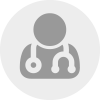
Dawn Winsor
This content is for informational purposes only, and is not intended to be a substitute for professional medical advice, diagnosis or treatment. Always seek the advice of your physician or other qualified healthcare professional with any questions you may have regarding a medical condition.
Differences in the Complexity of Office Visits by Physician Specialty: NAMCS 2013–2016
- Original Research
- Published: 10 March 2020
- Volume 35 , pages 1715–1720, ( 2020 )
Cite this article
- John D. Goodson M.D. ORCID: orcid.org/0000-0002-8847-1653 1 , 2 ,
- Sara Shahbazi Ph.D. 1 ,
- Karthik Rao M.D. 1 &
- Zirui Song M.D., Ph.D. 1 , 2
2111 Accesses
3 Citations
1 Altmetric
Explore all metrics
Specialty-to-specialty variation in use of outpatient evaluation and management service codes could lead to important differences in reimbursement among specialties.
To compare the complexity of visits to physicians whose incomes are largely dependent on evaluation and management services to the complexity of visits to physicians whose incomes are largely dependent on procedures.
Design, Setting, and Participants
We analyzed 53,670 established patient outpatient visits reported by physicians in the National Ambulatory Medical Care Survey (NAMCS) from 2013 to 2016. We defined high complexity visits as those with an above average number of diagnoses (> 2) and/or medications (> 3) listed We based our comparison on time intervals corresponding to typical outpatient evaluation and management times as defined by the Current Procedural Terminology Manual and specialty utilization of evaluation and management codes based on 2015 Medicare payments.
Main Outcome and Measures
Proportion of complex visits by specialty category.
Key Results
We found significant differences in the content of similar-length office visits provided by different specialties. For level 4 established outpatient visits (99214), the percentage involving high diagnostic complexity ranged from 62% for internal medicine, 52% for family medicine/general practice, and 41% for neurology (specialties whose incomes are largely dependent on evaluation and management codes), to 34% for dermatology, 42% for ophthalmology, and 25% for orthopedic surgery (specialties whose incomes are more dependent on procedure codes) ( p value of the difference < 0.001). High medication complexity was found in the following proportions of visits: internal medicine 56%, family medicine/general practice 49%, and neurology 43%, as compared with dermatology 33%, ophthalmology 30%, and orthopedic surgery 30% ( p value of the difference < 0.001).
Within the same duration visits, specialties whose incomes depend more on evaluation and management codes on average addressed more clinical issues and managed more medications than specialties whose incomes are more dependent on procedures.
Similar content being viewed by others

Prevalence and Nature of Medication Errors and Medication-Related Harm Following Discharge from Hospital to Community Settings: A Systematic Review
Fatema A. Alqenae, Douglas Steinke & Richard N. Keers

Revisiting the Time Needed to Provide Adult Primary Care
Justin Porter, Cynthia Boyd, … Neda Laiteerapong
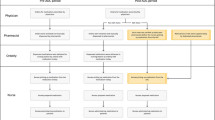
Reducing Medication Errors by Adopting Automatic Dispensing Cabinets in Critical Care Units
Hui-Ning Tu, Tzu-Hao Shan, … Ching-Lan Cheng
Avoid common mistakes on your manuscript.
Office visits are the most common service delivered in the US health care system. The existing evaluation and management (E/M) service codes were developed from a wide range of specialty-specific service codes used before the Medicare Physician Fee Schedule (MPFS). Prior to its inception of the MPFS in 1992, many specialties each had a repertoire of service codes, each with descriptors, that were tailored to capture the breadth, depth, and intensity of care specific to that specialty. 1 The collapse of all the outpatient codes for new and established patients to a total of ten—five for new patients and five for established patients—required all specialties to choose from a narrow set of options for billing purposes. This set, now almost 30 years old, may not adequately capture the nuances and full topology of cognitive work—particularly the critical thinking involved in data gathering and analysis, planning, management, decision making, and judgment in ambiguous or uncertain situations. 2 , 3 The numbers of clinical items addressed, medications managed, and co-morbidities considered have all increased. 4 When patients present for an office visit, the physician medical decision making (MDM)—the cognitive work—is more complex than it was 30 years ago. 5 , 6 , 7 , 8 , 9 If the E/M definitions are not updated to reflect the increasing complexity of cognitive work for the most intense levels of E/M care, payment distortions may become exacerbated, creating income disparities among specialties and leading to geographic maldistribution and inadequate access to lower-paid specialties. 10
We analyzed the National Ambulatory Medical Care Survey (NAMCS) data to determine if there are differences in the content of the services provided by different specialties over similar time intervals which would suggest that there is significant specialty-to-specialty variability in the use of the E/M codes. NAMCS questionnaires are sent to a nationally representative sample of practicing physicians each year by the Center for Disease Control (CDC). The instrument asks each respondent to provide patient-level data based on individual clinical encounters. It is designed to reflect the clinical experience of practitioners in both a quantitative and a qualitative manner. Physicians record what is clinically relevant for each encounter, independent of billing (service code selection) or risk adjustment (diagnoses associated with claim submissions). Each physician is asked to record their time with each patient encounter. Thus, the NAMCS database may be the most unbiased representation of the services delivered to patients by different specialties.
MATERIALS AND METHODS
We studied data from the 2013–2016 NAMCS, a nationally representative survey conducted by the National Center for Health Statistics (NCHS). The NAMCS collects data from all physicians listed by the American Medical Association (AMA) and the American Osteopathic Association (AOA) who provide office-based, direct patient care. Using a 3-stage sampling design, selected physicians are asked to complete surveys for individual patient encounters, resulting in a systematic random sample of office-based outpatient visits. 11 For each sampled visit, responding physicians report patient demographic information, up to five clinical diagnoses, all medications prescribed, the time spent with face-to-face clinical care, and the diagnostic, preventive, and therapeutic services provided.
Since NAMCS physician categorization does not crosswalk readily to the Centers for Medicare & Medicaid Services’ (CMS) specialty categories, we focused our analysis on visits to physicians who specialized in family medicine and general practice (FM/GP), internal medicine (IM), dermatology, neurology, ophthalmology, and orthopedic surgery, specialties that could be clearly distinguished within the NAMCS database and reliably cross-walked to the Medicare specialty designations. In addition, we restricted our analysis to established outpatient visits to compare the complexity of continuity care for the select specialty categories. Visits with only a nurse or medical assistant and no physician (1.83% of visits) were excluded, leaving a final analytical sample of 53,670 established office visits to the six specialties between 2013 and 2016.
We used 2015 Medicare Provider Utilization and Payment Data: Physician and Other Supplier Public Use File (Medicare PUF) to compare specialties’ income dependency on E/M and non-E/M procedures. 12 A list of the E/M services and corresponding Current Procedural Terminology (CPT) codes is attached in Appendix A .
Time spent with a physician is self-reported and defined as the amount of time in minutes that a physician spent with the patient, not including patient time spent waiting for an appointment or with another type of practitioner. 10 We matched physician-reported times with the typical times defined by CPT guidelines for the outpatient E/M codes. Typical times are conventions based on the average range of time it takes a physician to complete all face-to-face work, as defined by the 1995/1997 CMS guidelines, 13 , 14 for a visit at a specific service code level. For example, the office visit code 99213 assumes a typical time range up to 15 min, while a 99214 is assigned a typical time up to 25 min. We matched the physician time reported to outpatient E/M codes as follows: < 15 min (99211 and 99212), > 15–24 min (99213), > 25–39 min (99214), and > 40 min (99215). We did not categorize any visits in the 99211 range of 1–10 min since this code is not designed for physician use.
We considered two measures to represent visit complexity: the number of diagnoses listed and the number of medications prescribed. For the years included in our analysis (2013–2016), the NAMCS provided the option to record up to 5 clinical diagnoses at each visit using the International Classification of Diseases, Ninth Revision, Clinical Modification (ICD-9-CM) diagnostic codes and up to 30 medications ordered, supplied, administered, or continued per visit. Medications in the NMACS are broadly defined and include prescription and over-the-counter drugs. We chose the number of clinical diagnoses as a proxy for the number of issues actively considered simultaneously at a given visit. NAMCS questionnaires do not ask for billing diagnoses and therefore are less confounded by incentives for physicians to list billable clinically concurrent problems or to add financially beneficial diagnoses for risk adjustment. In this way, NAMCS diagnostic data represent what the physician sees as sufficiently active clinically to merit recording.
Prescription medications, our second measure of complexity, have demonstrated a robust relationship to visit complexity. 9 We only counted prescription medications since we were not certain whether over-the-counter (OTC) medications were consistently recorded and we could not determine whether the responding physician was personally recommending a given OTC medication or merely listing what the patient had chosen on their own. Prescription medications with two or more active ingredients were counted once. The proportions of combined medications prescribed across the selected groups of specialties were not statistically different ( p value < 0.001, calculated from comparison of means). For our analysis, complex visits are defined as those with over two diagnoses (the mean diagnoses per visit across all the NAMCS encounters for all specialties and/or those with over three prescription medications (the mean medications per visit)). The mean cutoff point was chosen based on previous studies on medication regimen complexity and patient care complexity. 15 , 16 , 17 , 18 Besides, results from sensitivity analysis using the median as the cutoff point to define level of complexity were consistent with the primary findings.
Statistical Analysis
We calculated total Medicare part B payments as well as payments for E/M and non-E/M services for the selected specialties in 2015. Next, we calculated and compared the percentage of total payments derived from E/M services across the specialties.
Descriptive analyses examined average visit complexity within each category of visit duration by physician specialty using 2013–2016 NAMCS data. Pearson chi-square tests for independence (categorical variables) or t tests for independent samples (continuous variables) were used to examine differences in characteristics of patients and visits seen by specialties whose income was largely dependent on E/M services and specialists whose income was largely dependent on procedural services. The independent two-sample t test was applied to compare the mean number of medications and diagnoses between the E/M dependent and the procedural-dependent groups of specialties for each visit time category. The proportion of the complex established patient office visits for each outpatient E/M service code time interval was calculated for each specialty for illustrative purposes. All analyses were performed using Stata version 15.1 (Stata Corporation, College Station, TX). All data were publicly available de-identified data, and thus exempt from review by the Institutional Review Board.
Figure 1 compares income dependency on E/M vs. non-E/M codes across the six specialties. For FM/GP, IM, and neurology specialties, E/M work makes up a larger percentage of their total part B payments as follows: FM/GP 70.5%, IM 75%, and neurology 51.3%. A larger percentage of income is derived from non-E/M services for ophthalmology (94.7%), dermatology (77.6%), and orthopedic surgery (77%).
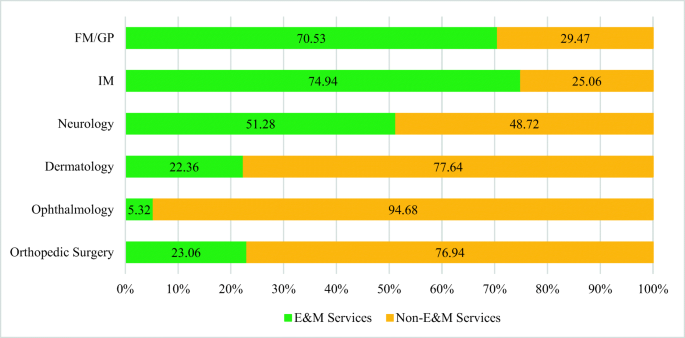
Shares of Medicare payments to providers for E&M and Non-E&M services by type of specialty, 2015. E&M services, evaluation and management services; FM/GP, family medicine and general practice; IM, internal medicine.
When patient characteristics are compared across the six specialties (Table 1 ), patients reported by the specialties with a higher dependency on E/M codes (FM/GP, IM, and neurology) were more likely to be current smokers (14.7% vs. 8.8%, p < 0.001), more likely to have a new problem (35.6% vs. 22.1%, p < 0.001), more likely to have 2 or more chronic conditions (28.9% vs. 13.8%, p < 0.001), more likely to be on 3 or more medications (49.1% vs. 29.1%, p < 0.001), and more likely to have two or more diagnoses (50.8% vs. 34.5%, p < 0.001) when compared with the patients reported by those specialties with a higher dependency on procedures (dermatology, ophthalmology, orthopedic surgery).
Figure 2 illustrates the differences in the percentages of high complexity visits for each outpatient E/M service code time by specialty. For example, for those visits where the time would correspond to a level 4 (99214) established outpatient, the percentages that were high visit diagnosis complexity were as follows: FM/GP, 52%; IM, 62%; neurology, 41%; dermatology, 34%; ophthalmology, 42%; orthopedic surgery, 25%. Similar figures for high medication complexity were as follows: FM/GP, 49%; IM, 56%; neurology, 43%; dermatology, 33%; ophthalmology, 30%; orthopedic surgery, 30%.
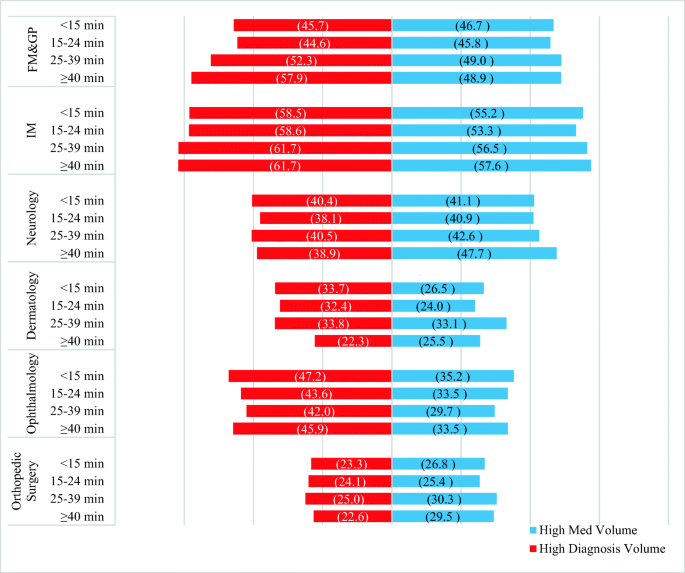
Percent distribution of complex visits, by time-based visit levels and type of specialty, 2013–2016. FM/GP, family medicine and general practice; IM, internal medicine. Complex visits are defined as those with over two diagnoses (the mean of diagnoses made per visit) and/or those with over three prescription medications (the mean of medications prescribed per visit).
When the six physician categories are split into two groups, those whose income is largely dependent on outpatient E/M work (FM/GP, IM, and neurology) and those whose income is largely dependent on procedures (dermatology, ophthalmology, orthopedic surgery), there are further differences across all visit time intervals (Table 2 ). For the time corresponding to a level 4 established outpatient (99214), the mean number of medications reported for those specialties whose compensation is largely E/M dependent was 4.65 (± 4.27) for each visit while the mean number of medications reported for those who are procedurally dependent was 2.99 (± 3.80). The mean ± SD of the number of medications and diagnoses, and p values, as the results of t test between the E/M-dependent and the procedural-dependent groups, are shown in Table 2 .
The pricing of physician services within the MPFS ripples through all payment models. 19 , 20 For traditional Medicare, the fee schedule directly determines physician compensation. For new models of care ranging from Advanced Payment Models (APMs) to the CPC+ payments, service code values determine payment calculations.
Virtually all the services in the MPFS are subject to change as medical and surgical practices change. When the times spent completing a range of procedures were compared with the times used by the AMA’s Relative Value Scale Update Committee (RUC) for pricing these procedures, inconsistencies were identified. 21 Some procedures were priced to take longer than what was observed while others were priced to take less time. Likewise, there have been repeated calls for reworking the definitions and valuations of the E/M codes based on the changes in clinical practice over the last several decades. 1 , 22 , 23 , 24 , 25 , 26 For the primary care physician, there are more ambitious goals for the treatment of prevalent conditions such as hypertension, diabetes, and hypercholesterolemia. In addition, there are new combination therapies for these conditions, each with more and more potential adverse interactions. This is in addition to the increased numbers of diagnostic tests, the aging demographic, the work burden imposed by Electronic Health Records (EHRs), and innovative interventions, such as the biomodulators, that confer new and higher risks.
CMS is responsible for accurate pricing within the MPFS. To fulfill this expectation, the fee schedule and its relative valuations must be continually updated to reflect actual practice. The imprecision of the times reported for the surgical codes illustrates how the codes have not been adjusted to reflect the changing nature of practice. 21 Importantly, the codes with underestimated time included cardiothoracic surgery, 21 a profession where there has been upward movement in the average age of patients undergoing surgery, with attendant increase in risks and challenges for the surgeon.
Likewise, our analysis of the NAMCS data would indicate that within similar visit times, there are important differences in how different specialties assess the intensity of their own work. The number of problems addressed and the number of medications managed were higher for the specialties of FM/GP, IM, and neurology in comparison with dermatology, ophthalmology, and orthopedic surgery. For example, when the intensity of care was compared across specialties for the time intervals that correspond to the level 4 (99214) established outpatient E/M code, 56% of IM visits had over 3 medications managed compared with 33% of dermatology visits. The corresponding comparison for greater than two diagnoses was 62% for IM and 34% for dermatology.
We note several limitations. First, the NAMCS data comprise voluntary responses by physicians. It may be that there is specialty-specific underreporting of either diagnoses or medications. However, this underreporting could be yet another indicator of decreased complexity within an encounter, and problems and medications not listed may indicate issues not addressed. Second, because NAMCS specialty designations do not consistently correspond to CMS specialty categories, we were forced to confine our selection of specialties to the six we could reliable identify in both the NAMCS and CMS databases. For example, the NAMCS category, cardiovascular disease, could include cardiologists, surgeons, or physiatrists specializing in cardiac rehabilitation. Third, there are shortcomings in the instrument itself. The number of diagnoses that can be listed per patient was capped at five, a critical restriction for those physicians, such as IM physicians, whose patients might have concurrent conditions well beyond five. Fourth, the report of time spent with patient care may not be comparable among the respondents. There were no direct observations to validate the times recorded. The time spent with face-to-face care for IM, FM/GP, and neurology likely underestimates the total time of an encounter since the post-visit time was not requested in the NAMCS questionnaire. Fifth, the request to list medications was not interpreted uniformly by respondents. Some respondents provided long lists including all over-the-counter medicines. Many listed only prescription medications (88.6%). Some listed vitamins, which may or may not have been medications. We counted combined medications only once but found no significant recording differences across the six specialties. Aspirin was a special case since the questionnaire did not ask whether this was physician directed or taken by patient choice. Sixth, there was no data on the billing code selected. The code selection itself is a proxy for visit “intensity” since either time spent with a patient or visit content can be used to support billing. However, the absence of the coding in the NCMCS data may be a hidden asset. In some specialties, the time actually spent in care would suggest specialty-specific patterns of overcoding. For example, 81.8% of dermatology visits and 68.2% of ophthalmology visits were below the level 3 threshold of 15 min suggesting that a larger portion of visits should be at level 2 (99212). Lastly, we assume that documentation practices are uniform across specialties. It may be that some there are specialty-to-specialty documentation habits that could skew any analysis based on recorded conditions or medications.
The last CMS guidelines for the outpatient E/M codes were issued in 1995 and revised in 1997. 13 , 14 The absence of any revisions over the last two decades may have created specialty-to-specialty variation in how these guidelines are interpreted. CMS efforts to improve the valuations of the E/M service codes must be coupled with a commitment to ensuring that service code selection within each specialty is appropriate with respect to the full range of patient care provided to all Medicare beneficiaries. In other words, there should be well-defined cross-specialty guidelines for the selection of the appropriate outpatient E/M service code level. Ideally, such revised guidelines would be based on a nationally representative sampling of actual day-to-day clinical practice. The importance of accurate valuations and definitions for physician services cannot be understated. The outpatient E/M codes cover the largest category of Medicare payment for professional services, roughly $27 billion annually and growing. For the workforce to meet national needs for primary care, specialty care, and procedural care, any inherent bias in the fee schedule or deficiencies in service code definition that lead physicians to choose the wrong service code could lead to long-term specialty-specific undercompensation or overcompensation, and ultimately system-wide workforce deficiencies. 10
NAMCS data suggest that there are important specialty-to-specialty variations in the complexity and intensity of outpatient E/M cognitive care provided within similar visit times. Our results imply that the distribution of outpatient E/M service codes should vary substantially among specialties. Some specialties, such as IM, FM/GP, and neurology, with higher numbers of conditions addressed and medications managed for all visit time intervals, should utilize higher codes more frequently, while other specialties, such as dermatology, ophthalmology, and orthopedic surgery, should utilize higher codes much less frequently.
Kumetz EA , Goodson JD . The Undervaluation of Evaluation and Management Professional Services: The Lasting Impact of Current Procedural Terminology Code Deficiencies on Physician Payment. Chest. 2013;144(3):740–745.
Article Google Scholar
Landon BE . A Step toward Protecting Payments for Primary Care. N Engl J Med . 2019;380(6):507–510.
Nakhasi A , Goodson J . The case for the redefinition and revaluation of the outpatient Evaluation and Management (E&M) service codes and the development of new documentation expectations. J Gen Intern Med. https://www.sgim.org/File%20Library/SGIM/Communities/Advocacy/LEAHP/SGIM-WP-July-2015-Goodson-E-M-paper%2D%2D2-final.pdf
Abbo ED , Zhang Q , Zelder M , et al. The increasing number of clinical items addressed during the time of adult primary care visits. J Gen Intern Med. 2008;23(12):2058–2065.
Katerndahl D , Wood R , Jaen CR . Complexity of ambulatory care across disciplines. Healthc (Amst) . 2015;3(2):89–96.
Horner RD , Matthews G , Yi MS . A conceptual model of physician work intensity: guidance for evaluating policies and practices to improve health care delivery. Med Care . 2012;50(8):654–661.
Katerndahl DA , Wood R , Jaen CR . A method for estimating relative complexity of ambulatory care. Ann Fam Med . 2010;8(4):341–347.
Horner RD , Szaflarski JP , Jacobson CJ , et al. Clinical work intensity among physician specialties: how might we assess it? What do we find? Med Care . 2011;49(1):108–113.
George J , Phun YT , Bailey MJ , Kong DC , Stewart K . Development and validation of the medication regimen complexity index. Ann Pharmacother . 2004;38(9):1369–1376.
Goodson JD , Song Z , Shahbazi S . Physician Payment Disparities and Access to Services—A Look Across Specialties. J Gen Intern Med. 2019. Accepted for publication.
National Center for Health Statistics. 2016 National Ambulatory Medical Care Survey (NAMCS) micro-data file documentation. Hyattsville, MD. .
Centers for Medicare & Medicaid Services. Medicare fee-for service provider utilization & payment data: Physician and other supplier public use file—A methodological overview Centers for Medicare & Medicaid Services. https://www.cms.gov/Research-Statistics-Data-and-Systems/Statistics-Trends-and-Reports/Medicare-Provider-Charge-Data/Downloads/Medicare-Physician-and-Other-Supplier-PUF-Methodology.pdf . Accessed March 10, 2019.
Centers for Medicare & Medicaid Services. 1995 documentation guidelines for evaluation and management services. http://www.cms.gov/Outreach-and-Education/Medicare-Learning-Network MLN/MLNEdWebGuide/Downloads/95Docguidelines.pdf. Accessed April 20, 2019.
Centers for Medicare & Medicaid Services. 1997 documentation guidelines for evaluation and management services. http://www.cms.gov/Outreach-and-Education/Medicare-Learning-Network-MLN/MLNEdWebGuide/Downloads/97Docguidelines.pdf . Accessed April 15, 2019.
Muir AJ , Sanders LL , Wilkinson WE , Schmader K . Reducing medication regimen complexity: a controlled trial. J Gen Intern Med. 2001;16(2):77–82.
Article CAS Google Scholar
Linnebur, SA , Vande Griend, J , Metz, K . Patient-level medication regimen complexity in older adults with depression. Clin Ther. 2014; 36(11): 1538–1546.
Libby AM , Fish DN , Hosokawa PW , et al. Patient-level medication regimen complexity across populations with chronic disease. Clin Ther . 2013; 35 :385–398.e1. https://doi.org/10.1016/j.clinthera.2013.02.019 .
Bazargan M , Smith J , Yazdanshenas H , Movassaghi M , Martins D , Orum G . Non-adherence to medication regimens among older African-American adults. BMC Geriatrics. 2017;17(1):163.
Berenson RA , Goodson JD . Finding Value in Unexpected Places--Fixing the Medicare Physician Fee Schedule. N Engl J Med. 2016;374(14):1306–1309.
Berenson RA , Ginsburg PB . Improving The Medicare Physician Fee Schedule: Make It Part Of Value-Based Payment. Health Aff (Millwood) . 2019;38(2):246–252.
Chan DC , Huynh J , Studdert DM . Accuracy of Valuations of Surgical Procedures in the Medicare Fee Schedule. N Engl J Med. 2019;380(16):1546–1554.
McCall N , Cromwell J , Braun P . Validation of physician survey estimates of surgical time using operating room logs. Med Care Res Rev . 2006;63(6):764–777.
Goodson JD . Unintended consequences of resource-based relative value scale reimbursement. JAMA . 2007;298(19):2308–2310.
Berenson RA , Basch P , Sussex A . Revisiting E&M visit guidelines--a missing piece of payment reform. N Engl J Med . 2011;364(20):1892–1895.
Schroeder SA , Frist W . Phasing out fee-for-service payment. N Engl J Med. 2013;368(21):2029–2032.
Katz S , Melmed G . How Relative Value Units Undervalue the Cognitive Physician Visit: A Focus on Inflammatory Bowel Disease. Gastroenterol Hepatol (N Y). 2016;12(4):240–244.
Google Scholar
Download references
Supported by a grant from the Office of the Director, National Institutes of Health (NIH Director’s Early Independence Award, 1DP5OD024564, to Dr. Song)
Author information
Authors and affiliations.
Wang 625, Massachusetts General Hospital, 15 Fruit St, Boston, MA, 02114, USA
John D. Goodson M.D., Sara Shahbazi Ph.D., Karthik Rao M.D. & Zirui Song M.D., Ph.D.
Harvard Medical School, Boston, MA, USA
John D. Goodson M.D. & Zirui Song M.D., Ph.D.
You can also search for this author in PubMed Google Scholar
Corresponding author
Correspondence to John D. Goodson M.D. .
Ethics declarations
Conflict of interest.
The authors declare that they do not have a conflict of interest.
Additional information
Publisher’s note.
Springer Nature remains neutral with regard to jurisdictional claims in published maps and institutional affiliations.
Electronic supplementary material
(DOCX 23.1 kb)
Rights and permissions
Reprints and permissions
About this article
Goodson, J.D., Shahbazi, S., Rao, K. et al. Differences in the Complexity of Office Visits by Physician Specialty: NAMCS 2013–2016. J GEN INTERN MED 35 , 1715–1720 (2020). https://doi.org/10.1007/s11606-019-05624-0
Download citation
Received : 22 August 2019
Revised : 04 November 2019
Accepted : 13 December 2019
Published : 10 March 2020
Issue Date : June 2020
DOI : https://doi.org/10.1007/s11606-019-05624-0
Share this article
Anyone you share the following link with will be able to read this content:
Sorry, a shareable link is not currently available for this article.
Provided by the Springer Nature SharedIt content-sharing initiative
- evaluation and management services
- outpatient visit complexity
- duration of visit
- Find a journal
- Publish with us
- Track your research
- Find a Doctor
- Conditions & Services
- Patients & Visitors
Complex Care Clinic
At Summa Health, we take a special approach to patients with the most complex needs.
- What is Complex Care
How Our Care is Different
- Patient Care Stories
What is Complex Care?
Complex care is a person-centered approach to address the needs of people who experience combinations of medical, behavioral health and social challenges that result in extreme patterns of healthcare utilization and cost. Complex care works to eliminate gaps in healthcare by delivering integrated services for people whose healthcare needs extend beyond the traditional boundaries. The goal for these complicated cases is to live the healthiest life possible. By better addressing complex needs, complex care can reduce utilization of expensive acute services and make the healthcare system easier for patients to navigate.

Since these identified patients have not historically fared well in a traditional healthcare delivery model, we have enrolled them with our team to receive intense multidisciplinary primary care and care management services. Our patients experience high-touch care that includes
- telephonic,
- virtual and office visits to help address chronic disease management,
- social determinates of health,
- and behavioral health concerns that often impede their journey to wellness.
As part of this high-touch care, our team works with healthcare partners outside of our system to facilitate easy transitions to different levels of care and promote continuity of care. We feel patients thrive when we work collaboratively with our community partners and agencies.

Featured Patient Care Story
Stacie Camp's Story:
Stacie feels valued and has a better quality of life after receiving care in the Complex Care Clinic.
How much will this cost?
Receive an estimate on how much you may have to pay using our pricing transparency tool.
Options to Request an Appointment
If your situation is an emergency, call 911..
Things to do in Moscow: how to visit Moscow | Unmissable, cool & unusual
- September 2, 2023
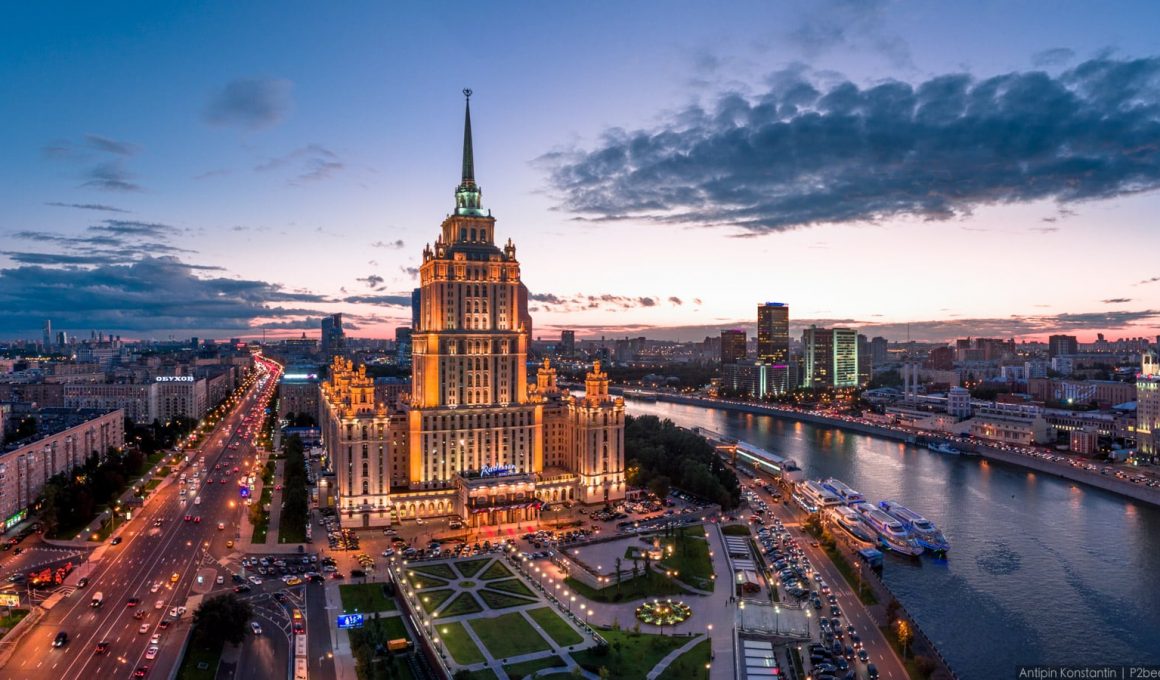
What are the best things to do in Moscow? What to do in Moscow? First, I will list the main places to visit by theme, passing by the must-sees, but also more unusual places in Moscow. Then, I will describe what to see in Moscow in one day and how to visit Moscow in 2, 3, 4, 5 or 6 days. Let’s go!
Good to know. For more information, click on the places to open the dedicated blog posts.
Main places to visit in Moscow & best things to do in Moscow
I worked in Moscow and I loved this city for its dynamism and energy. We find there from time to time to see friends, remember good memories and enjoy this giant city! Then the time has come for us to share with you our practical guide.
TOP 5 must-see places in Moscow
- Moscow Red Square
- St. Basil’s Cathedral
- Cathedral of Christ the Savior
- Bolshoi Theatre
Places of cultural, historical and religious interest in Moscow
- Novodevichy Convent and cemetery
- Tretyakov Gallery
- Pushkin Museum of Fine Arts
- Kremlin Izmaïlovo (pseudo-historic place, recently built in the image of the old, one of the best things to do in Moscow for your Instagram account 😉 )
- Park and ancient village of Kolomenskoye
Visit Moscow of the Soviet era
- Moscow State University and Sparrows Hill
- VDNKh and the Museum of Astronautics, one of the key landmarks of the Soviet era in Moscow
- GULAG Museum
- Metro stations
- The Stalinist skyscrapers, scattered all over the city
Less touristy places in Moscow
- Gorky Park and the GARAGE museum
- The old Krasny Oktyabr factory
- Zaryadye Park
- Center for Contemporary Art, WINZAVOD
- Business center, Moscow City
Main districts of Moscow to visit
- Patriarch Ponds
- Tchistye Prudy
- Kuznetsky most
- Arbat Street
However, regardless of the length of your stay, whether you are going to visit Moscow in 4 days or in 2, you need a visa. The article Obtaining a tourist visa for Russia could then be useful in any case.
What to do and see in Moscow in one day?
List of things to see and do in Moscow in one day:
- Go to Red Square
- Visit St. Basil’s Cathedral
- See Kremlin walls (but not to visit)
- Visit Cathedral of Christ the Savior
- Discover Kuznetsky most districts and see Bolshoi Theatre building
- And if you have time at the end of the day: go to the Sparrows Hill or to the Moscow City for a beautiful view
Things to do in Moscow in 2 days
If you want to visit Moscow in 2 days, there are 2 purposes: do not miss the essential places of Moscow and optimize travel.
- First day: Red Square , Saint Basil’s Cathedral , Zariadye Park, Bolshoi Theatre , Kremlin
- Day 2: Cathedral of Christ the Savior, the former Krasny Oktyabr factory on Balchug Island, Gorky Park, Moscow State University (one of the Seven Sisters buildings ) and Sparrow Hill
As 2 days os really short, be sure to choose an accommodation in the best districts where to stay in Moscow .
Walking on Red Square in Moscow: one of the unmissable things to do in Moscow
Iconic place and one of the must-see places in Moscow and even in Russia! Besides, if there was only one place to visit in Moscow in 2 days, this place would then be Red Square, without hesitation. Therefore, starting the city tour with Red Square is ideal . Several buildings are on the square, but not all of them have to be visited. Check out my blog post about Moscow’s Red Square in detail to learn more and not miss anything.
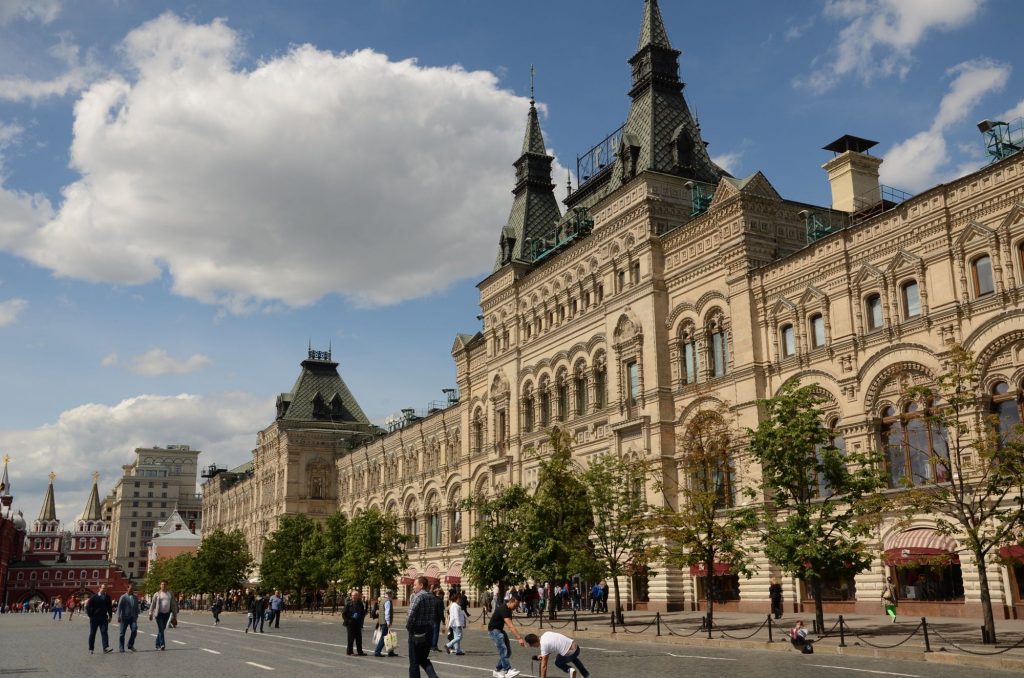
Visiting Saint-Basil’s Cathedral inside
Even more emblematic than Moscow’s Red Square! Built in the middle of the 16th century under the orders of Tsar Ivan Le Terrible, this cathedral is one of the most beautiful monuments of Orthodox art, and definitely one of the unmissable places in Moscow. Visiting Saint-Basil’s Cathedral inside is one of the most beautiful things to do in Moscow!
- Visit estimate time : 1h30
- Entry ticket : 700 RUB. Tickets can be purchased on the cathedral’s official website 45 days before the tour.
- Audio guide (recommended): 500 RUB
- Opening hours : June to August 10 am-6pm; from November to April: 11 am-5pm; May, September, October 11 am-5pm. Cathedral closed on Wednesdays. Entrance is closed 45 minutes before closing.
- Find out more in the dedicated article: Saint Basil’s Cathedral in Moscow
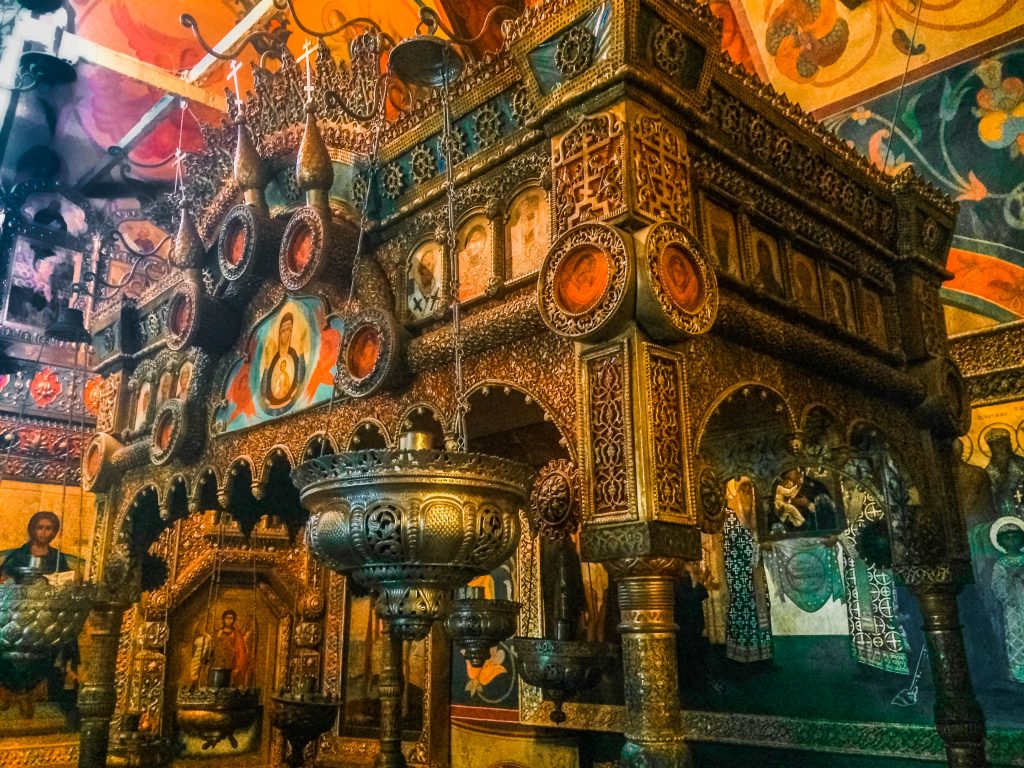
Take a walk in Zariadye park: one of the coolest things to do in Moscow after visiting Red Square
Zaryadie Park is just a 10-minute walk from St. Basil’s Cathedral, so it’s easy to include in your itinerary if you’re going to visit Moscow in 2 days. From its heights, you can see the red walls of the Kremlin. But, the most impressive point of view is the platform which overlooks the Moskva river. A must see! And clearly one of the coolest things to do in Moscow!
- Open 24 hours a day
- Good to know! Park Zaryadye is also a place to visit in Moscow in winter. Find out more here: What to do in Moscow in winter?
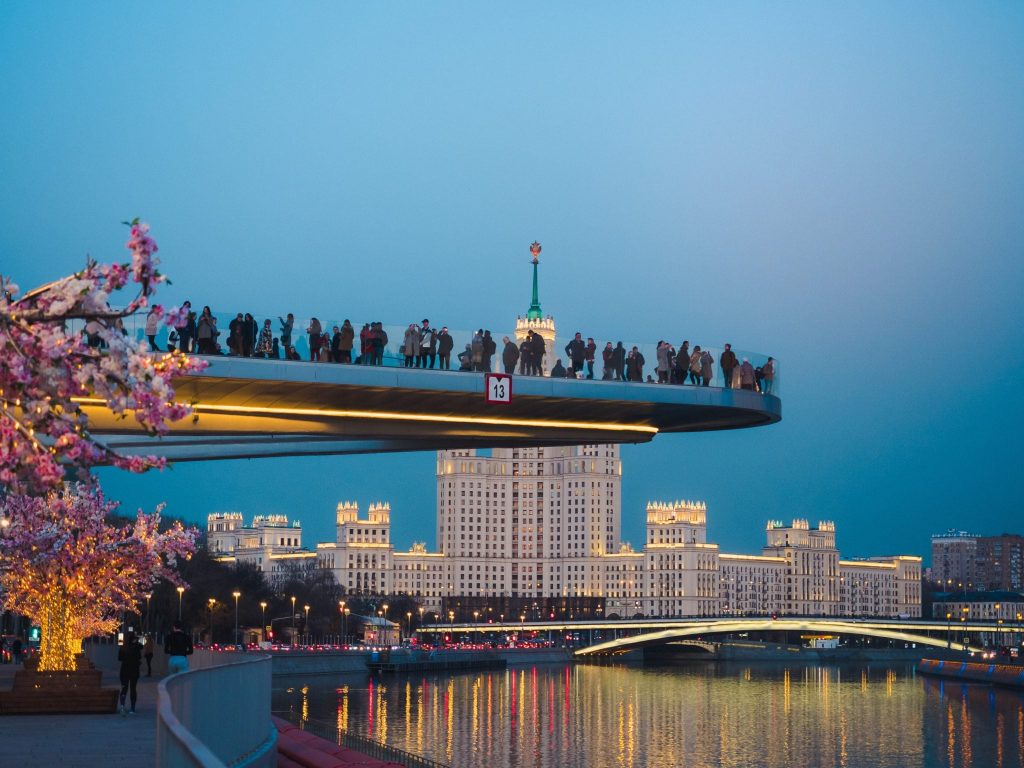
See the Bolshoi Theatre and discover the Kuznetsky Most district
The Bolshoi Theatre is the most famous Russian theater in the world. The most economical way to see a presentation at the Bolshoi Theater is to take the tickets on the theater’s official website in advance, so here is our tutorial to help you: How to buy entrance tickets to the Bolshoi? In addition, several pedestrian or one-way streets
The Bolshoi Theater is the most famous Russian theater in the world. The most economical way to see a presentation at the Bolshoi Theater is to take the tickets on the theater’s official website in advance, so here is our tutorial to help you: How to buy tickets to the Bolshoi? In addition, several pedestrian or one-way streets are located north of the theater. It is therefore very pleasant to find them to leave the main axes of the megalopolis.
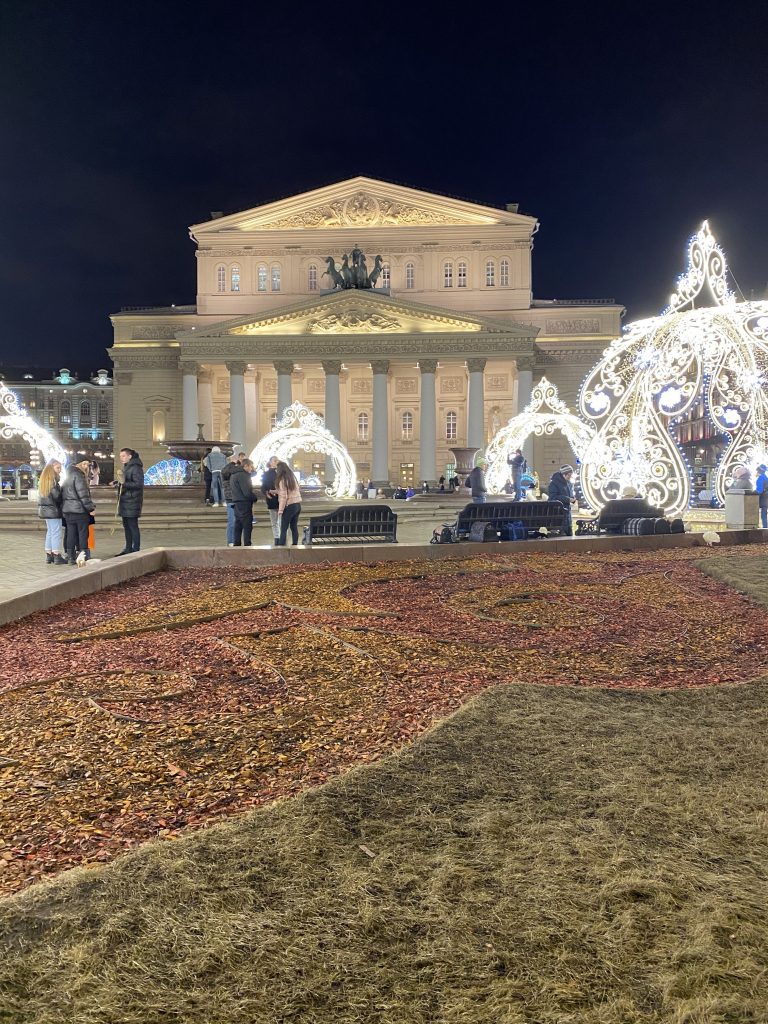
Visit the Moscow Kremlin
Visit Kremlin is on top of things to do in Moscow. A place of power for centuries, the Kremlin then shows us a whole different image when viewed from the inside. If you want to visit Moscow in 2 days, the Kremlin is certainly one of the must-see places in Moscow.
- Opening hours : Daily from 10 a.m. to 5 p.m., except Thursday.
- See our blog post about visiting the Moscow Kremlin
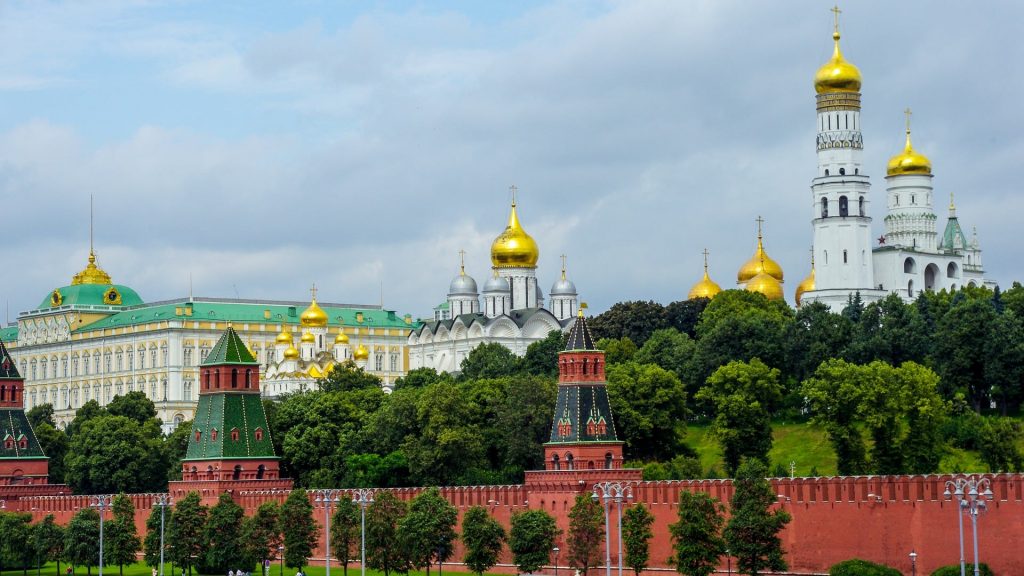
Visit the Cathedral of Christ the Savior
This impressive Moscow Cathedral is the seat of the Russian Orthodox Church. It is a must see if you visit Moscow in 2 days and clearly one of the things to do in Moscow. The Cathedral of Christ the Savior was first built in 1883 in memory of Russia’s victory over Napoleon’s Grand Army. Then in 1931 Stalin ordered its destruction. It was then rebuilt again (identically) only in 2000.
- Where? Ulitsa Volkhonka 15. At the foot of the Kropotkinskaya metro station.
- Opening hours . Daily: 10: 00-17: 00, except Monday: 13: 00-17: 00
- Free entry (some closing restrictions, for example a short)
Good to know! In orthodox religious places, one must avoid excessively uncovered clothing. Women should cover their heads. After visiting the Cathedral of Christ the Savior, you can explore Bolotny Island and Gorky Park. This is one of the routes our guide to Moscow.

The old Krasny Oktyabr factory: one of the coolest things to do in Moscow
If you cross the Moskva River by a pedestrian bridge which is located just in front of the Cathedral of Christ the Savior, you will enjoy a beautiful view of the city and at the same time you can discover Balchug Island. Furthermore, if you want to visit Moscow in 2 days, you can include this island in your itinerary between the cathedral and Gorky park. Here is the old confectionery factory Krasny Oktyabr, which has gradually turned into a fashionable micro-district. There are then some elements of street art, cafes and restaurants and some Moscow bohemian side. At the end of the island you can see a gigantic 98-meter-high monument dedicated to the Russian reforming tsar Pierre The Great.
Good to know! You can find on this island are the trendiest nightclubs in Moscow. On weekends, there are taxi caps after midnight so there are so many people. On the other hand, if you go there in winter and during the day, the island is quite empty and less interesting to see.
Gorky Park is one of the TOP places to visit in Moscow, because it allows you to better understand the life of the locals and their rhythm. In fact, it’s a huge entertainment park. For example, in winter there is a giant ice rink and in summer – free dance or yoga lessons, sandy beaches for playing volleyball, an outdoor cinema. So, like the locals, have a Stakantchik (ice cream or cooked corn), and enjoy the atmosphere of the place: that’s one of the interesting things to do in Moscow to discover the city.
- Where? Krymsky Val 9. 20 minutes’ walk from Krasny Oktyabr, along the quays.
Sparrow Hill and Moscow State University
The Sparrow Hill, Vorobiovy Gori in Russian, is the highest point in Moscow. It is rather known to Russians, but less to travelers. A nice view on Moscow opens from the hill, and in particular on the Luzhniki Stadium. In addition, on the hill itself is the Moscow State University: an impressive skyscraper from the Soviet era.
- How to get there? By bus T7 (35 min) from Oktyaborskaya station, near Gorki Park. By metro (Vorobiovy Gorki station) + climb the hill on foot. On foot along the Moskva along the Gorky Park (1h30) + climb in funiculars.
Good to know! It is possible to cross the Moskva river by funicular. We actually tested it and it was pretty cool! That is one of our favorite things to do in Moscow!
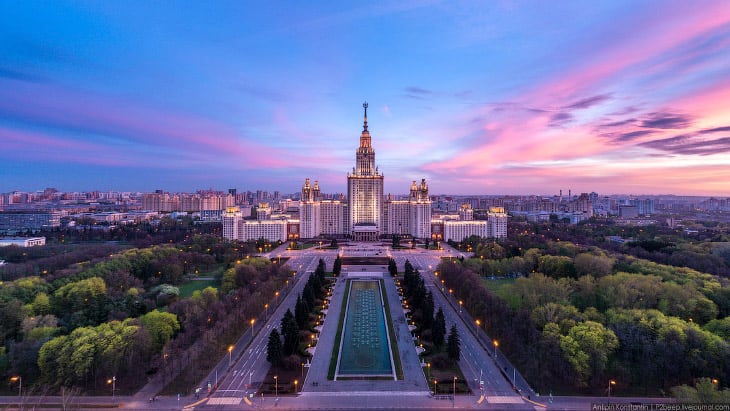
What to do in Moscow in 3 days?
If you are going to visit Moscow in 3 days, it would be interesting to dive into the Soviet era which strongly marked the country and the city. After the Bolshevik Revolution, the capital was transferred from Saint Petersburg to Moscow, in order to mark the change of power. Moscow then became the world showcase for communist ideology. Here are the best things to do in Moscow for 3-day-trip!
VDNKh, visit Moscow of the Soviet era
VDNKh is a large exhibition center in the north of Moscow, where there are still several striking witnesses of the USSR. The most interesting are the Museum of Cosmonauts and the Statue of the Worker and the Kolkhozian , which will certainly impress you with its size!
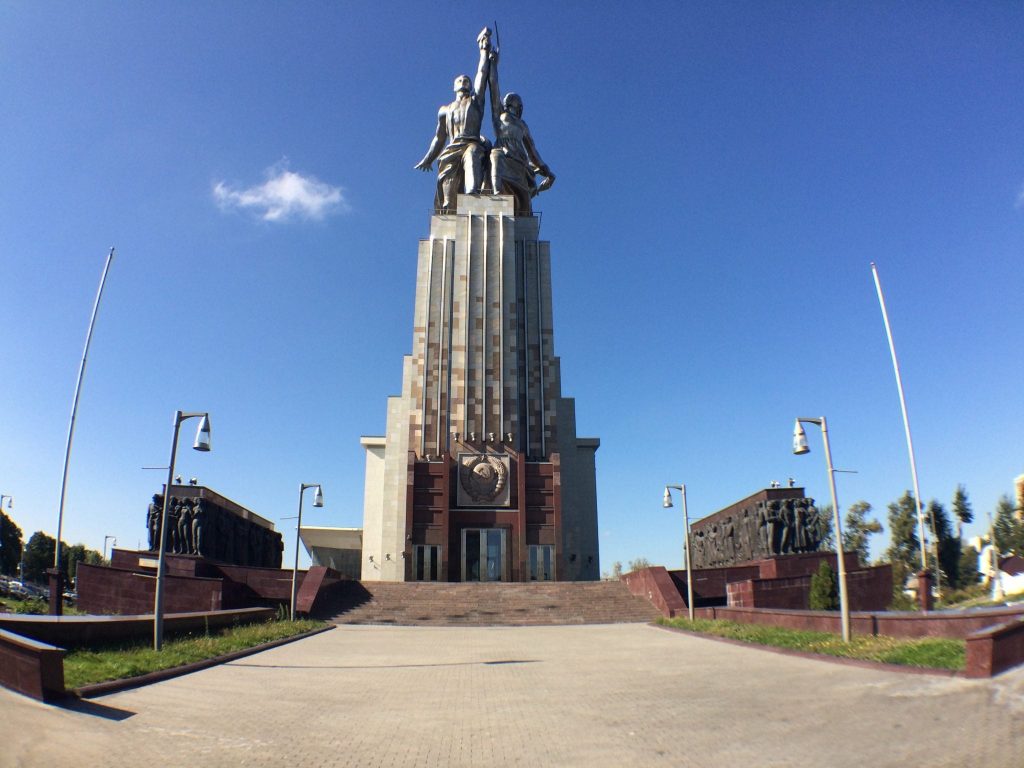
GULAG History Museum
The explanations of the museum are very well done. We really have the feeling of going back in time. If you are going to visit Moscow in 3 days and you are interested in history and this subject in particular, I recommend this museum. Visit the GULAG History Museum is one of the most interesting things to do in Moscow.

Discover the Patriarche Pounds district
It’s a nice neighborhood in Moscow where you can come across rather affluent locals, but not necessarily very bling-bling. Take a walk in this area is really a cool thing to do in Moscow! In addition, the Ponds of Patriarch is one of the places of Bulgakov’s novel “Master and Margarita”. As this is an interesting area to see, we have included it in a walking tour of Moscow. The route ends at the Moscow Kremlin, which is very convenient, because you will be able to visit Moscow in 3 days by optimizing your trips.

What to visit in Moscow in 4 days: TOP things to do in Moscow in 4 days
If you want to visit Moscow in 3 days, you will already see a lot of things. On the other hand, if you stay one more day, you have plenty to do! The Novodevichy Convent, the Tchistie Proudy district and the Izmaylovo Kremlin are very good candidates for you, if you are going to visit Moscow in 4 days.
Visiting Novodevichy Convent in Moscow
The Novodevichy Convent is one of the most brilliant examples of Russian architecture, according to UNESCO. This beautiful complex was built in 1524 and today consists of the convent, but also of a cemetery whose status could be compared to that of Père-Lachaise in Paris. Visiting Novodevichy Convent is one of the great things to do in Moscow, if you want to go a little bit outside of the center!
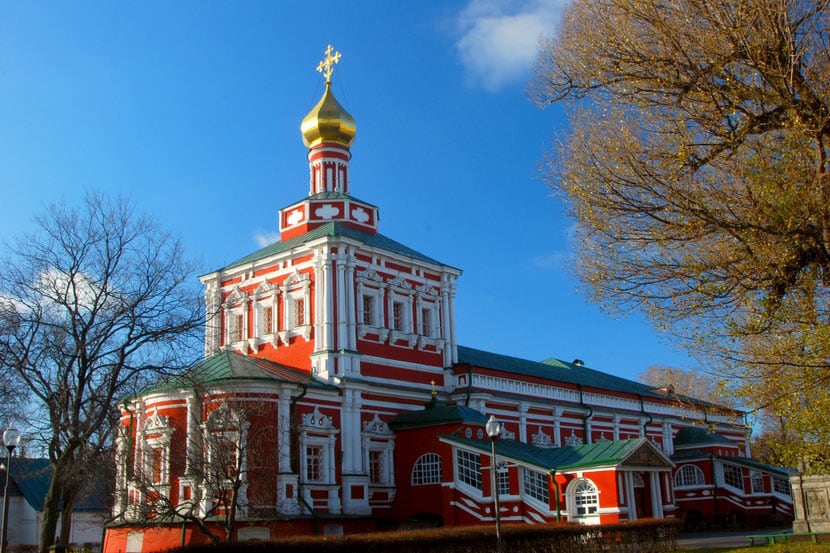
Discovering Tchistye Proudy district
It’s one of the most popular areas of Moscow, with many cafes, restaurants and bars nearby. It is therefore a place to discover if you want to visit Moscow in 4 days. It is just as pleasant for a stroll as for the discovery of local life. For example, in winter the pond turns into an ice rink.
Visiting the Izmaylovo Kremlin, one of the coolest things to do in Moscow!
The Izmaylovo Kremlin is more of a tourist than a historic place. On the other hand, it is a pretty impressive place to discover, especially on weekends. Inside the Kremlin, there is a flea market where you can find a little bit of everything, but mostly good souvenirs to bring from Moscow. For example, chapka, traditional Russian scarves or matryoshka (Russian dolls). Add the Kremlin and the Izmaïlovo market to your itinerary if you are going to visit Moscow in 4 days, because it is a nice and very colorful place! Visiting the Izmailovo Kremlin is one of the things to do in Moscow, if you want to put colors in your Instagram account! 😉

In 4 days, we will have the opportunity to see several Moscow: Classic Moscow, Moscow of old Russia, Soviet Moscow and a little bit of the new Moscow. So what to visit in Moscow on the 5th day of travel?
What to visit in Moscow in 5 days?
Art lovers will be delighted to discover the Tretyakov Gallery and the Pushkin Museum of Fine Arts, while others will prefer to stroll along Arbat Street, see the buildings of Moskva-City or visit Bunker 42.
Admiring Russian art at Tretyakov Gallery
Founded in 1856 by an industrialist and great lover of art, the gallery has grown over the decades, and then bequeathed to the state. Today the collection includes more than 140,000 pieces, 15,000 of which are paintings. Visiting the Tretyakov Gallery is one of the things to do in Moscow if you want to discover Russian art!
- Where? Pereoulok Lavrouchinski 10. A 5-minute walk from Tretiakovskaya station
- Opening hours. Open from 10 a.m. to 6 p.m. until 9 p.m. Thursday and Friday. Closed on Mondays.
- Entry tickets. 500 RUB.
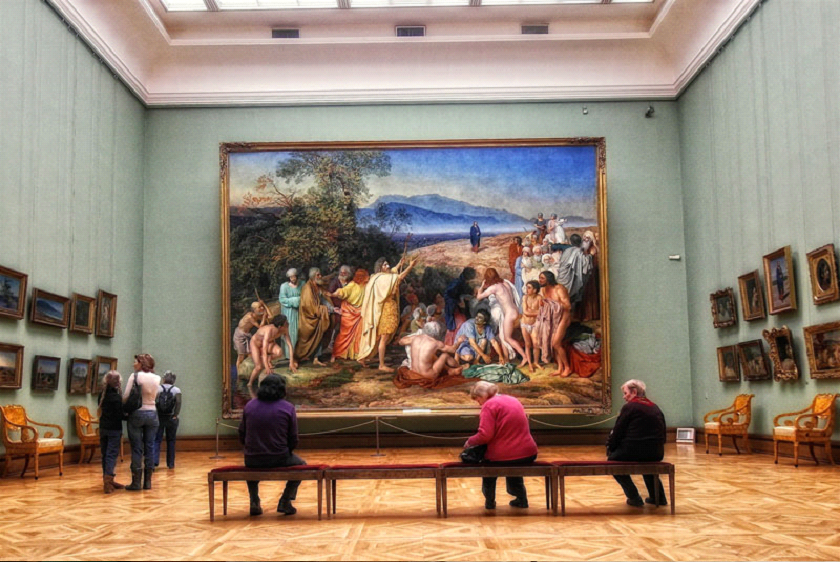
Visiting the Pushkin Museum of Fine Arts
The Pushkin Museum of Fine Arts presents the treasures of ancient Egypt, the paintings of Rembrandt and Cézanne, a fine collection of Impressionism.
- Where? Ulitsa Volkhonka 12
- Opening hours. Daily: 10: 00-20: 00, except Thursday: 11: 00-21: 00. Closed on Mondays. The boxes close an hour before closing.
- Entry tickets. The prices vary according to the collections from 300 to 750 RUB.
Walking on Arbat Street
All Russians know Rue Arbat. So, walking on Arbat street is one of the things to do in Moscow. However, after the years, little by little it became very touristy. This is a pedestrian street only. There are souvenir shops, restaurants and cafes there, but it is no longer the most authentic neighborhood in the city.
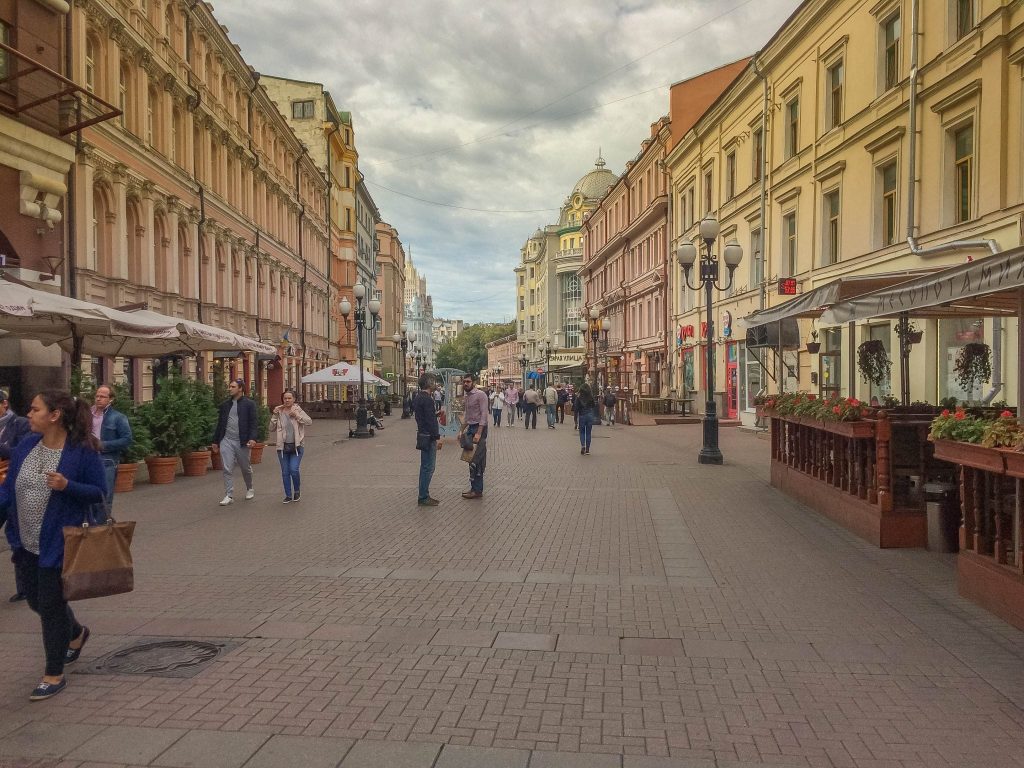
Seeing the buildings of Moskva-City (Moscow City)
Moskva-City is Moscow’s business center, much like Paris’s Defense district. The skyscrapers of Moskva-City are among the tallest in Europe: 373 meters high! Very nice place to see at dusk.
Good to know! You can admire a nice view of Moscow City from the docks of Tarasa Shevchenko. It’s especially beautiful in the evening with all the lights on.
Bunker 42, one of the most unusual things to do in Moscow
Bunker 42 is a secret military complex which was to be used by the Soviets in the event of a nuclear attack: a space of 7000 m² 65 meters underground!
- Where? 5 Kotelnitcheski Lane, 11.
- Prices. 2200 RUB per person
- Opening hours. Open daily from 10 a.m. to 8 p.m.
- Restaurant inside. Original, but rather a tourist trap.
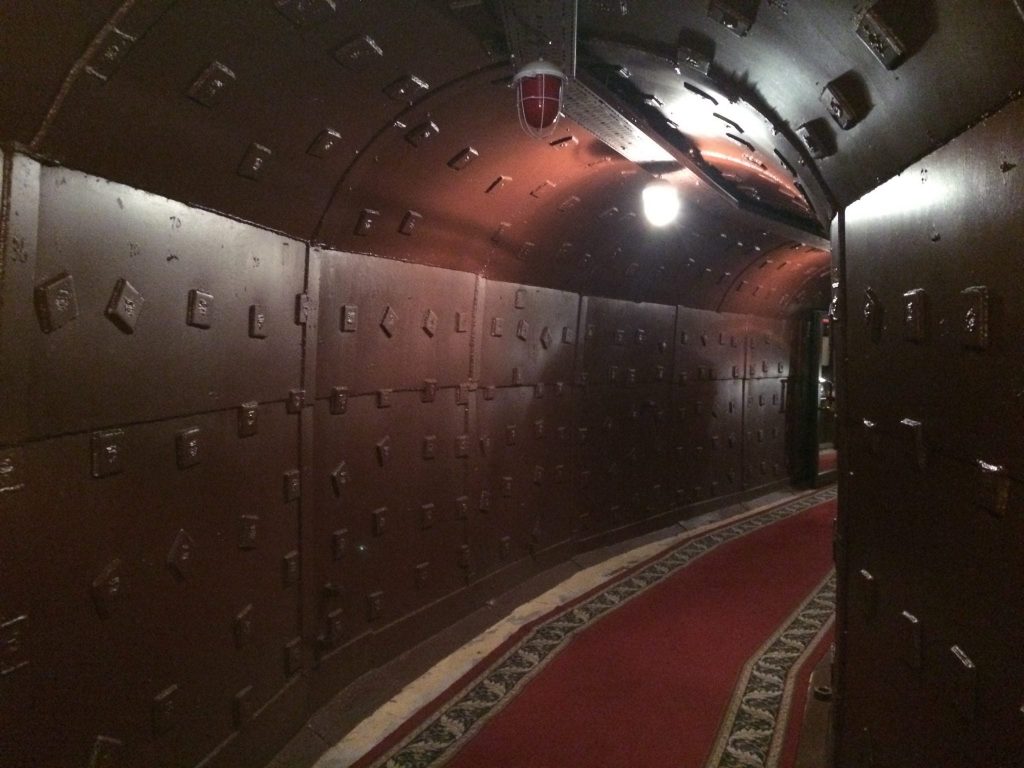
What to visit in Moscow in 6 days or more?
There are still so many places to see, because Moscow is a big megalopolis and there is always something exciting to do there. For example: the ancient Kolomenskoye village or the WINZAVOD contemporary art center .
If you are interested in history and want to see Russian cities on a rather “human scale”, it would certainly be interesting for you to discover the cities of the Golden Ring . For example, it is very easy to get to Sergey Posad from Moscow (less than 2 hours in train). Visiting the Golden Ring is one of the best things to do in Moscow if you are staying more than a 5-6 days.
There are still plenty of places to see in Moscow, however I did my best to list here the best things to do in Moscow, what to see in Moscow in one day, but also in 2, 3, 4 or 5 days in Moscow!
Moscow travel tips:
- Airport transfer: how to go to Moscow?
- Where to stay in Moscow (hotels, districts)?
- Tourist voucher for Russian visa
- Christmas and New Year in Moscow
- What is the best time to visit Moscow?
Leave a Reply Cancel reply
Your email address will not be published. Required fields are marked *
Save my name, email, and website in this browser for the next time I comment.
Novodevichy Convent and cemetery in Moscow: tickets, cemetery map
Hermitage museum in saint petersburg: tickets, best time to visit, you may also like.
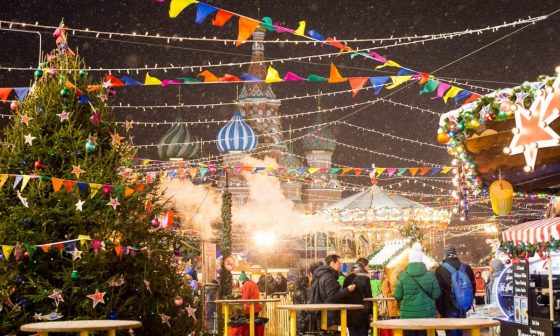
Moscow in winter | What to do in Moscow in winter? How to dress?
- October 1, 2023
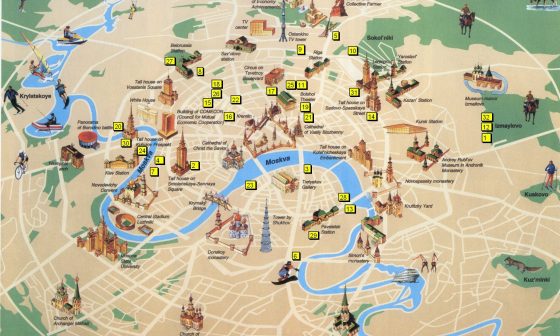
Free Moscow map in English: Moscow metro map and city centre map
- December 12, 2023

- August 26, 2023

Moscow transport: metro, bus & taxi in Moscow | How does it work?
- August 15, 2023
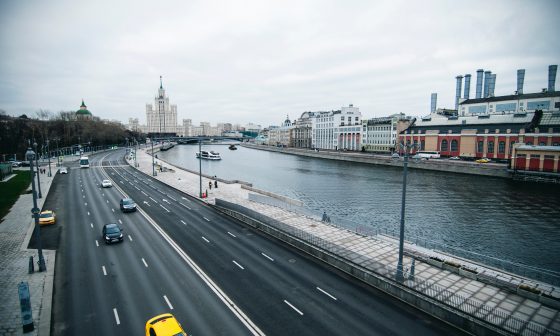
Weekend in Moscow | What to do in Moscow for a long weekend?
- June 22, 2023

Christmas and New Year in Moscow: best markets and decorations to see
- September 18, 2023
- ALL MOSCOW TOURS
- Getting Russian Visa
- Top 10 Reasons To Go
- Things To Do In Moscow
- Sheremetyevo Airport
- Domodedovo Airport
- Vnukovo Airport
- Airports Transfer
- Layover in Moscow
- Best Moscow Hotels
- Best Moscow Hostels
- Art in Moscow
- Moscow Theatres
- Moscow Parks
- Free Attractions
- Walking Routes
- Sports in Moscow
- Shopping in Moscow
- The Moscow Metro
- Moscow Public Transport
- Taxi in Moscow
- Driving in Moscow
- Moscow Maps & Traffic
- Facts about Moscow – City Factsheet
- Expat Communities
- Groceries in Moscow
- Healthcare in Moscow
- Blogs about Moscow
- Flat Rentals
Healthcare in Moscow – Personal and Family Medicine
Emergency : 112 or 103
Obstetric & gynecologic : +7 495 620-41-70
About medical services in Moscow

Moscow polyclinic
Emergency medical care is provided free to all foreign nationals in case of life-threatening conditions that require immediate medical treatment. You will be given first aid and emergency surgery when necessary in all public health care facilities. Any further treatment will be free only to people with a Compulsory Medical Insurance, or you will need to pay for medical services. Public health care is provided in federal and local care facilities. These include 1. Urban polyclinics with specialists in different areas that offer general medical care. 2. Ambulatory and hospitals that provide a full range of services, including emergency care. 3. Emergency stations opened 24 hours a day, can be visited in a case of a non-life-threatening injury. It is often hard to find English-speaking staff in state facilities, except the largest city hospitals, so you will need a Russian-speaking interpreter to accompany your visit to a free doctor or hospital. If medical assistance is required, the insurance company should be contacted before visiting a medical facility for treatment, except emergency cases. Make sure that you have enough money to pay any necessary fees that may be charged.
Insurance in Russia

Travelers need to arrange private travel insurance before the journey. You would need the insurance when applying for the Russian visa. If you arrange the insurance outside Russia, it is important to make sure the insurer is licensed in Russia. Only licensed companies may be accepted under Russian law. Holders of a temporary residence permit or permanent residence permit (valid for three and five years respectively) should apply for «Compulsory Medical Policy». It covers state healthcare only. An employer usually deals with this. The issued health card is shown whenever medical attention is required. Compulsory Medical Policyholders can get basic health care, such as emergencies, consultations with doctors, necessary scans and tests free. For more complex healthcare every person (both Russian and foreign nationals) must pay extra, or take out additional medical insurance. Clearly, you will have to be prepared to wait in a queue to see a specialist in a public health care facility (Compulsory Medical Policyholders can set an appointment using EMIAS site or ATM). In case you are a UK citizen, free, limited medical treatment in state hospitals will be provided as a part of a reciprocal agreement between Russia and UK.
Some of the major Russian insurance companies are:
Ingosstrakh , Allianz , Reso , Sogaz , AlfaStrakhovanie . We recommend to avoid Rosgosstrakh company due to high volume of denials.
Moscow pharmacies

A.v.e pharmacy in Moscow
Pharmacies can be found in many places around the city, many of them work 24 hours a day. Pharmaceutical kiosks operate in almost every big supermarket. However, only few have English-speaking staff, so it is advised that you know the generic (chemical) name of the medicines you think you are going to need. Many medications can be purchased here over the counter that would only be available by prescription in your home country.
Dental care in Moscow

Dentamix clinic in Moscow
Dental care is usually paid separately by both Russian and expatriate patients, and fees are often quite high. Dentists are well trained and educated. In most places, dental care is available 24 hours a day.
Moscow clinics

«OAO Medicina» clinic
It is standard practice for expats to visit private clinics and hospitals for check-ups, routine health care, and dental care, and only use public services in case of an emergency. Insurance companies can usually provide details of clinics and hospitals in the area speak English (or the language required) and would be the best to use. Investigate whether there are any emergency services or numbers, or any requirements to register with them. Providing copies of medical records is also advised.
Moscow hosts some Western medical clinics that can look after all of your family’s health needs. While most Russian state hospitals are not up to Western standards, Russian doctors are very good.
Some of the main Moscow private medical clinics are:
American Medical Center, European Medical Center , Intermed Center American Clinic , Medsi , Atlas Medical Center , OAO Medicina .
Several Russian hospitals in Moscow have special arrangements with GlavUPDK (foreign diplomatic corps administration in Moscow) and accept foreigners for checkups and treatments at more moderate prices that the Western medical clinics.
Medical emergency in Moscow

Moscow ambulance vehicle
In a case of a medical emergency, dial 112 and ask for the ambulance service (skoraya pomoshch). Staff on these lines most certainly will speak English, still it is always better to ask a Russian speaker to explain the problem and the exact location.
Ambulances come with a doctor and, depending on the case, immediate first aid treatment may be provided. If necessary, the patient is taken to the nearest emergency room or hospital, or to a private hospital if the holder’s insurance policy requires it.
Our Private Tours in Moscow
Moscow metro & stalin skyscrapers private tour, moscow art & design private tour, soviet moscow historical & heritage private tour, gastronomic moscow private tour, «day two» moscow private tour, layover in moscow tailor-made private tour, whole day in moscow private tour, all-in-one moscow essential private tour, tour guide jobs →.
Every year we host more and more private tours in English, Russian and other languages for travelers from all over the world. They need best service, amazing stories and deep history knowledge. If you want to become our guide, please write us.
Contact Info
+7 495 166-72-69
119019 Moscow, Russia, Filippovskiy per. 7, 1
Mon - Sun 10.00 - 18.00
We’re in Myanmar right now and it’s SO epic… click here to follow along on Instagram.
- Meet the Team
- Work with Us
- Czech Republic
- Netherlands
- Switzerland
- Scandinavia
- Philippines
- South Korea
- New Zealand
- South Africa
- Budget Travel
- Work & Travel
- The Broke Backpacker Manifesto
- Travel Resources
- How to Travel on $10/day
Home » Europe » Moscow
EPIC MOSCOW Itinerary! (2024)
Moscow is the heart of Mother Russia. Just the mention of this city conjures images of colorful bulbous pointed domes, crisp temperatures, and a uniquely original spirit!
Moscow has an incredibly turbulent history, a seemingly resilient culture, and a unique enchantment that pulls countless tourists to the city each year! Although the warmer months make exploring Moscow’s attractions more favorable, there’s just something about a fresh snowfall that only enhances the appearance of the city’s iconic sites!
If you’re a first-time visitor to Moscow, or simply wanting to see as much of the city as possible, this Moscow itinerary will help you do just that!

Unlock Our GREATEST Travel Secrets!
Sign up for our newsletter and get the best travel tips delivered right to your inbox.
Best Time To Visit Moscow
Where to stay in moscow, moscow itinerary, day 1 itinerary in moscow, day 2 itinerary in moscow, day 3 and beyond, staying safe in moscow, day trips from moscow, faq on moscow itinerary.
Here is a quick look at the seasons so you can decide when to visit Moscow!
The summer months (June-August) are a great time to travel to Moscow to take advantage of the enjoyable mild temperatures. This is considered peak travel season. Bear in mind that hotel prices rise along with the temperatures!

If you’re planning a trip to Moscow during fall (September-November) try to plan for early fall. This way the temperatures will still be pleasant and winter won’t be threatening.
Russian winters (December-February) are not for the faint of heart as Napoleon learned to his peril. Some days the sun will be out for less than an hour, and snow is guaranteed. Although winters are exceptionally cold, this is when you’ll get a true glimpse of the Moscow experience!
The best time to visit Moscow is during spring (March-May). The temperatures will begin to creep up and the sun begins to shine for significant portions of the day. Hotel rates will also have yet to skyrocket into peak ranges!

With a Moscow City Pass , you can experience the best of Moscow at the CHEAPEST prices. Discounts, attractions, tickets, and even public transport are all standards in any good city pass – be sure invest now and save them $$$ when you arrive!
Moscow is a large city with many accommodation options to choose from. Staying in a location that fits with your travel plans will only enhance your Moscow itinerary. Here is a brief introduction to a few great areas of the city we recommend checking out!
The best place to stay in Moscow to be close to all the action is Kitay-Gorod. This charming neighborhood will put you within walking distance to Moscow’s famous Red Square, thus cutting down on travel time. This will allow you to see more of the city in a shorter amount of time!

It’s surrounded by restaurants, cafes, bars, and shops. If you’re a first-time visitor to Moscow, or just planning a quick weekend in Moscow, then this area is perfect for you!
Another great area to consider is the Zamoskvorechye district. This area of the city offers a blend of new and old Moscow. It has an artsy vibe and there are plenty of fun sites you can explore outside of the main touristy areas of Moscow.
Of course, as in all areas of Moscow, it’s close to public transportation that will quickly connect you with the rest of the city and make your Moscow itinerary super accessible!
Best Airbnb in Moscow – Exclusive Apartment in Old Moscow

Modern and cozy, this apartment is in the heart of Old Moscow. Bordering the Basmanny and Kitay-Gorod districts, this two-bedroom flat is walking distance to the Kremlin and Red Square. Safe, quiet, and comfortable, this is the best Airbnb in Moscow, no question!
Best Budget Hotel in Moscow – Izmailovo Alfa Hotel

The Izmailovo Alfa Hotel is a very highly rated accommodation that provides all the components necessary for a comfortable trip to Moscow. There is an on-site restaurant, bar, fitness center, and an airport shuttle service. The rooms are modern and spacious and are equipped with a TV, heating/air conditioning, minibar, and more!
Best Luxury Hotel in Moscow – Crowne Plaza Moscow World Trade Centre

If you’re touring Moscow in luxury, the Crowne Plaza Moscow World Trade Centre is the hotel for you! Elegantly furnished rooms are equipped with a minibar, flat-screen TV, in-room safes, as well as tea and coffee making facilities! Bathrooms come with bathrobes, slippers, and free toiletries. There is also an onsite restaurant, bar, and fitness center.

Best Hostel in Moscow – Godzillas Hostel

Godzillas Hostel is located in the center of Moscow, just a short walk from all the major tourist attractions and the metro station. Guests will enjoy all the usual hostel perks such as self-catering facilities, 24-hour reception, Free Wi-Fi, and security lockers. This is one of the best hostels in Moscow and its wonderful social atmosphere and will make your vacation in Moscow extra special!
Godzillas Hostel is one of our favourites in Moscow but they’re not taking guests right now. We’re not sure if they’re closed for good but we hope they’ll come back soon.
An important aspect of planning any trip is figuring out the transportation situation. You’re probably wondering how you’re going to get to all of your Moscow points of interest right? Luckily, this sprawling city has an excellent network of public transportation that will make traveling a breeze!
The underground metro system is the quickest and most efficient way to travel around Moscow. Most visitors rely exclusively on this super-efficient transportation system, which allows you to get to pretty much anywhere in the city! It’s also a great option if you’re planning a Moscow itinerary during the colder months, as you’ll be sheltered from the snow and freezing temperatures!

If you prefer above-ground transportation, buses, trams, and trolleybuses, run throughout the city and provide a rather comfortable alternative to the metro.
Moscow’s metro, buses, trams, and trolleybuses are all accessible with a ‘Troika’ card. This card can be topped up with any sum of money at a metro cash desk. The ticket is simple, convenient, and even refundable upon return to a cashier!
No matter which method you choose, you’ll never find yourself without an easy means of getting from point A to point B!
Red Square | Moscow Kremlin | Lenin’s Mausoleum | St. Basil’s Cathedral | GUM Department Store
Spend the first day of your itinerary taking your own self guided Moscow walking tour around the historic Red Square! This is Moscow’s compact city center and every stop on this list is within easy walking distance to the next! Get ready to see all of the top Moscow landmarks!
Day 1 / Stop 1 – The Red Square
- Why it’s awesome: The Red Square is the most recognizable area in Moscow, it has mesmerizing architecture and centuries worth of history attached to its name.
- Cost: Free to walk around, individual attractions in the square have separate fees.
- Food nearby: Check out Bar BQ Cafe for friendly service and good food in a great location! The atmosphere is upbeat and they’re open 24/7!
The Red Square is Moscow’s historic fortress and the center of the Russian government. The origins of the square date back to the late 15th century, when Ivan the Great decided to expand the Kremlin to reflect Moscow’s growing power and prestige!
During the 20th century, the square became famous as the site for demonstrations designed to showcase Soviet strength. Visiting the Red Square today, you’ll find it teeming with tourists, who come to witness its magical architecture up close!

The square is the picture postcard of Russian tourism, so make sure to bring your camera when you visit! No matter the season, or the time of day, it’s delightfully photogenic!
It’s also home to some of Russia’s most distinguishing and important landmarks, which we’ve made sure to include further down in this itinerary. It’s an important center of Russia’s cultural life and one of the top places to visit in Moscow!
In 1990, UNESCO designated Russia’s Red Square as a World Heritage site. Visiting this historic site is a true bucket-list event and essential addition to your itinerary for Moscow!
Day 1 / Stop 2 – The Moscow Kremlin
- Why it’s awesome: The Moscow Kremlin complex includes several palaces and cathedrals and is surrounded by the Kremlin wall. It also houses the principal museum of Russia (the Kremlin Armory).
- Cost: USD $15.00
- Food nearby: Bosco Cafe is a charming place to grat a casual bite to eat. They have excellent coffee and wonderful views of the Red Square and the Moscow Kremlin!
The iconic Moscow Kremlin , also known as the Kremlin museum complex, sits on Borovitsky Hill, rising above the Moscow River. It is a fortified complex in the center of the city, overlooking several iconic buildings in the Red Square!
It’s the best known of the Russian Kremlins – citadels or fortress’ protecting and dominating a city. During the early decades of the Soviet era, the Kremlin was a private enclave where the state’s governing elite lived and worked.
The Kremlin is outlined by an irregularly shaped triangular wall that encloses an area of 68 acres! The existing walls and towers were built from 1485 to 1495. Inside the Kremlin museum complex, there are five palaces, four cathedrals, and the enclosing Kremlin Wall with Kremlin towers.
The Armoury Chamber is a part of the Grand Kremlin Palace’s complex and is one of the oldest museums of Moscow, established in 1851. It showcases Russian history and displays many cherished relics. Definitely make sure to check out this museum while you’re here!

The churches inside the Moscow Kremlin are the Cathedral of the Dormition, Church of the Archangel, Church of the Annunciation, and the bell tower of Ivan Veliki (a church tower).
The five-domed Cathedral of the Dormition is considered the most famous. It was built from 1475–1479 by an Italian architect and has served as a wedding and coronation place for great princes, tsars, and emperors of Russia. Church services are given in the Kremlin’s numerous cathedrals on a regular basis.
The Grand Kremlin Palace was the former Tsar’s Moscow residence and today it serves as the official workplace of the President of the Russian Federation (Vladimir Putin seems to have bagged that title for life) .
Insider Tip: The Kremlin is closed every Thursday! Make sure to plan this stop on your Moscow itinerary for any other day of the week!
Day 1 / Stop 3 – Lenin’s Mausoleum
- Why it’s awesome: The mausoleum displays the preserved body of Soviet leader Vladimir Lenin .
- Cost: Free!
- Food nearby: Khinkal’naya is a charming Georgian restaurant with vaulted ceilings and exposed brick. It’s a popular place with locals and right next to the Red Square!
Lenin’s Mausoleum, also known as Lenin’s Tomb, is the modernist mausoleum for the revolutionary leader Vladimir Lenin. It’s located within the Red Square and serves as the resting place for the Soviet leader! His preserved body has been on public display since shortly after his death in 1924.
It’s located just a few steps away from the Kremlin Wall and is one of the most controversial yet popular Moscow attractions!
Admission is free for everyone, you’ll only need to pay if you need to check a bag. Before visitors are allowed to enter the mausoleum, they have to go through a metal detector first. No metal objects, liquids, or large bags are allowed in the mausoleum!

Expect a line to enter the building, and while you’re inside the building, you’ll be constantly moving in line with other visitors. This means you won’t be able to spend as long as you’d like viewing the mausoleum, but you’ll still be able to get a good look. Pictures and filming while inside the building are strictly prohibited, and security guards will stop you if they see you breaking this rule.
The mausoleum is only open on Tuesday, Wednesday, Thursday, and Saturday – unless it’s a public holiday or a day scheduled for maintenance. The hours it’s open for each day are limited, make sure to check online before you visit to make sure you can fit this into your Moscow itinerary for that day!
Insider Tip: The Lenin’s Museum is there for people to pay their respect; remember to keep silent and move along quickly, it’s not intended for people to congregate around. Also, men are not allowed to wear hats and everyone must take their hands out of their pockets when inside the building.
Day 1 / Stop 4 – St. Basil’s Cathedral
- Why it’s awesome: A dazzling designed cathedral that showcases Russia’s unique architecture. This cathedral is one of the most recognizable symbols of the country!
- Cost: USD $8.00
- Food nearby: Moskovskiy Chaynyy Klub is a cozy cafe serving food items and pipping hot tea; it’s the perfect place to go if you’re visiting Moscow during the winter months!
Located in the Red Square, the ornate 16th-century St. Basil’s Cathedral is probably the building you picture when you think of Moscow’s unique architecture. Its colorful onion-shaped domes tower over the Moscow skyline!
The cathedral was built from 1555-1561 by order of Tsar Ivan the Terrible. It was designed with an iconic onion dome facade and enchanting colors that captivate all who see it. Fun fact: If you’re wondering why Russian churches have onion domes, they are popularly believed to symbolize burning candles!
This iconic cathedral has become a symbol of Russia due to its distinguishing architecture and prominent position inside the Red Square. It’s one of the most beautiful, wonderful, and mesmerizing historical cathedrals in the world!

The interior of the church surprises most people when they visit. In contrast to the large exterior, the inside is not so much one large area, but rather a collection of smaller areas, with many corridors and small rooms. There are 9 small chapels and one mausoleum grouped around a central tower.
Visiting the inside is like walking through a maze, there are even small signs all around the cathedral tracing where to walk, and pointing you in the right direction! The walls are meticulously decorated and painted with intricate floral designs and religious themes.
The church rarely holds service and is instead a museum open for the public to visit.
Insider Tip: During the summer months the line to go inside the cathedral can get quite long! Make sure to arrive early or reserve your tickets online to guarantee quick access into the cathedral!
Day 1 / Stop 5 – GUM Department Store
- Why it’s awesome: This is Russia’s most famous shopping mall! It’s designed with elegant and opulent architecture and provides a real sense of nostalgia!
- Cost: Free to enter
- Food nearby: Stolovaya 57 is a cafeteria-style restaurant with a variety of inexpensive Russian cuisine menu items including soups, salads, meat dishes, and desserts. It’s also located inside the GUM department store, making it very easily accessible when you’re shopping!
The enormous GUM Department Store is located within the historic Red Square. It has a whimsical enchantment to it that sets it apart from your typical department store.
A massive domed glass ceiling lines the top of the building and fills the interior with natural sunlight. There are live plants and flowers placed throughout the mall that give the shopping complex a lively and cheerful feel! A playful fountain sits in the center, further adding to the malls inviting a sense of wonder and amusement!
The GUM department store opened on December 2, 1893. Today, it includes local and luxury stores, including Fendi, Louis Vuitton, Prada, and many more! There are numerous cafes, restaurants, and even a movie theater inside!

For a special treat, head into Gastronom 1. This 1950s-style shop sells gourmet food items, like wine, freshly-baked pastries, cheese, Russian chocolate, and of course, vodka! Also, be on the lookout for a bicycle pedaling ice cream truck with an employing selling ice cream!
The ambiance is simply amazing, a trip to this idyllic shopping mall is an absolute must on any Moscow itinerary!
Insider Tip: Make sure to carry some small change on you in case you need to use the restroom, you’ll need to pay 50 rubles – or about USD $0.80 to use the bathroom in GUM.

Wanna know how to pack like a pro? Well for a start you need the right gear….
These are packing cubes for the globetrotters and compression sacks for the real adventurers – these babies are a traveller’s best kept secret. They organise yo’ packing and minimise volume too so you can pack MORE.
Or, y’know… you can stick to just chucking it all in your backpack…
Novodevichy Convent | Gorky Park | State Tretyakov Gallery | All-Russian Exhibition Center | Bolshoi Theater
On your 2 day itinerary in Moscow, you’ll have a chance to use the city’s excellent public transportation service! You’ll explore a few more of Moscow’s historic highlight as well as some modern attractions. These sites are a little more spread out, but still very easily accessible thanks to the metro!
Day 2 / Stop 1 – Novodevichy Convent
- Why it’s awesome: The Novodevichy Convent is rich in imperial Russian history and contains some of Russia’s best examples of classical architecture!
- Cost: USD $5.00
- Food nearby: Culinary Shop Karavaevs Brothers is a cozy and simple place to have a quick bite, they also have vegetarian options!
The Novodevichy Convent is the best-known and most popular cloister of Moscow. The convent complex is contained within high walls, and there are many attractions this site is known for!
The six-pillared five-domed Smolensk Cathedral is the main attraction. It was built to resemble the Kremlin’s Assumption Cathedral and its facade boasts beautiful snowy white walls and a pristine golden onion dome as its centerpiece. It’s the oldest structure in the convent, built from 1524 -1525, and is situated in the center of the complex between the two entrance gates.
There are other churches inside the convent as well, all dating back from many centuries past. The convent is filled with an abundance of 16th and 17th-century religious artworks, including numerous large and extravagant frescos!

Just outside the convent’s grounds lies the Novodevichy Cemetery. Here, you can visit the graves of famous Russians, including esteemed authors, composers, and politicians. Probably the most intriguing gravestone belongs to Russian politician Nikita Khruschev!
The Novodevichy Convent is located near the Moscow River and offers a peaceful retreat from the busy city. In 2004, it was proclaimed a UNESCO World Heritage Site. The convent remains remarkably well-preserved and is an outstanding example of Moscow Baroque architecture!
Insider Tip: To enter the cathedrals inside the complex, women are advised to cover their heads and shoulders, while men should wear long pants.
Day 2 / Stop 2 – Gorky Central Park of Culture and Leisure
- Why it’s awesome: A large amusement area in the heart of the city offering many attractions!
- Cost: Free!
- Food nearby: Check out Mepkato, located inside Gorky Central Park for a casual meal in a cozy setting. There are indoor and outdoor seating options and the restaurant is child-friendly!
Gorky Central Park of Culture and Leisure is a large green space in the heart of Moscow. The park opened in 1928, and it stretches along the scenic embankment of the Moskva River. It covers an area of 300-acres and offers a lovely contrast from the compact city center.
You’ll find all sorts of wonderful attractions, from boat rides to bike rentals to tennis courts and ping-pong tables, and much more! there are an open-air cinema and festive events and concerts scheduled in the summer months. A wide selection of free fitness classes is also offered on a regular basis, including jogging, roller skating, and dancing!
Although many of the options you’ll find here are more suited for outdoor leisure during the summer, you’ll also a selection of winter attractions, including one of Europe’s largest ice rinks for ice-skating!

If you’re trying to decide what to do in Moscow with kids, the park also offers several venues designed specifically for kids. Check out the year-round Green School which offers hands-on classes in gardening and art! You can also feed the squirrels and birds at the Golitsinsky Ponds!
The park is very well maintained and kept clean and the entrance is free of charge, although most individual attractions cost money. There is also Wi-Fi available throughout the park.
With so many attractions, you could easily spend all day here! If you’re only planning a 2 day itinerary in Moscow, make sure to plan your time accordingly and map out all the areas you want to see beforehand!
Day 2 / Stop 3 – The State Tretyakov Gallery
- Why it’s awesome: The gallery’s collection consists entirely of Russian art made by Russian artists!
- Food nearby : Brothers Tretyakovs is located right across the street from the gallery. It’s a wonderfully atmospheric restaurant serving top quality food and drinks!
The State Tretyakov Gallery was founded in 1856 by influential merchant and collector Pavel Tretyakov. The gallery is a national treasury of Russian fine art and one of the most important museums in Russia!
It houses the world’s best collection of Russian art and contains more than 130, 000 paintings, sculptures, and graphics! These works have been created throughout the centuries by generations of Russia’s most talented artists!

The exhibits range from mysterious 12th-century images to politically charged canvases. The collection is rich and revealing and offers great insight into the history and attitudes of this long-suffering yet inspired people!
All pictures are also labeled in English. If you plan to take your time and see everything inside the museum it will take a good 3-4 hours, so make sure to plan your Moscow trip itinerary accordingly! This gallery is a must-see stop for art lovers, or anyone wanting to explore the local culture and history of Russia in a creative and insightful manner!
Insider Tip: When planning your 2 days in Moscow itinerary, keep in mind that most museums in Moscow are closed on Mondays, this includes The State Tretyakov Gallery!
Day 2 / Stop 4 – All-Russian Exhibition Center
- Why it’s awesome: This large exhibition center showcases the achievements of the Soviet Union in several different spheres.
- Food nearby: Varenichnaya No. 1 serves authentic and homestyle Russian cuisine in an intimate and casual setting.
The All-Russian Exhibition Center is a massive park that presents the glory of the Soviet era! It pays homage to the achievements of Soviet Russia with its many different sites found on the property.
The center was officially opened in 1939 to exhibit the achievements of the Soviet Union. It’s a huge complex of buildings and the largest exhibition center in Moscow. There are several exhibition halls dedicated to different achievements and every year there are more than one hundred and fifty specialized exhibitions!

The Peoples Friendship Fountain was constructed in 1954 and is a highlight of the park. The stunning gold fountain features 16 gilded statues of girls, each representing the former Soviet Union republics.
The Stone Flower Fountain was also built in 1954 and is worth checking out. The centerpiece of this large fountain is a flower carved from stones from the Ural Mountains! Along the side of the fountain are various bronze sculptures.
You will find many people zipping around on rollerblades and bicycles across the large area that the venue covers. It’s also home to amusement rides and carousels, making it the perfect place to stop with kids on your Moscow itinerary! Make sure to wear comfortable shoes and allow a few hours to explore all the areas that interest you!
Day 2 / Stop 5 – Bolshoi Theater
- Why it’s awesome: The Bolshoi Theater is a historic venue that hosts world-class ballet and opera performances!
- Cost: Prices vary largely between USD $2.00 – USD $228.00 based on seat location.
- Food nearby: Head to the Russian restaurant, Bolshoi for high-quality food and drinks and excellent service!
The Bolshoi Theater is among the oldest and most renowned ballet and opera companies in the world! It also boasts the world’s biggest ballet company, with more than 200 dancers!
The theater has been rebuilt and renovated several times during its long history. In 2011 it finished its most recent renovation after an extensive six-year restoration that started in 2005. The renovation included an improvement in acoustics and the restoration of the original Imperial decor.
The Bolshoi Theater has put on many of the world’s most famous ballet acts! Tchaikovsky’s ballet Swan Lake premiered at the theater in 1877 and other notable performances of the Bolshoi repertoire include Tchaikovsky’s The Sleeping Beauty and The Nutcracker!

Today, when you visit the theater, you can expect a magical performance from skilled singers, dancers, and musicians with the highest level of technique!
If you don’t have time to see a show, the theater also provides guided tours on select days of the week. Tours are given in both Russian and English and will provide visitors with a more intimate look at the different areas of the theater!
The stage of this iconic Russian theater has seen many outstanding performances. If you’re a fan of the performing arts, the Bolshoi Theater is one of the greatest and oldest ballet and opera companies in the world, making it a must-see attraction on your Moscow itinerary!

Godzillas Hostel
Godzillas Hostel is located in the center of Moscow, just a short walk from all the major tourist attractions and the metro station.
- Towels Included
Cosmonautics Museum | Alexander Garden | Ostankino Tower | Izmaylovo District | Soviet Arcade Museum
Now that we’ve covered what to do in Moscow in 2 days, if you’re able to spend more time in the city you’re going to need more attractions to fill your time. Here are a few more really cool things to do in Moscow we recommend!
Memorial Museum of Cosmonautics
- Hear the timeline of the ‘space race’ from the Russian perspective
- This museum is fun for both adults and children!
- Admission is USD $4.00
The Memorial Museum of Cosmonautics is a museum dedicated to space exploration! The museum explores the history of flight, astronomy, space exploration, space technology, and space in the arts. It houses a large assortment of Soviet and Russian space-related exhibits, and the museum’s collection holds approximately 85,000 different items!

The museum does an excellent job of telling the full story of the exciting space race between the USSR and the US! It highlights the brightest moments in Russian history and humanity and is very interesting and fun for all ages!
If you’re a fan of space or just curious about gaining insight into Russia’s fascinating history of space exploration, make sure to add this to your 3 day itinerary in Moscow!
The Alexander Garden
- A tranquil place to relax near the Red Square
- Green lawns dotted with sculptures and lovely water features
- The park is open every day and has no entrance fee
The Alexander Garden was one of the first urban public parks in Moscow! The garden premiered in 1821 and was built to celebrate Russia’s victory over Napoleon’s forces in 1812!
The park is beautiful and well maintained with paths to walk on and benches to rest on. The park contains three separate gardens: the upper garden, middle garden, and lower garden.

Located in the upper garden, towards the main entrance to the park is the Tomb of the Unknown Soldier with its eternal flame. This monument was created in 1967 and contains the body of a soldier who fell during the Great Patriotic War!
The park stretches along all the length of the western Kremlin wall for about half a mile. Due to its central location in the city, it’ll be easily accessible when you’re out exploring The Red Square.
It provides a bit of relief from the city’s high-energy city streets. Bring a picnic lunch, go for a walk, or just sit and people watch, this is one of the best Moscow sites to wind-down and relax!
Ostankino Television Tower
- Television and radio tower in Moscow
- Currently the tallest free-standing structure in Europe
- Make sure you bring your passport when you visit, you can’t go up without it!
For spectacular views of the city, make sure to add the Ostankino Television Tower to your itinerary for Moscow! This impressive free-standing structure provides stunning views of the city in every direction. The glass floor at the top also provides great alternative views of the city!

It takes just 58 seconds for visitors to reach the Tower’s observation deck by super fast elevator. The tower is open every day for long hours and is a great site in Moscow to check out! There is even a restaurant at the top where you can enjoy rotating views of the city while you dine on traditional Russian cuisine or European cuisine!
The tower is somewhat of an architectural surprise in a city that is not known for skyscrapers! To see the city from a new perspective, make sure to add this stop to your Moscow itinerary!
Izmaylovo District
- The most popular attractions in this district are the kremlin and the flea market
- Outside of the city center and easy to reach via metro
- Most popular during the summer and on weekends
Travel outside the city center and discover a unique area of the city! The Izmaylovo District is a popular destination for locals and tourists alike, and one of the coolest places to see in Moscow! The two main attractions we recommend checking out are the Kremlin and the flea market.
The Izmailovo Kremlin was established as a cultural center and molded after traditional Russian architecture. This colorful complex is home to several single-subject museums, including a Russian folk art museum and a vodka museum!

Next to the Kremlin is the Izmailovo open-air market, which dates back to the 17th century! The market is connected to the Izmailovo Kremlin by a wooden bridge. Pick up all your Russian souvenirs here, including traditional handicrafts, paintings, books, retro toys, and Soviet memorabilia!
You will find many hand-made and hand-painted options available at higher prices, as well as mass-produced souvenir options at lower prices!
Museum of Soviet Arcade Games
- Closed on Mondays
- Filled with old arcade games that visitors get to try out!
- The museum also includes a small cafe and burger shop
For something a little different, check out the Museum of Soviet Arcade Games! The museum features roughly 60 machines from the Soviet era, including video games, pinball machines, and collaborative hockey foosball! The machines inside the museum were produced in the USSR in the mid-1970s.

The best part is, most of the games are still playable! Purchase tickets and try the games out for yourself! The museum also has a neat little screening room that plays old Soviet cartoons and an area with Soviet magazines! This unique attraction is a fun addition to a 3 day itinerary in Moscow, and an attraction that all ages will enjoy!
Whether you’re spending one day in Moscow, or more, safety is an important thing to keep in mind when traveling to a big city! Overall, Moscow is a very safe place to visit. However, it is always recommended that tourists take certain precautions when traveling to a new destination!
The police in Moscow is extremely effective at making the city a safe place to visit and do their best to patrol all of the top Moscow, Russia tourist attractions. However, tourists can still be a target for pickpockets and scammers.
Moscow has a huge flow of tourists, therefore there is a risk for pickpocketing. Simple precautions will help eliminate your chances of being robbed. Stay vigilant, keep your items close to you at all times, and don’t flash your valuables!
If you’re planning a solo Moscow itinerary, you should have no need to worry, as the city is also considered safe for solo travelers, even women. Stay in the populated areas, try and not travel alone late at night, and never accept rides from strangers or taxis without a meter and correct signage.
The threat of natural disasters in Moscow is low, with the exception of severe winters when the temperature can dip below freezing! Bring a good, warm jacket if you visit in Winter.
However, please note that Russian views on homsexuality are far less accepting than those in Western Europe. Likewise, Non-Caucasian travellers may sadly encounter racism in Russia .
Don’t Forget Your Travel Insurance for Moscow
ALWAYS sort out your backpacker insurance before your trip. There’s plenty to choose from in that department, but a good place to start is Safety Wing .
They offer month-to-month payments, no lock-in contracts, and require absolutely no itineraries: that’s the exact kind of insurance long-term travellers and digital nomads need.

SafetyWing is cheap, easy, and admin-free: just sign up lickety-split so you can get back to it!
Click the button below to learn more about SafetyWing’s setup or read our insider review for the full tasty scoop.
Now that we’ve covered all the top things to see in Moscow, we thought we’d include some exciting day trips to other areas of the country!
Sergiev Posad (Golden Ring)

On this 7-hour guided tour, you’ll visit several scenic and historic areas of Russia. Start your day with hotel pick-up as you’re transferred by a comfortable car or minivan to Sergiev Posad. Admire the charming Russian countryside on your drive and enjoy a quick stop to visit the Russian village, Rudonezh!
You’ll see the majestic Saint Spring and the Church of Sergiev Radonezh. You’ll also visit the UNESCO World Heritage Site, Trinity Lavra of St. Sergius, one of the most famous Orthodox sites in Russia!
Lastly, you’ll swing by the local Matreshka market and enjoy a break in a nice Russian restaurant before returning to Moscow!
Day Trip to Vladimir and Suzdal

On this 13-hour trip, you’ll discover old Russia, with its picturesque landscapes and white-stoned beautiful churches! You’ll visit the main towns of the famous Golden Ring of Russia – the name for several cities and smaller towns north-east of Moscow.
Your first stop will be in the town of Vladimir, the ancient capital of all Russian principalities. The city dates back to the 11th century and is one of the oldest and the most important towns along the Ring! Next, you’ll visit Suzdal, a calm ancient Russian town north of Vladimir with only 13,000 inhabitants!
The old-style architecture and buildings of Suzdal are kept wonderfully intact. If you’re spending three days in Moscow, or more, this is a great option for exploring the charming areas outside the city!
Zvenigorod Day Trip and Russian Countryside

On this 9-hour private tour, you’ll explore the ancient town of Zvenigorod, one of the oldest towns in the Moscow region! As you leave Moscow you’ll enjoy the stunning scenery along the Moscow River, and make a few stops at old churches along the way to Zvenigorod.
Upon arrival, you’ll explore the medieval center, including the 14th-century Savvino-Storozhevsky Monastery. Next, you’ll take a break for lunch (own expense) where you’ll have the chance to try out the Russian cuisine! Next, you’ll visit the Museum of Russian Dessert and sip on tea at a Russian tea ceremony.
The final stop of the day is at the Ershovo Estate, a gorgeous place to walk around and enjoy nature!
Day Trip to St Petersburg by Train visiting Hermitage & Faberge

On this full-day tour, you’ll enjoy a a full round trip to St Petersburg where you’ll spend an exciting day exploring another popular Russian city! You’ll be picked up from your hotel in Moscow and be transferred to the train station where you’ll ride the high-speed train ‘Sapsan’ to St Petersburg.
Upon arrival, you’ll start the day by touring the Hermitage Museum and the Winter Palace. Next, you’ll visit the Faberge Museum, where you’ll explore the impressive collection of rare Faberge Eggs! In the afternoon, enjoy a sightseeing boat ride and a traditional 3-course Russian lunch.
If you’re spending 3 days in Moscow, or more, this is an excellent trip to take!
Trip to Kolomna – Authentic Cultural Experience from Moscow

On this 10-hour tour, you’ll escape the city and travel to the historic town of Kolomna! First, you’ll visit the 14th-century Kolomna Kremlin, home to the Assumption Cathedral and an abundance of museums!
Next, enjoy lunch at a local cafe (own expense) before embarking on a tour of the Marshmallow Museum – of course, a marshmallow tasting is provided! Your final stop is the Museum of Forging Settlements, where displays include armor and accessories for fishing and hunting.
Discover this beautiful Russian fairytale city on a private trip, where all of the planning is taken care of for you!

Stash your cash safely with this money belt. It will keep your valuables safely concealed, no matter where you go.
It looks exactly like a normal belt except for a SECRET interior pocket perfectly designed to hide a wad of cash, a passport photocopy or anything else you may wish to hide. Never get caught with your pants down again! (Unless you want to…)
Find out what people want to know when planning their Moscow itinerary.
How many days you need in Moscow?
We recommend that you spend at least two or three days in Moscow to take it all in.
What’s the best month to visit Moscow?
The best time to visit Moscow is over the spring, from March to May as temperatures are mild, crowds are thin and prices are reasonable.
What are some unusual things to do in Moscow?
I mean, queuing up to see an almost 100 year old corpse is pretty unsual! Check out Lenin’s Mausoleum if you fancy it!
What are some fun things to do in Moscow?
The Memorial Museum of Cosmonautics is a fun place to explore the famous space race from the perspective of the ‘other side’!
We hope you enjoyed our Moscow itinerary! We’ve made sure to cover all the Moscow must-sees as well as some unique attractions in the city! Our addition of insider tips, favorite food stops, and day trips from Moscow is an added bonus and will guarantee you make the most out of your exciting Russian vacation!
Immerse yourself in the modern and traditional Russian lifestyle! Get lost in museums, witness awe-inspiring architecture, and indulge in Russian cuisine! Spend the day strolling through all of the charming sites of Moscow, admiring the beautiful scenery and discovering the city’s fairytale-like enchantment!

And for transparency’s sake, please know that some of the links in our content are affiliate links . That means that if you book your accommodation, buy your gear, or sort your insurance through our link, we earn a small commission (at no extra cost to you). That said, we only link to the gear we trust and never recommend services we don’t believe are up to scratch. Again, thank you!

Alya and Campbell

Share or save this post

Leave a Reply Cancel reply
Your email address will not be published. Required fields are marked *
Save my name, email, and website in this browser for the next time I comment.
Notify me of followup comments via e-mail.

The spiraling 246m high Evolution Tower is located on plots 2-3 of Moscow-City high-rise business district on Presnenskaya Embankment of Moscow river. New multi-function center occupies the territory of 2.5ha in area, 2ha of which is a landscaped terraced civic plaza, the integral part of the new city piazza, the central open public space of Moscow-City business downtown.
ivic plaza includes 10m high ceremonial stairs (leading from embankment and pedestrian Bagration Bridge to the higher terraced levels) as well as landscaped areas with green lawns, trees, water features, travellators and feature lightboxes.
Evolution Tower
Location: Moscow, Russia
Typology: High-Rise, Office, Mixed-Use
Years: Construction 2011-2014
Status: Built
Height: 246m
Design team: GORPROJECT (2011-2015),
RMJM Scotland Ltd
(original concept 2005-2007)
Under the piazza levels the 2-storey retail mall connects the Evolution Tower with metro station and pedestrian bridge over Moscow river, thus integrating the new development into the large Moscow-City district, the Europe's newest and most ambitious high-rise cluster (7 of 10 highest European skyscrapers ae located here), housing over 4 million square meters of office and retail areas with associated transport and engineering infrastructure.
The Evolution Gallery mall houses food court and 6,000m2 family entertainment and educational center for various children activities (the first center of that kind in Moscow).
The 82,000m2 office tower has 52 levels rotated 3 degrees each floor with overall twist reaching 156 degrees clockwise. With world’s largest innovative cold-bent glazing the tower façade provides seamless floating reflection that rotates the panoramas of Moscow skyline vertically, where the reflected clouds moving up enhance the dynamic visual impact of the twisted tower, an unprecedented optical effect in the world architecture. The Crown with supporting steel structure made of two twisted arches provides the helipad at the very top as well as the open observation roof decks at Levels 51-52 featuring the best panoramas of Moscow riverside with views towards the historical center.
From the very beginning the developer and architects have set an ambitious task to create a recognizable and symbolic tower, the new icon of contemporary Moscow. The sculptural DNA-shaped twisting tower symbolizes the evolution spiral with the white façade ribbon wrapping over the roof in a form of 90-degree twisted infinity symbol, which speaks of philosophical concept of evolution and celebrates the development of human civilization. From spiraling onion domes of St. Basil to the iconic Tatlin Tower concept the Russian architecture was obsessed with idea of spiral. The simple and innovative design was based on principles of twisting square-shaped floor plates with vertical structural RC frame supported by a central core and 8 columns with continuous beams and 4 spiraling columns at the corners.
The proposed structural scheme with cantilevered continuous RC beams and cantilevered floor slabs picking up the overhangs from the twisted floor plates appeared to be simple, efficient and economical. The complex sculptural tower façade envelope was built using the innovative cold-bent glazing with flat double glazed units cold-formed in 3D within the aluminum frame under its own weight to avoid stepping in geometry. This approach appeared to be both more energy-efficient and more cost-efficient solution in comparison to the stepped curtain wall units previously applied in some twisted unitized facades.
The multifunctional architectural glass by Guardian significantly reduces the solar gain whilst providing the double glazed unit thermal performance equal to standard triple glazed unit normally used in Moscow to withstand harsh winter conditions. The use of innovative TWIN elevators by ThyssenKrupp saved 2 shafts within the core (10 TWINs instead of 12 double-deckers in the original concept) and contributed to the overall project sustainability with lesser power consumption per passenger. Other sustainable design features include green roofs over the retail mall and integrated coil floor heating under landscaped civic piazza levels using the return water in winter to melt the snow and ice for the safety of pedestrians. The reinforced concrete formwork by PERI, including self-climbing ACS formwork specially designed for the twisting corner columns, allowed to achieve the impressive speed of RC frame construction of 6 days per floor due to perfect site logistics by Renaissance Construction as main contractor.
All innovative design solutions and optimizations secured the delivery of this fairly unique skyscraper within the project plan and almost within the budget of the standard ‘benchmark’ high-rise building. This turned out to be a major achievement of the design and construction teams.
The organic twisting silhouette dominates on its background of extruded glass towers greatly contributing into the overall composition of the high-rise Moscow-City cluster. The development delivered a significant open public space on the landscaped roof of the retail mall, thus providing the perfect mix of business uses with public and social activities of the civic plaza and the mall with its food court and core family entertainment function. The synergy of that mix with large underground car-park complemented by the direct link to the metro station and pedestrian bridge as means of main public transportation secured the successful project completion with the recent entire tower acquisition. Bold shape and timeless aesthetics as added values brought by its unique architecture materialized in a commercial success of this project with the tower being fully acquired for corporate headquarters even in the context of oversupply in the Moscow office market. The outstanding quality of architecture and its fine detailing, state of the art building services and communications of Class A office Tower together with the highest level of transport accessibility (direct access to metro station from the lobby, large car-parking, proximity to boat pier and helipads) make this property very attractive for tenants and visitors. The beautiful riverside panoramas from offices are complemented by green roof and water features of the large 2ha terraced civic piazza as the main recreational outdoor space with direct link from the office tower lobby.
The highest quality of façade cladding, glazing, vertical transportation and MEP equipment from leading European and international suppliers provided the truly Class-A office environment with the luxury of minimalist spirit in the architecture of the new landmark on the Moscow skyline. Even before its completion the sculptural spiral of Evolution Tower, more often appearing in commercials, posters and magazines, became a new icon for modern Moscow as the symbol of its business ambitions and fast development. The Evolution Tower also became the monument to the courage of its developer (Snegiri Group) and investors, who built the great deal of trust with architects, engineers and contractors by investing their efforts and funds in a challenging adventure of designing and building the unique and innovative skyscraper for the capital of Russia.

Evolution Reflections
Philipp nikandrov.

Travel Itinerary For One Week in Moscow: The Best of Moscow!
I just got back from one week in Moscow. And, as you might have already guessed, it was a mind-boggling experience. It was not my first trip to the Russian capital. But I hardly ever got enough time to explore this sprawling city. Visiting places for business rarely leaves enough time for sightseeing. I think that if you’ve got one week in Russia, you can also consider splitting your time between its largest cities (i.e. Saint Petersburg ) to get the most out of your trip. Seven days will let you see the majority of the main sights and go beyond just scratching the surface. In this post, I’m going to share with you my idea of the perfect travel itinerary for one week in Moscow.
Moscow is perhaps both the business and cultural hub of Russia. There is a lot more to see here than just the Kremlin and Saint Basil’s Cathedral. Centuries-old churches with onion-shaped domes dotted around the city are in stark contrast with newly completed impressive skyscrapers of Moscow City dominating the skyline. I spent a lot of time thinking about my Moscow itinerary before I left. And this city lived up to all of my expectations.

Travel Itinerary For One Week in Moscow
Day 1 – red square and the kremlin.
Metro Station: Okhotny Ryad on Red Line.
No trip to Moscow would be complete without seeing its main attraction. The Red Square is just a stone’s throw away from several metro stations. It is home to some of the most impressive architectural masterpieces in the city. The first thing you’ll probably notice after entering it and passing vendors selling weird fur hats is the fairytale-like looking Saint Basil’s Cathedral. It was built to commemorate one of the major victories of Ivan the Terrible. I once spent 20 minutes gazing at it, trying to find the perfect angle to snap it. It was easier said than done because of the hordes of locals and tourists.
As you continue strolling around Red Square, there’s no way you can miss Gum. It was widely known as the main department store during the Soviet Era. Now this large (yet historic) shopping mall is filled with expensive boutiques, pricey eateries, etc. During my trip to Moscow, I was on a tight budget. So I only took a retro-style stroll in Gum to get a rare glimpse of a place where Soviet leaders used to grocery shop and buy their stuff. In case you want some modern shopping experience, head to the Okhotny Ryad Shopping Center with stores like New Yorker, Zara, and Adidas.

Read Next: Things To Do on Socotra
To continue this Moscow itinerary, next you may want to go inside the Kremlin walls. This is the center of Russian political power and the president’s official residence. If you’re planning to pay Kremlin a visit do your best to visit Ivan the Great Bell Tower as well. Go there as early as possible to avoid crowds and get an incredible bird’s-eye view. There are a couple of museums that are available during designated visiting hours. Make sure to book your ticket online and avoid lines.
Day 2 – Cathedral of Christ the Saviour, the Tretyakov Gallery, and the Arbat Street
Metro Station: Kropotkinskaya on Red Line
As soon as you start creating a Moscow itinerary for your second day, you’ll discover that there are plenty of metro stations that are much closer to certain sites. Depending on your route, take a closer look at the metro map to pick the closest.
The white marble walls of Christ the Saviour Cathedral are awe-inspiring. As you approach this tallest Orthodox Christian church, you may notice the bronze sculptures, magnificent arches, and cupolas that were created to commemorate Russia’s victory against Napoleon.

How to Get a Decent Haircut in a Foreign Country
Unfortunately, the current Cathedral is a replica, since original was blown to bits in 1931 by the Soviet government. The new cathedral basically follows the original design, but they have added some new elements such as marble high reliefs.
Home to some precious collection of artworks, in Tretyakov Gallery you can find more than 150,000 of works spanning centuries of artistic endeavor. Originally a privately owned gallery, it now has become one of the largest museums in Russia. The Gallery is often considered essential to visit. But I have encountered a lot of locals who have never been there.
Famous for its souvenirs, musicians, and theaters, Arbat street is among the few in Moscow that were turned into pedestrian zones. Arbat street is usually very busy with tourists and locals alike. My local friend once called it the oldest street in Moscow dating back to 1493. It is a kilometer long walking street filled with fancy gift shops, small cozy restaurants, lots of cute cafes, and street artists. It is closed to any vehicular traffic, so you can easily stroll it with kids.
Day 3 – Moscow River Boat Ride, Poklonnaya Hill Victory Park, the Moscow City
Metro Station: Kievskaya and Park Pobedy on Dark Blue Line / Vystavochnaya on Light Blue Line
Voyaging along the Moscow River is definitely one of the best ways to catch a glimpse of the city and see the attractions from a bit different perspective. Depending on your Moscow itinerary, travel budget and the time of the year, there are various types of boats available. In the summer there is no shortage of boats, and you’ll be spoiled for choice.

Travel Itinerary for One Week in Beijing
If you find yourself in Moscow during the winter months, I’d recommend going with Radisson boat cruise. These are often more expensive (yet comfy). They offer refreshments like tea, coffee, hot chocolate, and, of course, alcoholic drinks. Prices may vary but mostly depend on your food and drink selection. Find their main pier near the opulent Ukraine hotel . The hotel is one of the “Seven Sisters”, so if you’re into the charm of Stalinist architecture don’t miss a chance to stay there.
The area near Poklonnaya Hill has the closest relation to the country’s recent past. The memorial complex was completed in the mid-1990s to commemorate the Victory and WW2 casualties. Also known as the Great Patriotic War Museum, activities here include indoor attractions while the grounds around host an open-air museum with old tanks and other vehicles used on the battlefield.
How I Planned My Trip to Vietnam
The hallmark of the memorial complex and the first thing you see as you exit metro is the statue of Nike mounted to its column. This is a very impressive Obelisk with a statue of Saint George slaying the dragon at its base.
Maybe not as impressive as Shanghai’s Oriental Pearl Tower , the skyscrapers of the Moscow City (otherwise known as Moscow International Business Center) are so drastically different from dull Soviet architecture. With 239 meters and 60 floors, the Empire Tower is the seventh highest building in the business district.
The observation deck occupies 56 floor from where you have some panoramic views of the city. I loved the view in the direction of Moscow State University and Luzhniki stadium as well to the other side with residential quarters. The entrance fee is pricey, but if you’re want to get a bird’s eye view, the skyscraper is one of the best places for doing just that.
Day 4 – VDNKh, Worker and Collective Farm Woman Monument, The Ostankino TV Tower
Metro Station: VDNKh on Orange Line
VDNKh is one of my favorite attractions in Moscow. The weird abbreviation actually stands for Russian vystavka dostizheniy narodnogo khozyaystva (Exhibition of Achievements of the National Economy). With more than 200 buildings and 30 pavilions on the grounds, VDNKh serves as an open-air museum. You can easily spend a full day here since the park occupies a very large area.

Places to Visit in Barcelona That Aren’t Beaches
First, there are pavilions that used to showcase different cultures the USSR was made of. Additionally, there is a number of shopping pavilions, as well as Moskvarium (an Oceanarium) that features a variety of marine species. VDNKh is a popular venue for events and fairs. There is always something going on, so I’d recommend checking their website if you want to see some particular exhibition.
A stone’s throw away from VDNKh there is a very distinctive 25-meters high monument. Originally built in 1937 for the world fair in Paris, the hulking figures of men and women holding a hammer and a sickle represent the Soviet idea of united workers and farmers. It doesn’t take much time to see the monument, but visiting it gives some idea of the Soviet Union’s grandiose aspirations.
I have a thing for tall buildings. So to continue my travel itinerary for one week in Moscow I decided to climb the fourth highest TV tower in the world. This iconic 540m tower is a fixture of the skyline. You can see it virtually from everywhere in Moscow, and this is where you can get the best panoramic views (yep, even better than Empire skyscraper).

Parts of the floor are made of tempered glass, so it can be quite scary to exit the elevator. But trust me, as you start observing buildings and cars below, you won’t want to leave. There is only a limited number of tickets per day, so you may want to book online. Insider tip: the first tour is cheaper, you can save up to $10 if go there early.
Day 5 – A Tour To Moscow Manor Houses
Metro Station: Kolomenskoye, Tsaritsyno on Dark Green Line / Kuskovo on Purple Line
I love visiting the manor houses and palaces in Moscow. These opulent buildings were generally built to house Russian aristocratic families and monarchs. Houses tend to be rather grand affairs with impressive architecture. And, depending on the whims of the owners, some form of a landscaped garden.
During the early part of the 20th century though, many of Russia’s aristocratic families (including the family of the last emperor) ended up being killed or moving abroad . Their manor houses were nationalized. Some time later (after the fall of the USSR) these were open to the public. It means that today a great many of Moscow’s finest manor houses and palaces are open for touring.

20 Travel Tips I’ve Learned From Travelling The World
There are 20 manor houses scattered throughout the city and more than 25 in the area around. But not all of them easily accessible and exploring them often takes a lot of time. I’d recommend focusing on three most popular estates in Moscow that are some 30-minute metro ride away from Kremlin.
Sandwiched between the Moscow River and the Andropov Avenue, Kolomenskoye is a UNESCO site that became a public park in the 1920’s. Once a former royal estate, now it is one of the most tranquil parks in the city with gorgeous views. The Ascension Church, The White Column, and the grounds are a truly grand place to visit.
You could easily spend a full day here, exploring a traditional Russian village (that is, in fact, a market), picnicking by the river, enjoying the Eastern Orthodox church architecture, hiking the grounds as well as and wandering the park and gardens with wildflower meadows, apple orchards, and birch and maple groves. The estate museum showcases Russian nature at its finest year-round.
12 Stunning National Parks and Regional Parks In France
If my travel itinerary for one week in Moscow was a family tree, Tsaritsyno Park would probably be the crazy uncle that no-one talks about. It’s a large park in the south of the city of mind-boggling proportions, unbelievable in so many ways, and yet most travelers have never heard of it.
The palace was supposed to be a summer home for Empress Catherine the Great. But since the construction didn’t meet with her approval the palace was abandoned. Since the early 1990’s the palace, the pond, and the grounds have been undergoing renovations. The entire complex is now looking brighter and more elaborately decorated than at possibly any other time during its history. Like most parks in Moscow, you can visit Tsaritsyno free of charge, but there is a small fee if you want to visit the palace.

How To Stop Procrastinating When Trip Planning
Last, but by no means least on my Moscow itinerary is Kuskovo Park . This is definitely an off-the-beaten-path place. While it is not easily accessible, you will be rewarded with a lack of crowds. This 18th-century summer country house of the Sheremetev family was one of the first summer country estates of the Russian nobility. And when you visit you’ll quickly realize why locals love this park.
Like many other estates, Kuskovo has just been renovated. So there are lovely French formal garden, a grotto, and the Dutch house to explore. Make sure to plan your itinerary well because the estate is some way from a metro station.
Day 6 – Explore the Golden Ring
Creating the Moscow itinerary may keep you busy for days with the seemingly endless amount of things to do. Visiting the so-called Golden Ring is like stepping back in time. Golden Ring is a “theme route” devised by promotion-minded journalist and writer Yuri Bychkov.
Having started in Moscow the route will take you through a number of historical cities. It now includes Suzdal, Vladimir, Kostroma, Yaroslavl and Sergiev Posad. All these awe-inspiring towns have their own smaller kremlins and feature dramatic churches with onion-shaped domes, tranquil residential areas, and other architectural landmarks.
Two Weeks In Thailand: The Perfect 14-Day Itinerary
I only visited two out of eight cities included on the route. It is a no-brainer that Sergiev Posad is the nearest and the easiest city to see on a day trip from Moscow. That being said, you can explore its main attractions in just one day. Located some 70 km north-east of the Russian capital, this tiny and overlooked town is home to Trinity Lavra of St. Sergius, UNESCO Site.

You Will Also Like: 3-Day London Itinerary
Sergiev Posad is often described as being at the heart of Russian spiritual life. So it is uncommon to see the crowds of Russian pilgrims showing a deep reverence for their religion. If you’re traveling independently and using public transport, you can reach Sergiev Posad by bus (departs from VDNKh) or by suburban commuter train from Yaroslavskaya Railway Station (Bahnhof). It takes about one and a half hours to reach the town.
Trinity Lavra of St. Sergius is a great place to get a glimpse of filling and warming Russian lunch, specifically at the “ Gostevaya Izba ” restaurant. Try the duck breast, hearty potato and vegetables, and the awesome Napoleon cake.
Day 7 – Gorky Park, Izmailovo Kremlin, Patriarch’s Ponds
Metro Station: Park Kultury or Oktyabrskaya on Circle Line / Partizanskaya on Dark Blue Line / Pushkinskaya on Dark Green Line
Gorky Park is in the heart of Moscow. It offers many different types of outdoor activities, such as dancing, cycling, skateboarding, walking, jogging, and anything else you can do in a park. Named after Maxim Gorky, this sprawling and lovely park is where locals go on a picnic, relax and enjoy free yoga classes. It’s a popular place to bike around, and there is a Muzeon Art Park not far from here. A dynamic location with a younger vibe. There is also a pier, so you can take a cruise along the river too.

How to Save Money While Traveling in Europe
The Kremlin in Izmailovo is by no means like the one you can find near the Red Square. Originally built for decorative purposes, it now features the Vernissage flea market and a number of frequent fairs, exhibitions, and conferences. Every weekend, there’s a giant flea market in Izmailovo, where dozens of stalls sell Soviet propaganda crap, Russian nesting dolls, vinyl records, jewelry and just about any object you can imagine. Go early in the morning if you want to beat the crowds.
All the Bulgakov’s fans should pay a visit to Patriarch’s Ponds (yup, that is plural). With a lovely small city park and the only one (!) pond in the middle, the location is where the opening scene of Bulgakov’s novel Master and Margarita was set. The novel is centered around a visit by Devil to the atheistic Soviet Union is considered by many critics to be one of the best novels of the 20th century. I spent great two hours strolling the nearby streets and having lunch in the hipster cafe.
Conclusion and Recommendations
To conclude, Moscow is a safe city to visit. I have never had a problem with getting around and most locals are really friendly once they know you’re a foreigner. Moscow has undergone some serious reconstruction over the last few years. So you can expect some places to be completely different. I hope my one week Moscow itinerary was helpful! If you have less time, say 4 days or 5 days, I would cut out day 6 and day 7. You could save the Golden Ring for a separate trip entirely as there’s lots to see!
What are your thoughts on this one week Moscow itinerary? Are you excited about your first time in the city? Let me know in the comments below!
JOIN MY FREE WEEKLY NEWSLETTER!
Email Address *
YOU WILL ALSO LIKE

10 Dishes You Must Try When Going To Moscow

15 Fantastic and Easy Day Trips Close to Moscow

When Is the Best Time To Visit Russia
24 comments.
Ann Snook-Moreau
Moscow looks so beautiful and historic! Thanks for including public transit information for those of us who don’t like to rent cars.
MindTheTravel
Yup, that is me 🙂 Rarely rent + stick to the metro = Full wallet!
Mariella Blago
Looks like you had loads of fun! Well done. Also great value post for travel lovers.
Thanks, Mariella!
I have always wanted to go to Russia, especially Moscow. These sights look absolutely beautiful to see and there is so much history there!
Agree! Moscow is a thousand-year-old city and there is definitely something for everyone.
Tara Pittman
Those are amazing buildings. Looks like a place that would be amazing to visit.
Adriana Lopez
Never been to Moscow or Russia but my family has. Many great spots and a lot of culture. Your itinerary sounds fantastic and covers a lot despite it is only a short period of time.
What was their favourite thing about Russia?
Gladys Parker
I know very little about Moscow or Russia for the\at matter. I do know I would have to see the Red Square and all of its exquisite architectural masterpieces. Also the CATHEDRAL OF CHRIST THE SAVIOUR. Thanks for shedding some light on visiting Moscow.
Thanks for swinging by! The Red Square is a great starting point, but there way too many places and things to discover aside from it!
Ruthy @ Percolate Kitchen
You are making me so jealous!! I’ve always wanted to see Russia.
Moscow is in my bucket list, I don’t know when I can visit there, your post is really useful. As a culture rich place we need to spend at least week.
DANA GUTKOWSKI
Looks like you had a great trip! Thanks for all the great info! I’ve never been in to Russia, but this post makes me wanna go now!
Wow this is amazing! Moscow is on my bucket list – such an amazing place to visit I can imagine! I can’t wait to go there one day!
The building on the second picture looks familiar. I keep seeing that on TV.
Reesa Lewandowski
What beautiful moments! I always wish I had the personality to travel more like this!
Perfect itinerary for spending a week in Moscow! So many places to visit and it looks like you had a wonderful time. I would love to climb that tower. The views I am sure must have been amazing!
I was lucky enough to see the skyline of Moscow from this TV Tower and it is definitely mind-blowing.
Chelsea Pearl
Moscow is definitely up there on my travel bucket list. So much history and iconic architecture!
Thumbs up! 🙂
Blair Villanueva
OMG I dream to visit Moscow someday! Hope the visa processing would be okay (and become more affordable) so I could pursue my dream trip!
Yup, visa processing is the major downside! Agree! Time and the money consuming process…
Save my name, email, and website in this browser for the next time I comment.

- Privacy Overview
- Strictly Necessary Cookies
My website uses cookies so that I can provide you with the best user experience possible. Cookie information is stored in your browser and performs functions such as recognising you when you return to my website and helping me to understand which sections of Mind The Travel you find most interesting and useful.
You can adjust all of your cookie settings by navigating the tabs on the left hand side.
Strictly Necessary Cookie should be enabled at all times so that I can save your preferences for cookie settings.
If you disable this cookie, I will not be able to save your preferences. This means that every time you visit my website you will need to enable or disable cookies again.

- Virginia Beach
- History & facts
- Famous people
- Famous landmarks
- AI interviews
- Science & Nature
- Tech & Business
Discover something new everyday
Famous places
- Food & Drinks
- Tech & Business
Top 20 Facts about the City of Moscow

Moscow Metro- by A.Savin - Wikimedia Commons
Read Next →

18 things you probably didn’t know about Sacre-Coeur basilica in Paris

Best Theme Parks and Attractions in and Around Paris

The Best Way to Visit the Paris Catacombs
20 facts about the city of moscow, 1. moscow’s oldest surviving building is more than 550 years old.
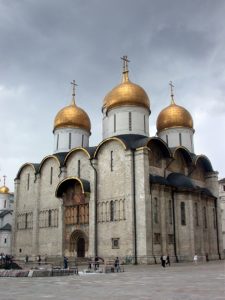
Assumption Cathedral – Wikimedia Commons
2. The world’s largest medieval fortress is found in Moscow

Moscow Kremlin on foreground- by Pavel Kazachkov- Wikimedia Commons
3. Moscow hosts Russia’s largest zoo
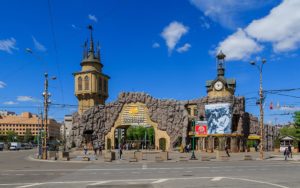
Moscow Zoo entrance- by A.Savin – Wikimedia Commons
4. Trains with the most frequency in the world are found in Moscow
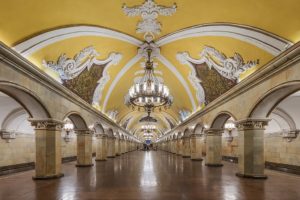
Moscow Metro- by A.Savin – Wikimedia Commons
5. The City of Moscow hosts the World’s second-largest library

Russian State Library main building interior- by A.Savin – Wikimedia Commons
6. The City of Moscow is home of the Babushka doll
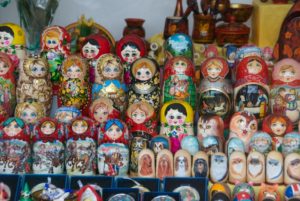
Babushka dolls variety- by Ph. Saget – Wikimedia Commons
7. The City of Moscow hosts the world’s largest university building

Moscow State University- by Dmitry A. Mottl- Wikimedia Commons
8. The City of Moscow hosts one of the largest urban parks in the world
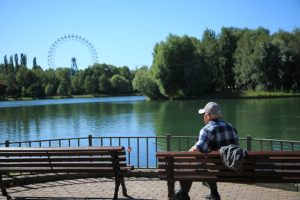
Visitor at Izmailovo Park- by Kristy2906 -Wikimedia Commons
9. Europe’s largest botanical garden is found in Moscow

Moscow’s Botanical Garden- by AlixSaz- Wikimedia Commons
10. The City of Moscow boasts 7 identical skyscrapers

Seven Sisters side by side pictures- by okruz- Wikimedia Commons
11. The City of Moscow FBI buildings were once torture chambers
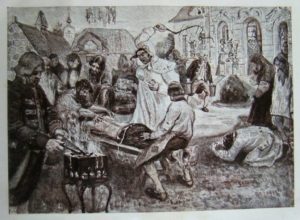
Peasants tortured by Saltykova- by P. V. Kurdyumov – Wikimedia Commons
12. The first man in space was buried in Moscow
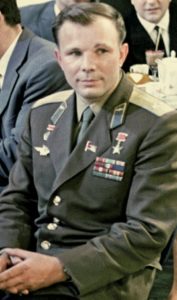
Yuri Gagrin- by P. V. Kurdyumov- Wikimedia Commons
13. Victory Obelisk is Moscow’s highest Monument

Victory Obelisk- by GAlexandrova- Wikimedia Commons
14. Moscow has an underground river
15. moscow’s stray dogs can navigate the metro, 16. lenin’s corpse is preserved in a mausoleum in moscow’s red square.
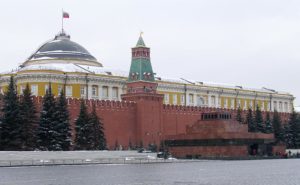
Lenin Mausoleum at the Red Square- by NVO- Wikimedia Commons
17. The largest bell in the world is found in the City of Moscow
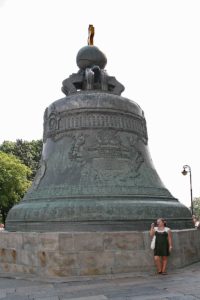
Tsar Bell- by W. Bulach- Wikimedia Commons
18. The City of Moscow has billionaire residents
19. old moscow was segregated, 20. the city of moscow and england share an insignia.
St. George on Horseback slaying the dragon- by W. Bulach- Wikimedia Commons
Planning a trip to Paris ? Get ready !
These are Amazon’s best-selling travel products that you may need for coming to Paris.
- The best travel book : Rick Steves – Paris 2023 – Learn more here
- Fodor’s Paris 2024 – Learn more here
Travel Gear
- Venture Pal Lightweight Backpack – Learn more here
- Samsonite Winfield 2 28″ Luggage – Learn more here
- Swig Savvy’s Stainless Steel Insulated Water Bottle – Learn more here
Check Amazon’s best-seller list for the most popular travel accessories. We sometimes read this list just to find out what new travel products people are buying.
Christine M
Discover Walks contributors speak from all corners of the world - from Prague to Bangkok, Barcelona to Nairobi. We may all come from different walks of life but we have one common passion - learning through travel.
Whether you want to learn the history of a city, or you simply need a recommendation for your next meal, Discover Walks Team offers an ever-growing travel encyclopaedia.
For local insights and insider’s travel tips that you won’t find anywhere else, search any keywords in the top right-hand toolbar on this page. Happy travels!
Hello & Welcome
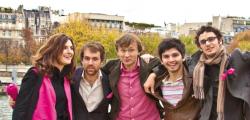
Popular Articles

Top 20 Streets to See in Paris

Paris in two days

Top 15 Things to do Around the Eiffel Tower

The Best Way to Visit Paris Museums

Top 15 Fashion Stores in Le Marais
Visit europe with discover walks.
- Paris walking tours
- Montmartre walking tour
- Lisbon walking tours
- Prague walking tours
- Barcelona walking tours
- Private tours in Europe
- Privacy policy
© 2024 Charing Cross Corporation
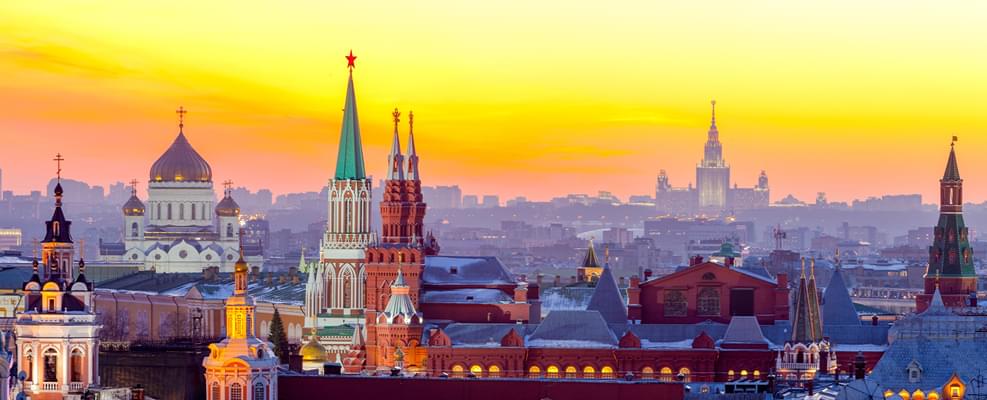
Moscow Attraction Tickets
Why to visit moscow.
Moscow is the capital of Russia and a majestic city that will surprise, seduce and shock you at every turn. It is renowned for its fairly-tale structures, stunning architectural splendors, and enormous expanses of wilderness. It has homegrown museums where you can retrace Russia's magnificent literary heritage. Moscow is also home to the best cultural institutions in the world that celebrate Russia's fine arts. The city is renowned for its performing arts, and you can watch a ballet, opera, or circus performance at one of Moscow's theaters. You can see sculptures of celebrities everywhere along the streets, showing a sense of pride in the Russians.The city is soaked in history, and walking around the streets is like teleporting from one century to the next. Don't forget to visit scenic parks like Sokolniki, Gorky, and Kolomenskoe that turn into popular festival spots in the summer and ice skating rinks in the winter. The city features an impressive variety of clubs, shopping avenues, and bars and has many vibrant boulevards and districts where you can feel the pulsating energy of the city. So buy the Moscow attractions tickets now to soak into the magnificent heritage and culture of the city.
Top Moscow Attractions Tickets
Purchase the Moscow City Pass and get access to some of the most iconic attractions like the Bolshoi Theatre, All-Russian Exhibition Center, Red Square, Moscow Zoo, and Kremlin. These attractions are an ode to the city's rich history and culture and reflect all strands of Russia's convoluted past.
You can start your trip by visiting Bolshoi Theatre, a historic theatre where you can enjoy the world-class ballet and opera performances. Appreciate the breathtaking architecture of St. Basil's Cathedral and trace Russia's most defining political and historical events by heading to the Kremlin. Moscow City Pass also gives you access to Moscow Zoo, one of the oldest zoos in the world with more than eight thousand animals and birds. Watch the army parades at Red Square and see the specialized exhibitions dedicated to furs, food, jewelry, cats, and dogs at the All-Russian Exhibition Center.
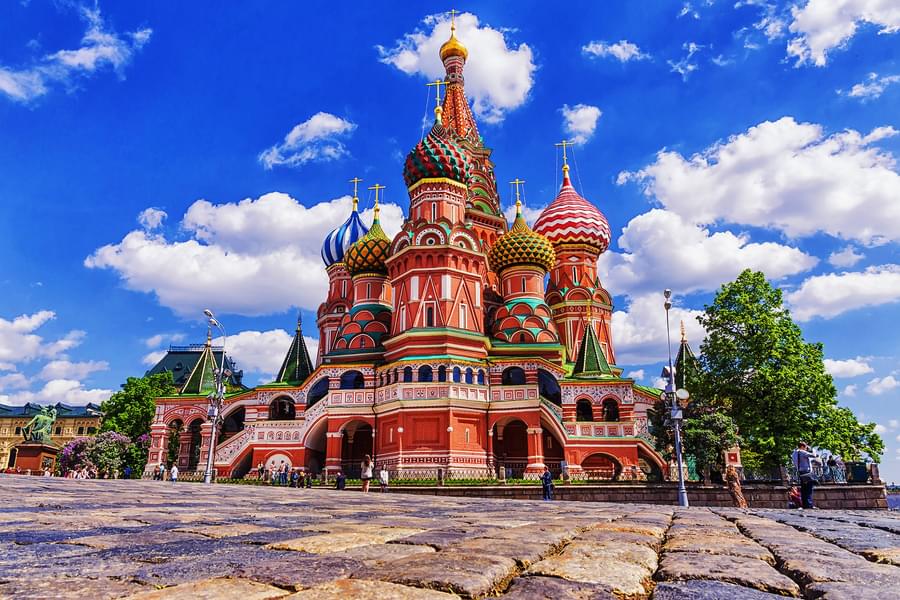
Moscow Museum tickets
With the Moscow Pass, you can visit some of the most iconic museums, like the Central House Museum of Aviation and Space, State Historical Museum, and Museum of Cosmonautics, at discounted rates. These museums will remind you of Russia's glorious past and rich heritage.
You can visit the Museum of Cosmonautics to learn about the nation's achievements in space exploration and head to the Central House Museum of Aviation and Space to see more than thirty-six thousand space-related exhibits. Learn about the life of Mikhail Bulgakov at Museum Theatre "Bulgakov House" and see relics of prehistoric tribes at the State Historical Museum. You can also visit Lenin's Mausoleum at Red Square, a mausoleum that serves as the final resting place of Vladimir Lenin. Moscow Pass also gives you access to Pushkin State Museum of Fine Arts, the largest museum of European art known for its world-class exhibitions. You can also visit Moscow State Integrated Museum-Reserve, Russia's largest museum-reserve with two historical and cultural territories.
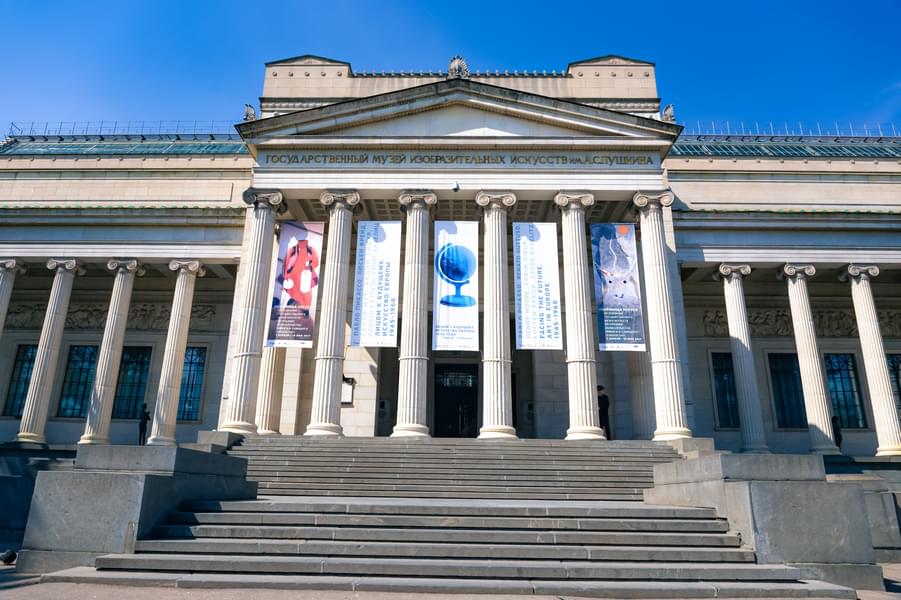
Moscow Day Trips
Reveal the hidden treasures of Moscow and get acquainted with the city's highlights by opting for day trips. Some of the day trip options include Moscow Walking Tour, a one-day tour, and hop on hop off tour.
Learn about Moscow's vibrant hipster culture and marvel at the breathtaking attractions by undertaking the Moscow Walking Tour. Walk through the picturesque lanes of St. John's Hill or the terrifying neighborhood of Khitrovka and listen to interesting narrations from your guide. You can also opt for a hop on hop off tour and explore the beautiful city on a double-decker bus. Another interesting option is the one-day tour in Moscow that gives you a chance to explore the historic locations of the city, like St. Basil's Cathedral, Alexander Garden, and Red Square, at your own pace.
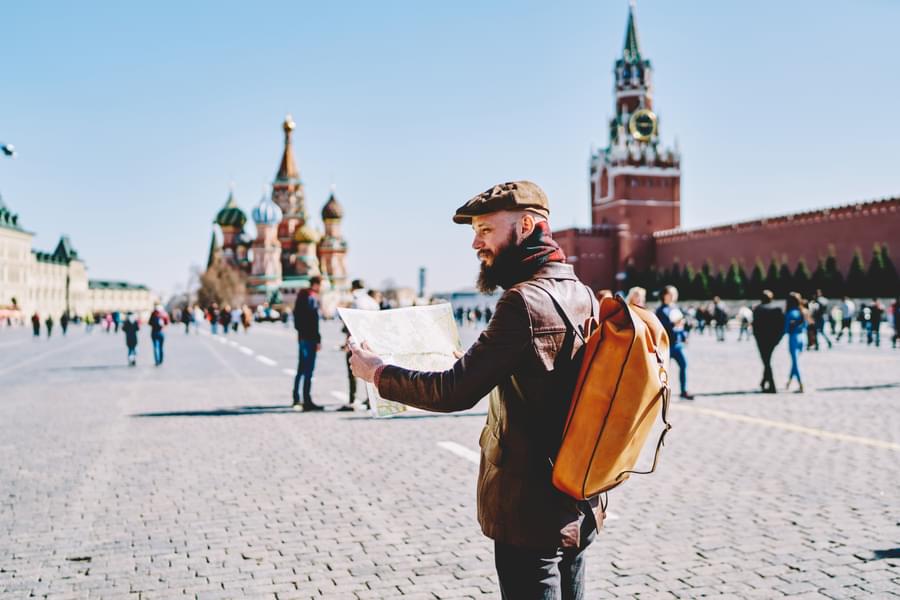
Plan Your Visit to Moscow
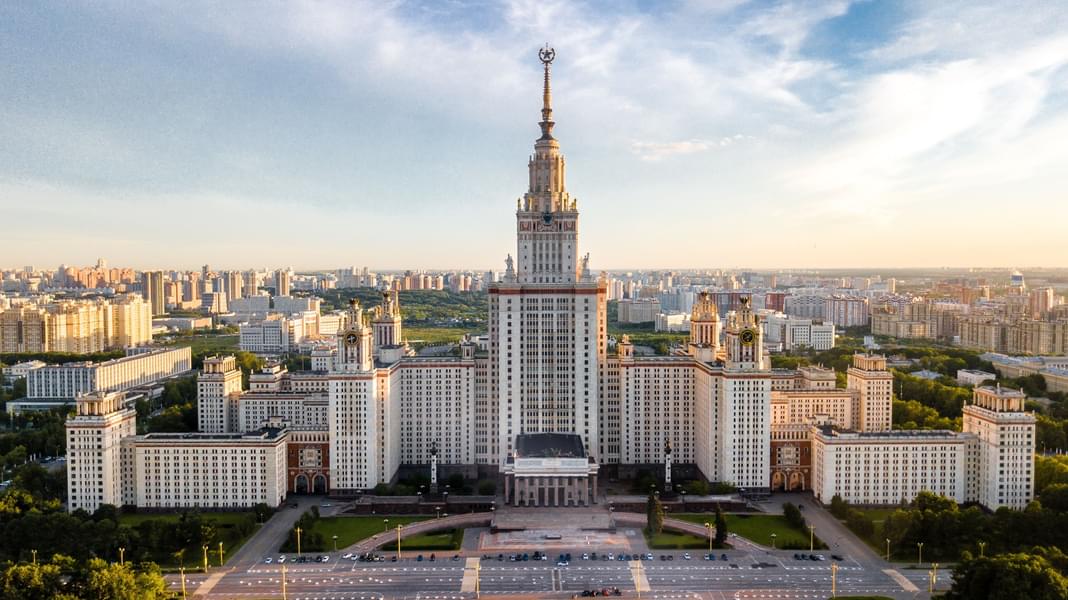
By Air : Moscow Domodedovo Airport is the main airport of the city that serves different destinations around the world. The major carriers include S7 Airlines, Red Wings Airlines, Smartavia, and Ural Airlines.
By Train: The city has nine rail terminals that handle traffic from different parts of Europe and Asia. An electric railway network connects the city with various suburbs and surrounding cities.

May and September is the best time to visit Moscow as, during these months, the temperature starts soaring, snow starts melting, and flowers start blooming. Due to the pleasant weather, you can also indulge in various outdoor activities during this time of the year.
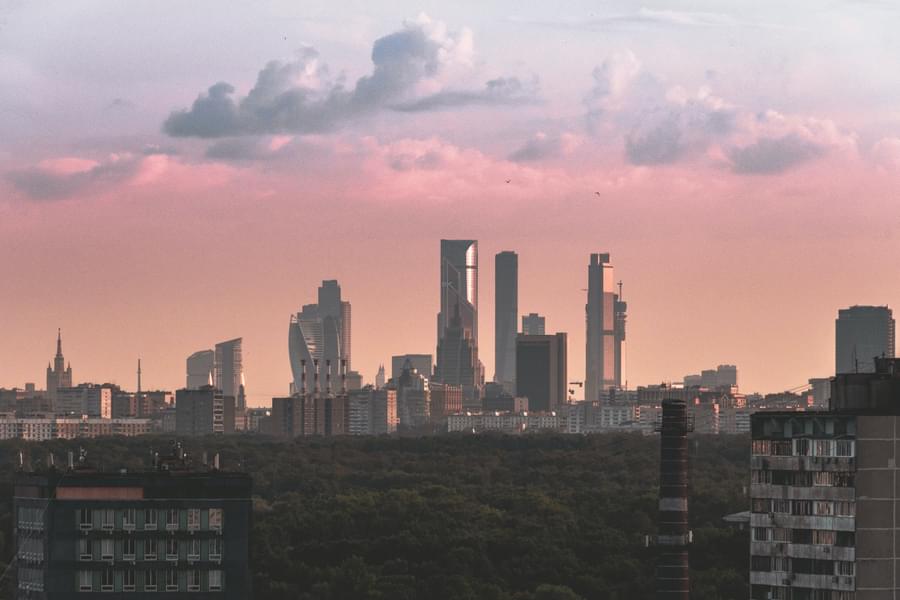
Metro : The Metro system has twelve lines, and more than one hundred and fifty stations are marked with 'M' signs. Metro runs every two to three minutes, so you won't have to wait for a long time to find a train.
Tram : The tram network is divided into three sub-networks, and it covers a total route length of around one hundred and ten mile spread. Trams also connect metro lines and provide a scenic way to tour the city.
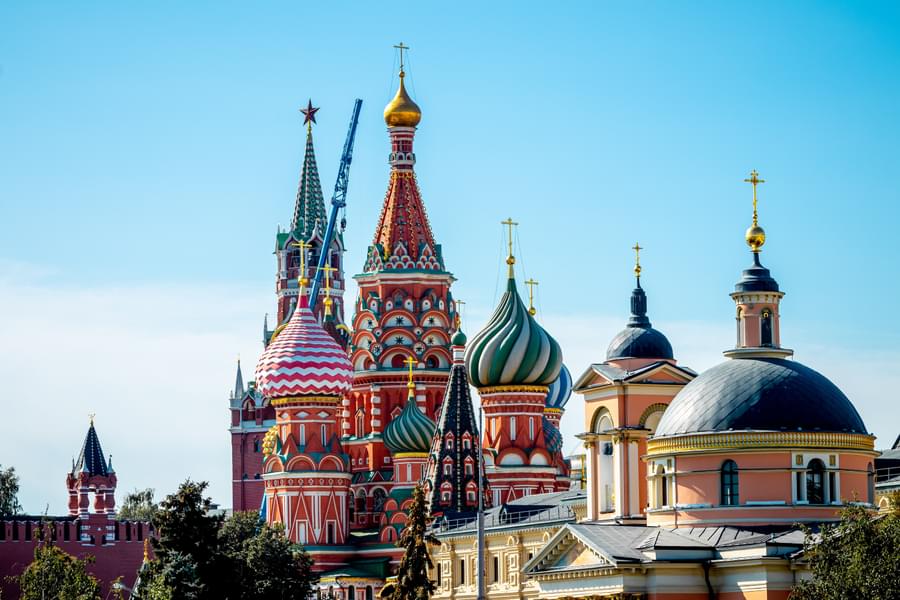
Tverskoy : Tverskoy is renowned for its nightlife and has tons of bars and nightclubs. It offers good connectivity with the city as it has eight metro stations and various bus stops. You can also find budget-friend and premium accommodation options here.
Basmanny : Basmanny is the northwest portion of Moscow dotted with a wide variety of museums and art galleries. It is home to artsy venues and five-star accommodations and hotels.
Arbat : It is a trendy neighborhood with top-notch restaurants, cloth shops, hotels, and cathedrals. Whether you want a cheap or a five-star stay, this area will cater to all your needs.
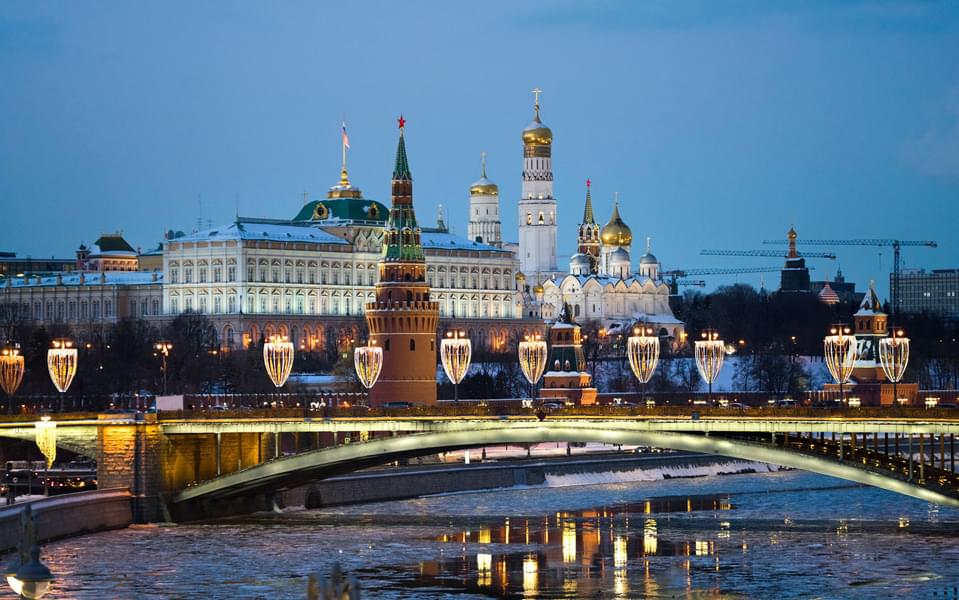
Moscow has terrible traffic, so getting around by car is not a good idea. The metro is one of the best options to get around the city.
Carry your passport with you whenever you're going out. You'll need a passport to buy train tickets, a sim card, and even theatre tickets.
Apply for a visa three months before the tour so that you can be free from any prospective hassles.
Some of the dishes that you must try in Moscow include cake pushkin, borscht, and lepyoshka.
Do not exchange a large amount of money at the airport, as the exchange rates are much higher.
Buy the Moscow City Pass to explore the popular attractions at a budget-friendly rate.
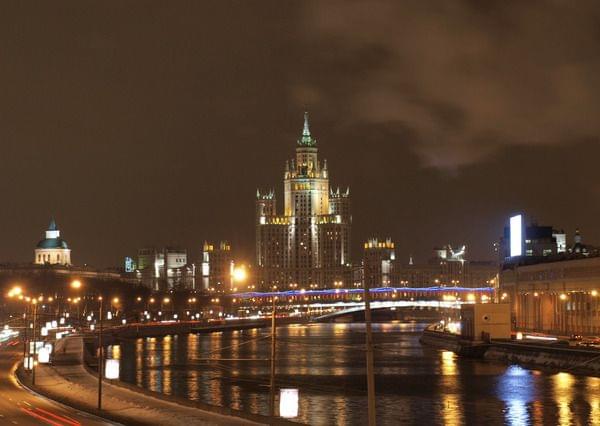
Weather : Moscow experiences a continental climate with cold and chilly winters and hot summers. During summer months, the temperature hovers around 23 degrees Celsius, while in winter, there is plenty of snow, and the temperature is often lower than -10 degrees Celsius.
Language : Russian is the official language of Moscow. English is the second most widely spoken language by the people.
Time Zone : Moscow follows MSK- Moscow Standard Time zone.
Budget : You will spend around ₽4,642 ($77) on your vacation in Moscow daily. On average, you'll spend around ₽1,052 ($17) on meals and ₽453 ($7.51) on transportation daily. The average accommodation rate in the city for a couple is around ₽5,864 ($97). So, a vacation to Moscow for one week for two people will cost around ₽64,987 ($1,078).
Currency : The currency of Moscow is the Ruble.
Visa : If you're a citizen of the EU, Asia, Japan, the USA, or Africa, you'll need to get a visa to enter Moscow. Citizens of Qatar, Israel, Colombia, Costa Rica, and Laos don't need a visa to enter Moscow.
What are the best attractions to see in Moscow?
Saint Basil's Cathedral
Skip the line and get direct entry to Saint Basil's Cathedral with Moscow Pass. Saint Basil's Cathedral is a symbol of Russia, and it houses nine different chapels connected by a winding labyrinth of stairways and corridors. There is a beautiful garden outside the cathedral with bronze monuments.
Red Square is a beautiful square that houses breathtaking attractions like the Kremlin, Lenin's Mausoleum, and St. Basil's Cathedral. It hosts rock concerts, public ceremonies, and Soviet military parades.
With the Moscow attractions tickets, you can get access to the Kremlin, a fortified complex that houses four cathedrals and five palaces. The Kremlin also serves as the residence of the president of Russia.
How many days should I spend in Moscow?
You should spend a minimum of two days in Moscow. On the first day, you can explore iconic attractions like the All-Russian Exhibition Center, Red Square, Moscow Zoo, and the Kremlin. Reserve your second day for the Moscow walking tour and shopping.
What is the best time to visit Moscow?
May and September is the best time to visit Moscow as, during these months, the snow starts to melt and the temperature starts soaring. Many events and festivals are also organized during this time of the year.
How can I get cheap Moscow attraction tickets?
You can buy Moscow Pass to explore the famous attractions at discounted rates.
What is the best way to book Moscow museum tickets?
You can book Moscow museum tickets from trustworthy and reputed online travel sites. Moscow attractions tickets are also the best way to visit the popular museums at reduced rates.

© 2022 mymoscowpass.com All rights reserved.

Touropia Travel Experts
Discover the World
17 Top Tourist Attractions in Moscow

The capital of Russia is an incredible place to explore. Visitors to Moscow come away spellbound at all the amazing sights, impressed at the sheer size and grandeur of the city. Lying at the heart of Moscow, the Red Square and the Kremlin are just two of the must-see tourist attractions; they are the historical, political and spiritual heart of the city – and indeed Russia itself.
A fascinating city to wander around, stunning cathedrals, churches, and palaces lie side-by-side with bleak grey monuments and remains from the Soviet state. In addition to its plethora of historical and cultural tourist attractions, Moscow is home to world-class museums, theaters and art galleries.
Renowned for its performing arts, fantastic ballets and amazing circus acts, catching a show while in Moscow is a must. The wealth of brilliant restaurants, trendy bars, and lively nightlife means there is something for everyone to enjoy.
See also: Where to Stay in Moscow
17. Tsaritsyno Palace
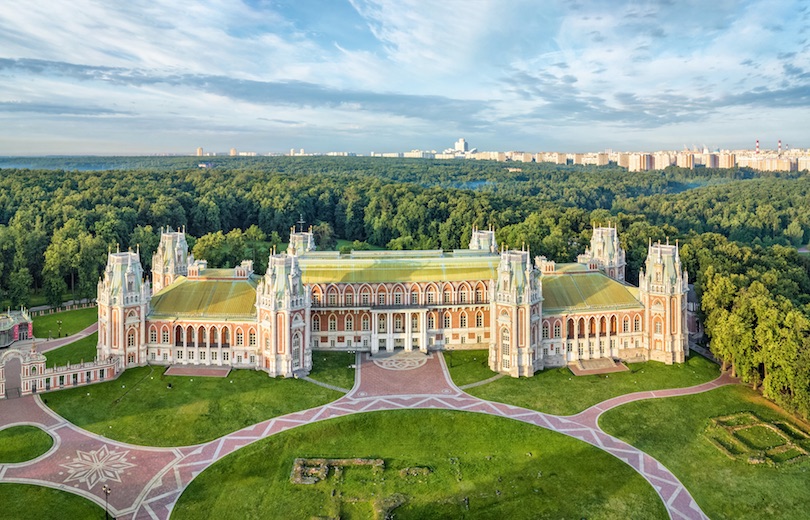
Once the summer residence of Catherine the Great, the stunning Tsaritsyno Palace is now a museum-reserve. The architecture is magnificent and there is a lovely park surrounding it for visitors to explore.
Located in the south of Moscow, the palace was commissioned in 1775 and recent renovations mean its lavish interior looks better than ever before with its elegant halls and beautiful staircases.
The exhibits on display look at the life of the empress as well as the history of Tsaritsyno itself. The huge palace grounds are also home to some other delightful buildings with the elegant opera house and wonderful brickwork of the Small Palace being particularly impressive to gaze upon.
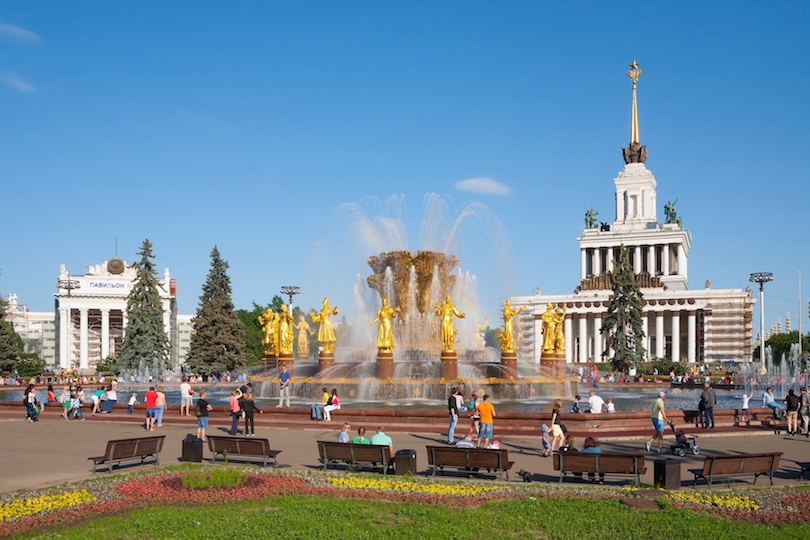
Starting out in 1935 as the ‘All-Union Agricultural Exhibition’, VDNKh has slowly morphed over the years into the fascinating open-air museum of today. Remarkably, over 400 buildings can now be found within its confines.
The huge park complex has numerous pavilions representing former Soviet republics on show, such as those of Armenia and Turkmenistan and the distinctive architecture of each of the buildings is always interesting to gaze upon. In addition to this there is the fascinating Memorial Museum of Cosmonautics which is dedicated to space exploration and the fun Moskvarium aquarium even offers you the chance to swim with dolphins.
With lots of eateries scattered about and numerous entertainment options such as horse-riding and zip-lining, there is something for everyone to enjoy; the Friendship of Nations fountain truly is wonderful.
15. Kremlin Armoury
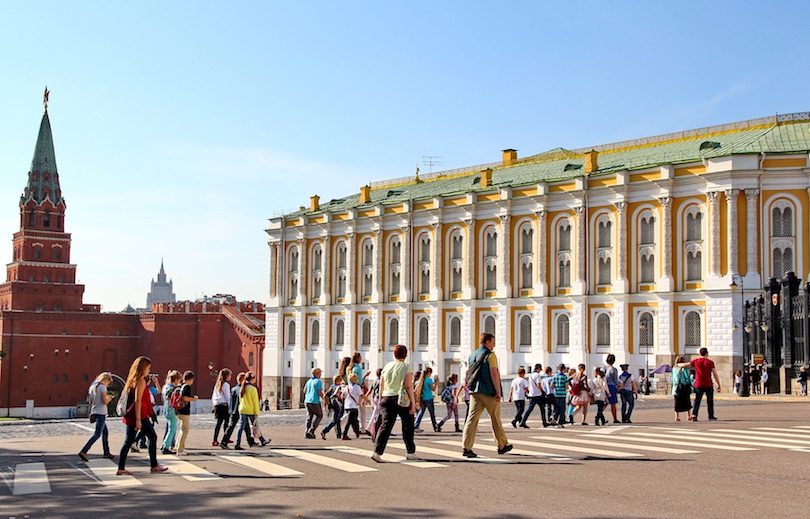
One of the oldest museums in the city, the Kremlin Armoury has a wealth of treasures; highlights include the ornate Grand Siberian Railway egg, the historic Cap of Monomakh and the stunning Imperial Crown of Russia which often has a crowd of tourists around it, jostling to take a photo.
Once the royal armory, there are loads of fascinating objects on display. Perusing the many sabers, jewelry, armor and more is as interesting as it is educational and entertaining and the swords are so finely crafted that you’ll almost wish you could pick up one and wield if yourself.
Established in 1851, the museum is situated in the Moscow Kremlin.
14. GUM Department Store

Standing for ‘Main Universal Store’ in Russian, GUM is stunning. Its wonderful skylights and beautiful facades mean it doesn’t look out of place alongside its illustrious neighbors on Red Square.
With over 200 shops, boutiques and upmarket eateries inside, it is a shopaholic’s heaven and concerned partners will be glad to find more affordable options alongside luxury brands such as Dior and Prada.
The main department store in the city, GUM was opened in 1893. The stunning architecture makes it well worth a visit even if shopping isn’t your thing.
13. Moscow Metro
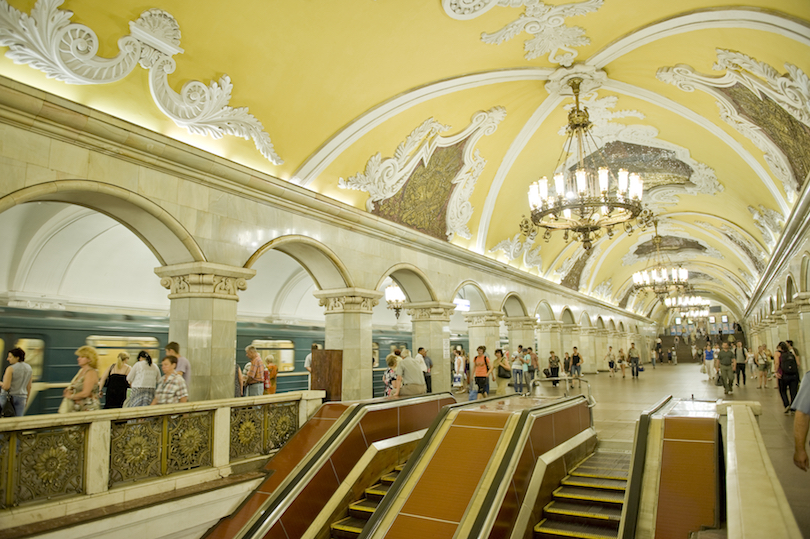
It’s not often that public transport looks like a work of art. So many stops on the Moscow Metro will astound visitors with their beauty and elegance.
Decked in marble and with frescoes covering the walls, the stations are amazing to gaze upon and are part of one of the longest metro systems in the world, with the first stations opened in 1935.
Using the metro is the quickest and easiest way to get around Moscow and braving the crowds of commuters is well worth it for the beauty all around you.
12. Arbat Street
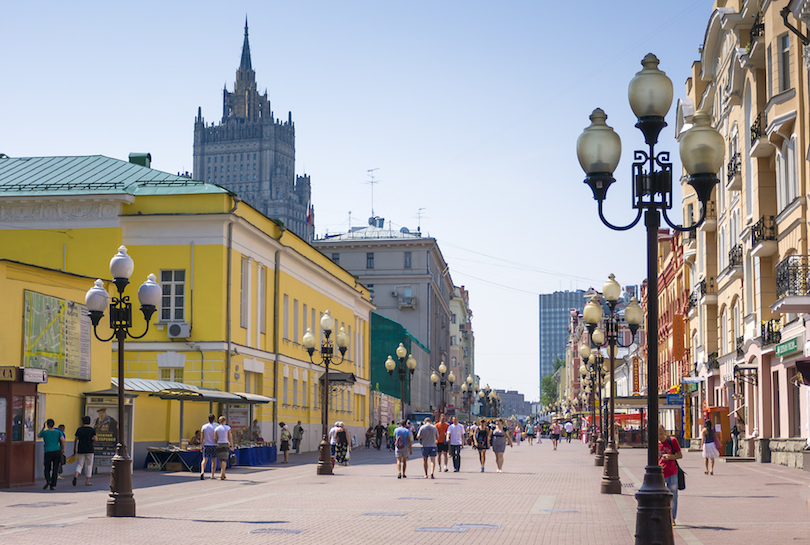
An elegant yet lively street, Arbat is full of impressive architecture and was once a popular place to live for aristocrats, artists, and academics.
A historic place, it is down Arbat Street that Napoleon’s troops are said to have headed on their way to capture the Kremlin.
Nowadays, there are many cafes, restaurants, and shops, as well as various monuments and statues to former residents such as Alexander Pushkin who was reputed to be a lover of the Russian Empress due to his massive influence in court.
11. Novodevichy Convent
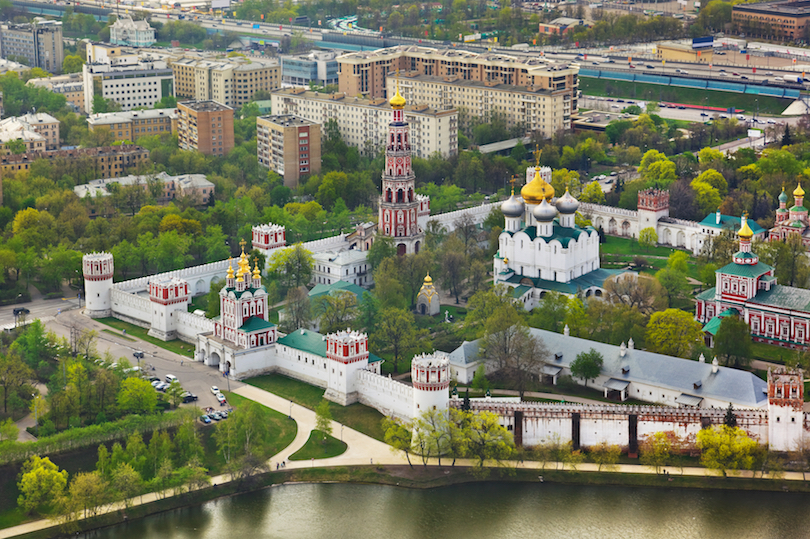
Drenched in history, the Novodevichy Convent is located in a striking building that was once a fortress. This captivating place is well worth visiting when in Moscow.
Founded in 1524, the convent houses four cathedrals; Smolensk Cathedral is the undoubted highlight due to its delightful 16th-century frescoes.
Wandering around the grounds is like stepping back in time. The Novodevichy Cemetery is where many famous leaders of the Soviet Union are buried, such as Yeltsin and Khrushchev.
10. Pushkin Museum
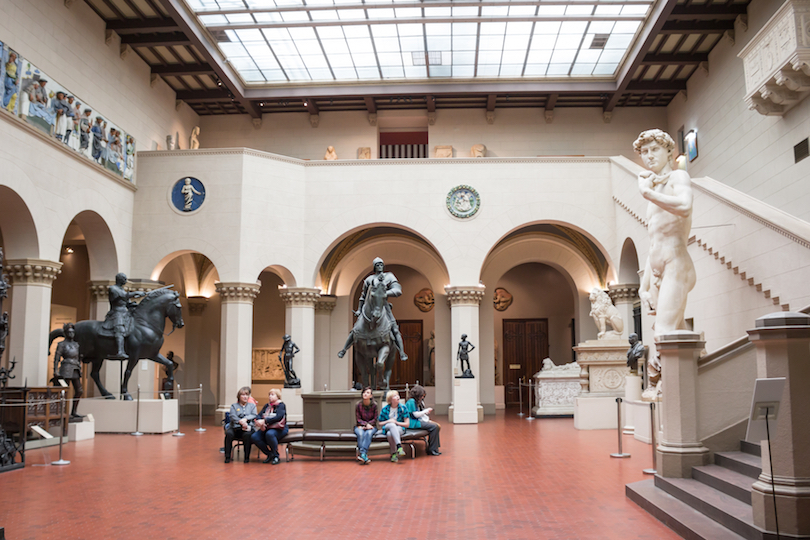
Despite its name, the Pushkin Museum of Fine Arts actually has no connection at all to the famous poet other than that it was named in his honor after his death. A delight to visit, its extensive collection focuses on European art with masterpieces by Botticelli, Rembrandt, and van Gogh all featuring.
Sculptures, graphic art, paintings and more can be found in its beautiful galleries; various sections look at themes and epochs such as the Renaissance, the Dutch Golden Age, and Byzantine art.
Among the many highlights are the clownish characters which can be found in Cezanne’s Fastnacht (Mardi Gras) and the twirling ballerinas who look so elegant in Degas’ Blue Dancers. Picasso’s Young acrobat on a Ball is also well worth checking out for its interesting use of shapes and colors.
9. Christ The Savior Cathedral
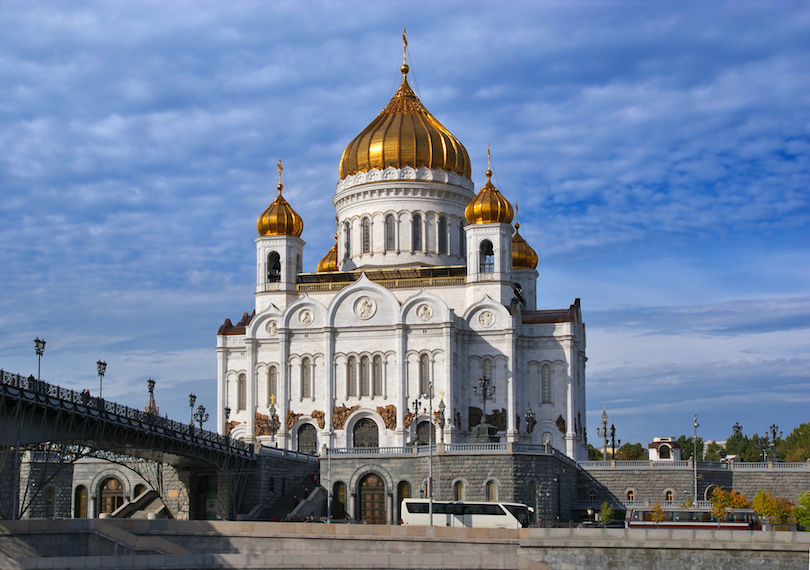
This gorgeous Russian Orthodox cathedral is located on the banks of the Moskva River, just a stone’s throw away from the Kremlin.
The church as it stands today was consecrated in 2000, as the original church that stood here was destroyed on the command of Josef Stalin in 1931 due to the anti-religious campaign.
With its delightful golden dome, spires and dazzling white facades, the Christ the Savior Cathedral is stunning. The interior is just as captivating to wander around, with its beautifully tiled floors and impressive altar.
8. Lenin Mausoleum
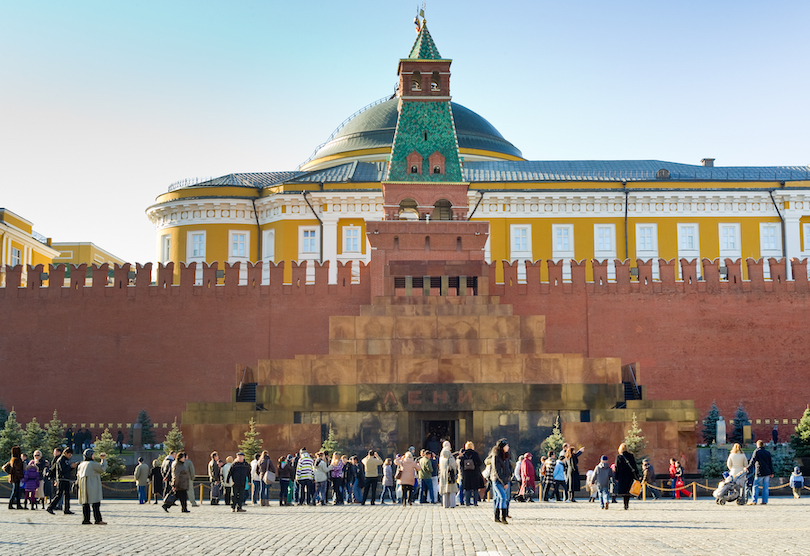
Opened to the public in 1924, Lenin’s Mausoleum is one of the most popular tourist attractions in Moscow. The red granite structure is located at the heart of the city in Red Square.
Lenin’s embalmed body lies in a glass sarcophagus; it is a somewhat eerie experience walking past the former leader of the Soviet Union but is well worth doing as you understandably can’t do it anywhere else in the world.
After visiting the mausoleum, head to the Kremlin wall right next to it for more graves of important communist figures such as Stalin and Brezhnev.
7. Tretyakov Gallery
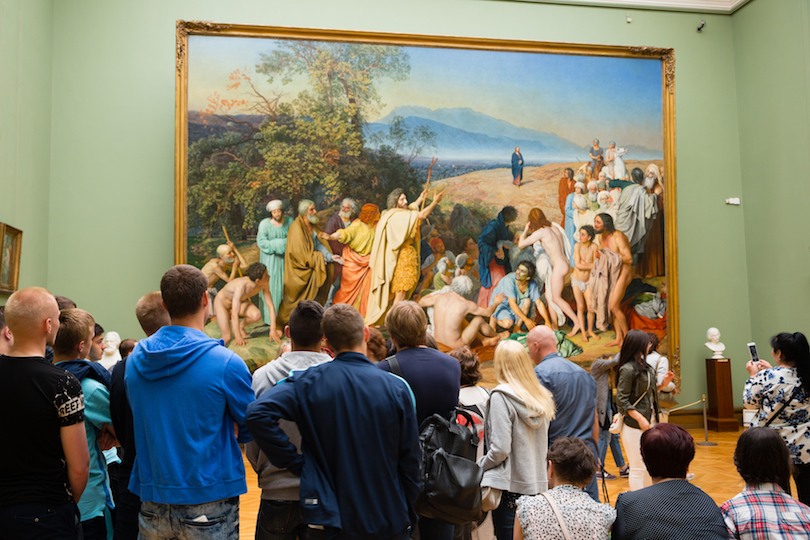
Home to the most extensive and impressive collection of Russian fine art in the world, the State Tretyakov Gallery is definitely worth visiting when in Moscow for the wealth of amazing art pieces that it has on display.
Having started out as the private art collection of the Tretyakov brothers, there are now over 130,000 exhibits. Highlights include the iconic Theotokos of Vladimir which you will almost certainly recognise despite probably not knowing the name and Rublev’s Trinity which is considered to be one of highest achievements in Russian art.
An absolute must for art lovers, the State Tretyakov Gallery will delight visitors with all that is has to offer.
6. Kolomenskoye
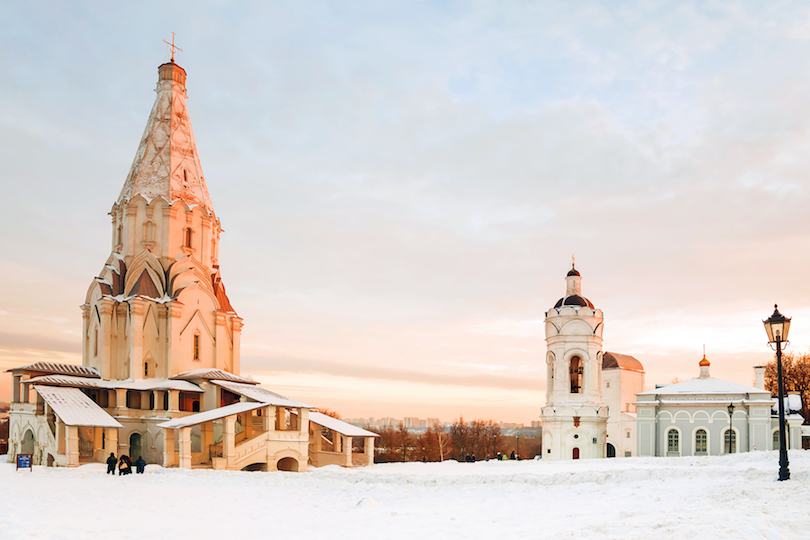
Once a royal estate, Kolomenskoye is now a museum-reserve and lies a few kilometers outside of the city center. A captivating place to visit, there is a plethora of history on show and the site overlooks the Moskva River.
Consisting of four historical sites, there are extensive gardens for visitors to explore, as well as loads of interesting old buildings, the former village of Kolomenskoye itself and the impressive Palace of the Tsar Alexey Mikhailovich – once considered the Eighth Wonder of the World by contemporaries.
Among the many stunning sights, it is the brilliantly white Ascension Church that is the undoubted highlight – dating back to 1532.
5. Gorky Park
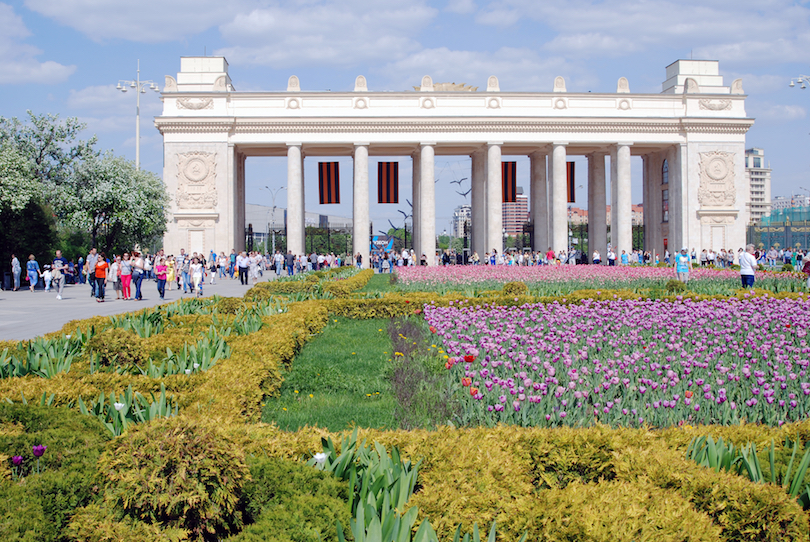
Lying alongside the Moskva River, the huge Gorky Park is a lovely place to visit. Its extensive gardens are home to numerous cultural institutions and visitors should definitely check out the Garage Museum of Contemporary Art and while the eclectic exhibits may not always feature such incredible sights as a balloon-covered rider on a zebra; they certainly always succeed in pushing back the boundaries of art.
Pop-up exhibitions and festivals can be found from time to time in the park itself and there is an open-air theatre and numerous eateries alongside a plethora of leisure activities.
Whether it’s cycling, table tennis or yoga that you are after or beach volleyball and rowing, Gorky Park certainly has it. In winter, there is a huge ice rink for visitors to enjoy.
4. Bolshoi Theatre
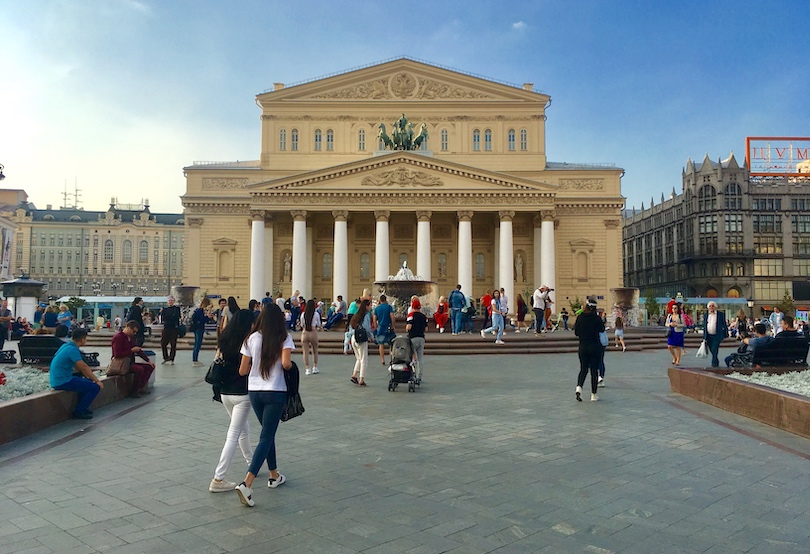
The Bolshoi Theatre is the main theater in the country. The amazing opera and ballet performances it has put on over the centuries go a long way in explaining Russia’s rich history of performing arts.
While the Bolshoi Ballet Company was established in 1776, the theater itself was opened in 1825. The glittering, six-tier auditorium is lavishly and decadently decorated; it is a fitting setting for the world-class performances that take place on its stage.
Spending a night watching a performance of such classics as The Nutcracker or Swan Lake at the Bolshoi Theatre is sure to be a memorable experience and the beauty all around you only adds to the sense of occasion.
3. Moscow Kremlin
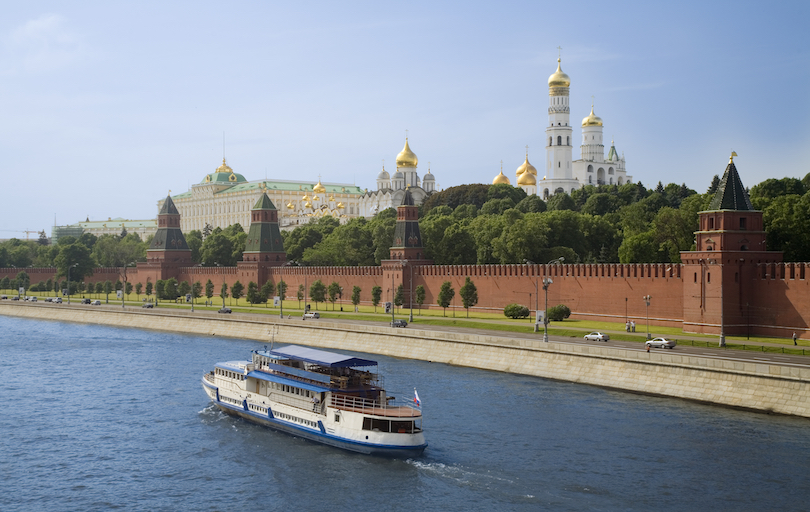
This famously fortified complex is remarkably home to five palaces and four cathedrals and is the historic, political and spiritual center of the city. The Kremlin serves as the residence for the country’s president. It has been used as a fort, and this fact is made clear by its sheer size. The Kremlin’s outer walls were built in the late 1400s.
Under Ivan III, better known as Ivan the Great, the Kremlin became the center of a unified Russian state, and was extensively remodeled. Three of the Kremlin’s cathedrals date to his reign that lasted from 1462-1505. The Deposition Church and the Palace of Facets were also constructed during this time. The Ivan the Great Bell Tower was built in 1508. It is the tallest tower at the Kremlin with a height of 266 feet (81 meters).
Joseph Stalin removed many of the relics from the tsarist regimes. However, the Tsar Bell, the world’s largest bell, and the Tsar Cannon, the largest bombard by caliber in the world, are among the remaining items from that era. The Kremlin Armory is one of Moscow’s oldest museums as it was established more than 200 years ago. Its diamond collection is impressive.
The Kremlin’s gardens – Taynitsky, Grand Kremlin Public and Alexander – are beautiful. The Kremlin has also served as the religious center of the country, and there is a tremendous number of preserved churches and cathedrals here. The collections contained within the museums include more than 60,000 historical, cultural and artistic monuments. Those who enjoy the performing arts will want to consider attending a ballet or concert at the State Kremlin Palace. Completed in 1961, it is the only modern building in the Kremlin.
2. Red Square
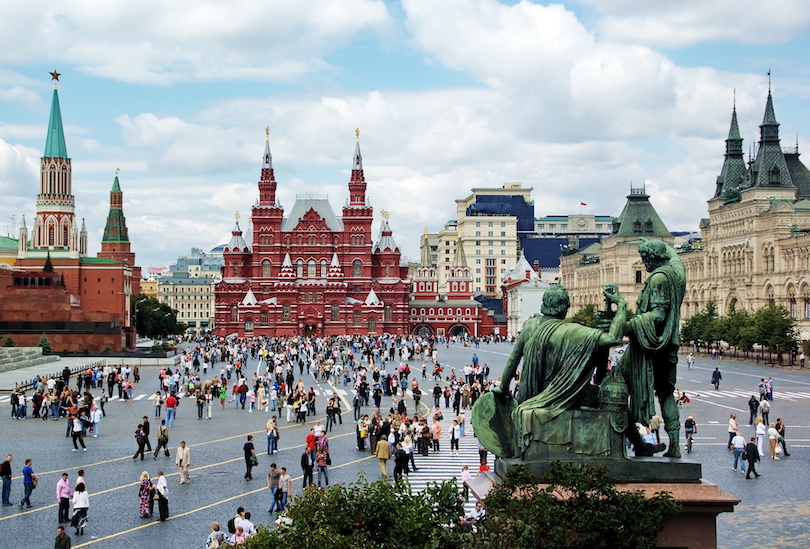
Lying at the heart of Moscow, Red Square is the most important and impressive square in the city. It is one of the most popular tourist attractions due to its wealth of historical sights and cultural landmarks.
Drenched in history, the huge square is home to incredible sights such as the Kremlin, St. Basil’s Cathedral and Lenin’s Mausoleum, among others. Consequently, it is not to be missed when in Moscow as it really is home to the city’s most stunning monuments.
It is here that many important moments in Russian history took place; the former marketplace has hosted everything from Tsar’s coronations and public ceremonies to rock concerts and Soviet military parades. Wandering around the massive square is a humbling experience and undoubtedly one of the highlights the city has to offer.
1. Saint Basil’s Cathedral
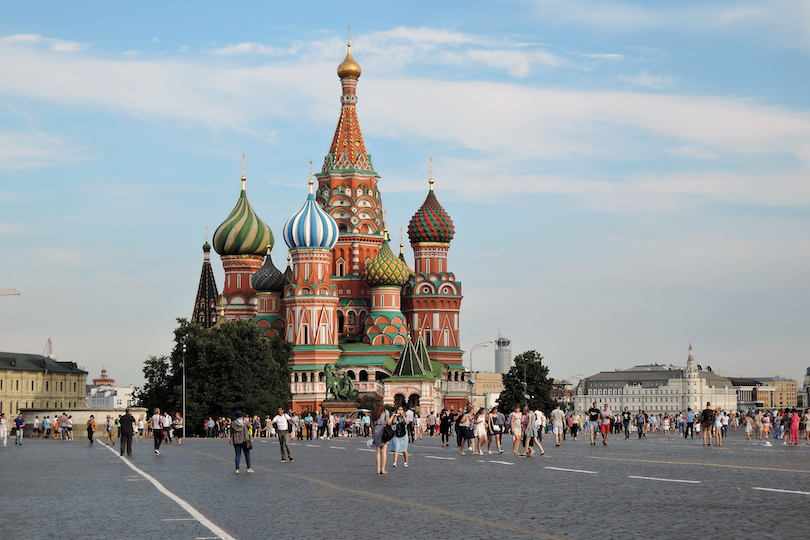
Located in the impressive Red Square, St. Basil’s Cathedral is gorgeous; its delightful spires appear as if out of a fairytale. The most recognizable building in the country, the cathedral is very much a symbol of Russia. No visit to Moscow is complete without having taken in its unique and distinctive features.
Ivan the Terrible ordered the cathedral’s construction in the mid-16th century, and legend holds that Ivan put out the architect’s eyes so that he would be unable to build another cathedral more glorious than St. Basil’s. Designed to resemble the shape of a bonfire in full flame, the architecture is not only unique to the period in which it was built but to any subsequent period. For various reasons, both Napoleon and Stalin wanted to destroy the cathedral but fortunately did not succeed.
Known for its various colors, shapes and geometric patterns, St. Basil’s Cathedral houses nine different chapels that are all connected by a winding labyrinth of corridors and stairways. On the lower floor, St. Basil’s Chapel contains a silver casket bearing the body of St. Basil the Blessed.
Throughout the cathedral are many beautiful murals, frescoes, wooden icons and other art works and artifacts. Outside the cathedral is a lovely garden with the bronze Monument to Minin and Pozharsky, who rallied an all-volunteer Russian army against Polish invaders during a period of the late 16th century known as the Times of Troubles.
Share this post:
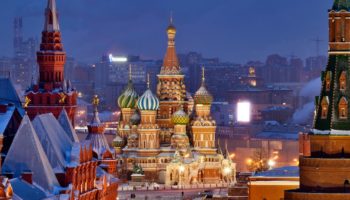
Where to Stay in Moscow
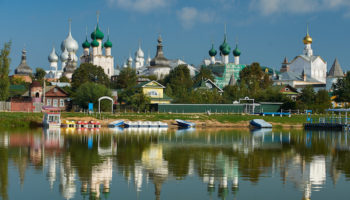
10 Best Places to Visit in Russia

10 Most Amazing Destinations in Eastern Russia
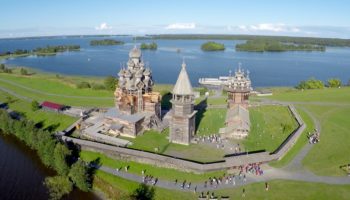
10 Top Tourist Attractions in Russia
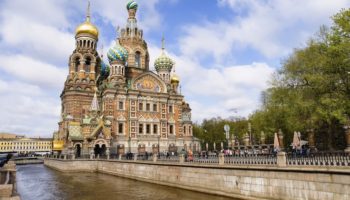
15 Best Attractions & Things to do in Saint Petersburg, Russia
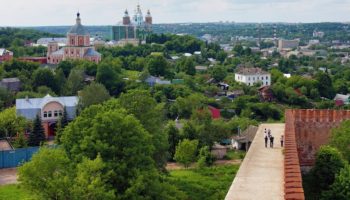
15 Best Cities to Visit in Russia

9 Most Beautiful Regions in Russia
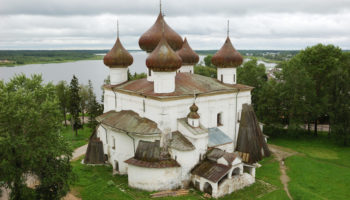
14 Most Scenic Small Towns In Russia
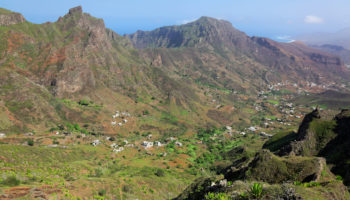
10 Best Cape Verde Islands

12 Top Attractions & Things to do in Madagascar
- pop Culture
- Facebook Navigation Icon
- Twitter Navigation Icon
- WhatsApp icon
- Instagram Navigation Icon
- Youtube Navigation Icon
- Snapchat Navigation Icon
- TikTok Navigation Icon
- pigeons & planes
- newsletters
- Youtube logo nav bar 0 youtube
- Instagram Navigation Icon instagram
- Twitter Navigation Icon x
- Facebook logo facebook
- TikTok Navigation Icon tiktok
- Snapchat Navigation Icon snapchat
- Apple logo apple news
- Flipboard logo nav bar 1 flipboard
- Instagram Navigation Icon google news
- WhatsApp icon whatsapp
- RSS feed icon rss feed
Complex Global
- united states
- united kingdom
- netherlands
- philippines
- complex chinese
Work with us
terms of use
privacy policy
cookie settings
california privacy
public notice
accessibility statement
COMPLEX participates in various affiliate marketing programs, which means COMPLEX gets paid commissions on purchases made through our links to retailer sites. Our editorial content is not influenced by any commissions we receive.
© Complex Media, Inc. All Rights Reserved.
Complex.com is a part of
Astrology Influencer Kills Partner and Eight Month Old Baby in Eclipse Day Murder-Suicide
The woman, who had over 100,000 followers on X, made a series of concerning posts leading up to the eclipse.


View this video on YouTube
After a series of concerning social media posts, a Los Angeles woman killed her partner and pushed her children out of a vehicle before her fatal collision with a tree in a devastating murder-suicide.
Danielle Johnson, an astrology influencer and singer who went by the name Danielle Ayoka or just Ayoka, posted a string of foreboding messages last week, calling the upcoming eclipse "the epitome of spiritual warfare" while also urging people to "pick a side."
This eclipse is the epitome of spiritual warfare. Get your protection on and your heart in the right place. The world is very obviously changing right now and if you ever needed to pick a side, the time to do right in your life is now. Stay strong you got this 🩵 — Ayoka (@MysticxLipstick) April 4, 2024
"Your time to choose what you believe is now," Johnson wrote of the event that she considered to be "the apocalypse."
WAKE UP WAKE UP THE APOCALYPSE IS HERE. EVERYONE WHO HAS EARS LISTEN. YOUR TIME TO CHOOSE WHAT YOU BELIEVE IS NOW. IF YOU BELIEVE A NEW WORLD IS POSSIBLE FOR THE PEOPLE RT NOW. THERE IS POWER IN CHOICE. THERE IS POWER IN CHOICE!!!! REPOST TO MAKE THE CHOICE FOR THE COLLECTIVE pic.twitter.com/NMyuLkBj5l — Ayoka (@MysticxLipstick) April 5, 2024
Those messages preceded a disturbing series of events early Monday morning in which Johnson stabbed her partner Jaelen Allen Chaney, 29, in the chest as he was on the couch inside her home in a Los Angeles apartment complex, according to the Los Angeles Times .
Based on evidence from the scene, investigators believe Johnson initially tried to drag Chaney's body out of the apartment before bringing him back into the kitchen. She left the apartment again with her nine-year-old daughter and eight-month-old infant. As Johnson fled the scene, she reportedly rammed a gate with her vehicle.
Shortly before 4:30 a.m., Johnson approached an intersection and shoved her nine-year-old daughter out of the car while she was holding her infant sister. The older child survived the impact but the infant died.
Authorities responded to a call about 30 minutes later regarding a black Porsche Cayenne that was going over 100 mph when it crashed into a tree. Officers struggled to identify the driver who was later determined to be Johnson because of the injuries she sustained from the collision.
Police showed up to Johnson's apartment two hours later when a neighbor reported the discovery of Chaney's body.
A law enforcement source tells the Los Angeles Times that Johnson and Chaney had been living together for three years and there were no previous instances of domestic violence or calls made to the police.
As the investigation continues, authorities have not ruled out the possibility that the eclipse is linked to her erratic behavior based on her social media activity leading up to that horrifying day, sources tell the newspaper.
SHARE THIS STORY
Sign up for the
Complex Newsletter
Your leading source for what’s now and what’s next in Music, Style, Sports, and Pop Culture.
By entering your email and clicking Sign Up, you’re agreeing to let us send you customized marketing messages about us and our advertising partners. You are also agreeing to our
Latest in Life

| BY JOSE MARTINEZ

| BY JOE PRICE
58-Year-Old Grandmother Breaks World Planking Record, Held Position for Over Four Hours

| BY BRAD CALLAS
Woman Files for Divorce After Internet Sleuths Locate 'Missing' Husband Who Ghosted Her

Lunchables Found to Contain Lead, Consumer Reports Recommends Removal From School Lunch Menus

| BY ALEX OCHO
Mexican TV Station Accidentally Shows Pair of Testicles During Eclipse Broadcast

| BY TRACE WILLIAM COWEN
Florida Woman Says She Was Watching TV on Sofa When Gregarious Gator Waltzed Inside, Made Himself at Home
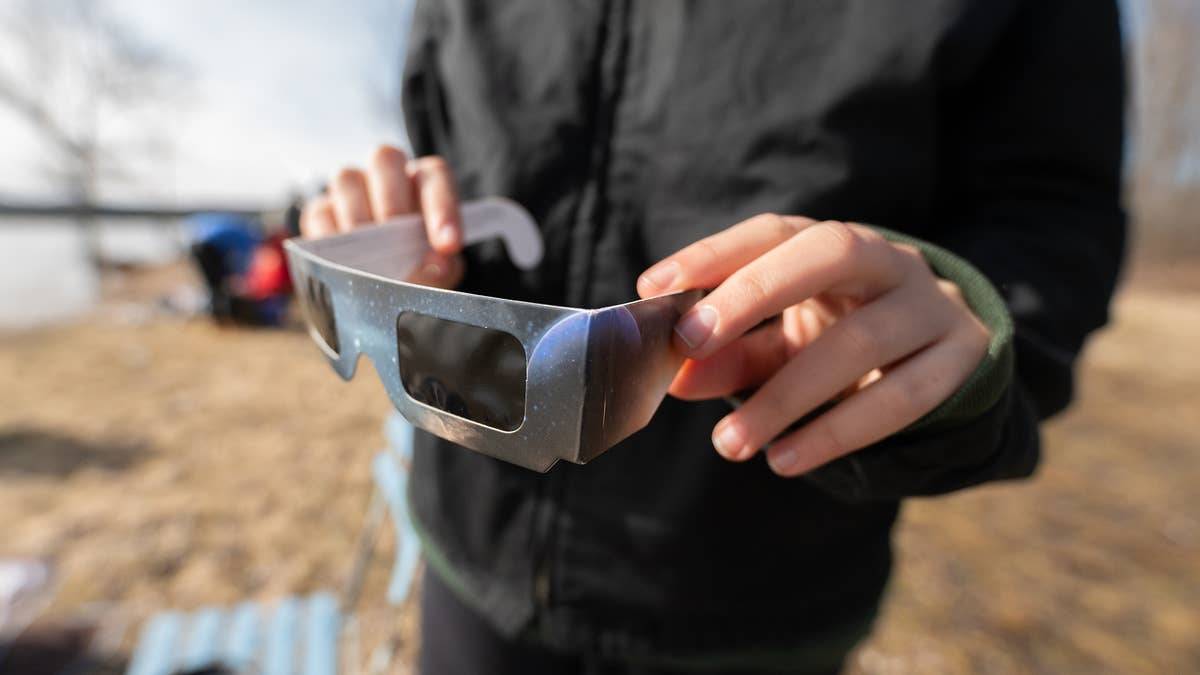
Eclipse 2024: Data Shows Sadly Predictable Increase in Google Searches About Eye Damage
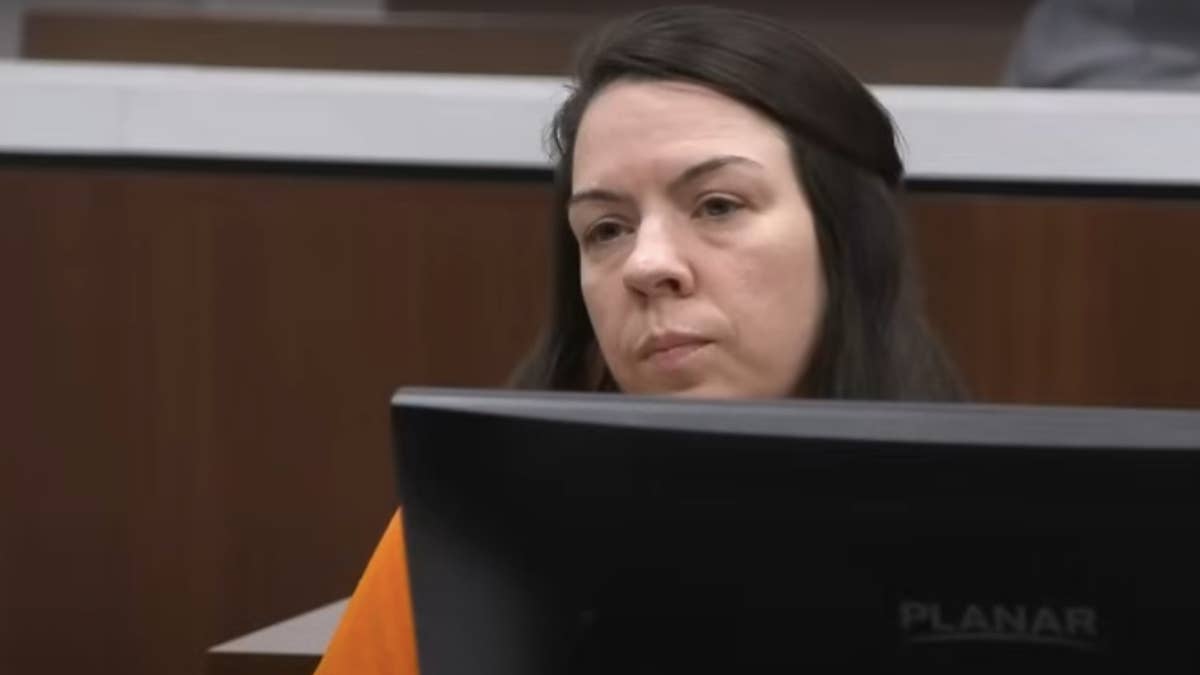
Convicted Eye Drop Killer Sentenced to Life After Poisoning Friend and Stealing Nearly $300,000
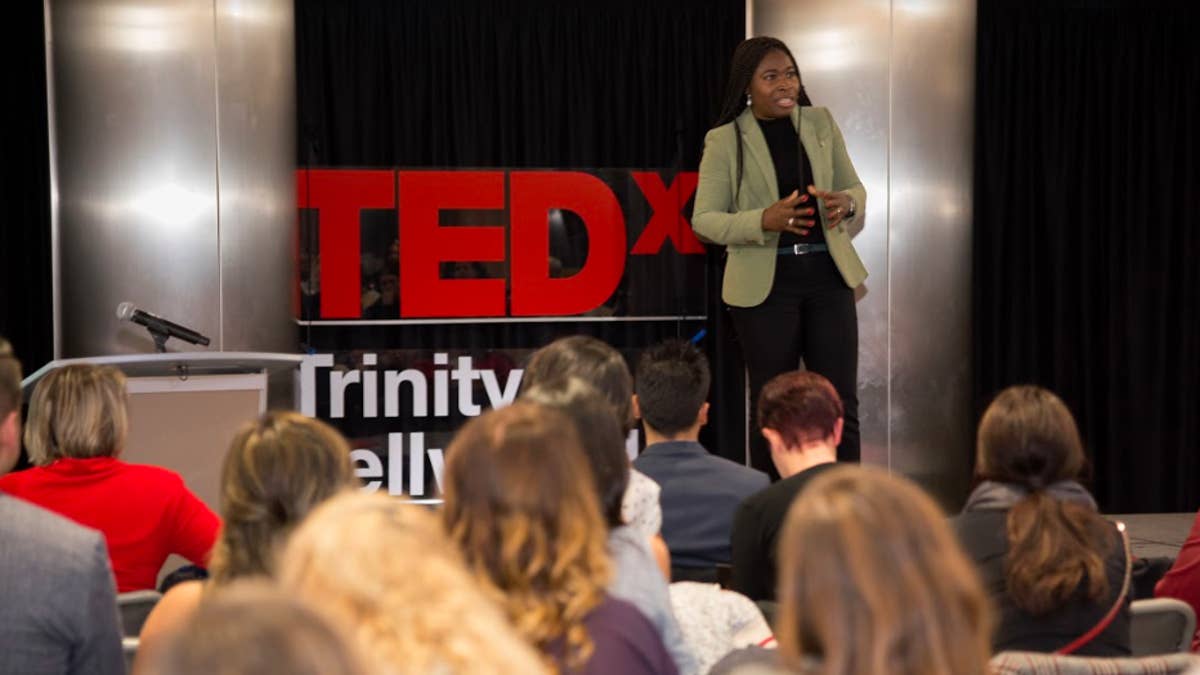
| BY JEFF FLYNN
CASA Foundation's Dr. Olutoyin Oyelade On Supporting Black Women Entrepreneurs

Fintech Cadence's Layial El-Hadi On Creating An Inclusive Ecosystem For Startups
- Skip to main content
- Keyboard shortcuts for audio player
Middle East
Survivors recount horrors of israeli siege on gaza's al-shifa hospital.

Aya Batrawy
Isreali forces concluded a two-week siege of Gaza's largest hospital. Survivors say forces destroyed the complex beyond repair, killed medics, detained hundreds of innocent people and burnt homes.
ARI SHAPIRO, HOST:
Israel's military raided the Gaza Strip's largest medical complex, laying siege to it for two weeks, saying Hamas fighters had regrouped there. Palestinians finally got a glimpse of the aftermath of that raid when troops withdrew on Monday. And a warning - this story includes graphic descriptions of death and violence. NPR's Aya Batrawy has this report.
(SOUNDBITE OF FOOTSTEPS ON RUBBLE)
AYA BATRAWY, BYLINE: Once Gaza's best-equipped hospital, Al-Shifa is now completely destroyed. Al-Shifa, which means healing in Arabic, is now a place of death. To see it now, after Israel's raid, was too much for one woman to bear.
UNIDENTIFIED PERSON #1: (Screaming in non-English language).
BATRAWY: She screams in Al-Shifa's courtyard, why, God, why? The hospital's been turned into a graveyard with bodies decomposing all around her. There are charred bodies in it's burnt surgical ward, shot and left to rot in its hallways, crushed by tanks outside its gates.
Israel says this was a precise operation targeting Hamas, the group that launched a deadly attack on Israel October 7, sparking this war. Israel's military says troops uncovered many weapons inside the hospital. Here's government spokesman Avi Hyman.
(SOUNDBITE OF ARCHIVED RECORDING)
AVI HYMAN: We went in there with a surgical force, special operations, and we took out over 200 terrorists. We apprehended over 900 terrorists with not a single civilian casualty.
BATRAWY: Palestinians say that's not true. Dr. Marwan Abu Saada, acting manager of Al-Shifa, named three colleagues killed during the siege.
MARWAN ABU SAADA: (Speaking Arabic).
BATRAWY: He says one was the chief engineer of the maintenance department, another the head of pharmaceuticals, and the third, a reconstructive surgeon killed with his mother.
ABU SAADA: (Speaking Arabic).
BATRAWY: The World Health Organization says 21 patients died in the hospital during Israel's siege, and more than a hundred patients were trapped without enough food or water. Emaciated-looking patients were carried out on stretchers after the raid ended. Emad Jibreel, one of the patients besieged inside Al-Shifa, told NPR of the squalid conditions.
EMAD JIBREEL: (Through interpreter) I spent about eight days without changing the dressing on my leg. It became infected twice. And the doctors and nurses couldn't care for us because they said they didn't have gloves or gauze.
BATRAWY: People living near the hospital say they also suffered. In the early hours of March 18, as Israeli forces swept into Al-Shifa with heavy gunfire and tanks, residents say other Israeli troops went pounding door to door, throwing stun grenades into homes as they rounded up people for interrogation. Nariman Qanita tells NPR what she saw.
NARIMAN QANITA: (Through interpreter) When they raided and came into the building, there were kids sleeping in their room - kids 12 and 13 years old. They cried out, baba, baba. We saw one bleeding out, wounded in his organs, not from bullets. He had a hole no smaller than 20 centimeters in him.
BATRAWY: She says the boy bled for hours until Israeli forces allowed him to leave. But she doesn't know if he survived. Hours later, Israeli troops ordered the women and children to follow a strict evacuation route. They weren't allowed to take anything with them, not their phones or IDs. The men were stripped down to their underwear. Other Palestinians told NPR similar stories. Qanita returned home when the siege ended. It was turned to rubble.
QANITA: (Through interpreter) There are no suitable homes to live in. Where do we go, people? While you're preparing your Eid clothes and Eid cookies, we're preparing shrouds and how to retrieve the dead from under our homes. It's enough already.
BATRAWY: Journalist Bayan Abusultan lives near Al-Shifa. She posted a reel on Instagram showing some of the moments she survived during the raid.
BAYAN ABUSULTAN: Smoke is coming out of houses near the hospital. They just bombed our neighbor's house. Smoke is everywhere.
BATRAWY: She says her only brother was killed. The family prays over his body.
UNIDENTIFIED PERSON #2: (Speaking Arabic, crying).
BATRAWY: In another scene, a fire breaks out in the building next to hers.
ABUSULTAN: A fire just started in our neighboring house. We're trapped. We're just praying that the fire won't reach us.
BATRAWY: Many homes were burnt down during the battle. Israel says hundreds of those apprehended in its raid were identified as, quote, "terrorists." Dr. Abu Saada, the acting manager of Al-Shifa, listed some of the names of staff from the hospital Israel is holding captive from this raid and a previous raid on the hospital in November.
ABU SAADA: (Non-English language spoken).
BATRAWY: Chief nurse at the hospital, Anwar Abu Riyala, says he was held in captivity for five days without enough food by Israeli forces.
ANWAR ABU RIYALA: (Non-English language spoken).
BATRAWY: He says he survived what felt like certain death. Al-Shifa hospital once had a capacity of almost 800 beds. More than a quarter million people were rushed through its emergency rooms a year.
ABU RIYALA: (Non-English language spoken).
BATRAWY: "We don't understand the purpose behind this complete and utter destruction, behind the killing, torture, siege," Abu Riyala says. "We're civilians. We have no one but God," he says.
Al-Shifa was struggling to function before this siege. It lacked enough medicine and fuel. Still, it served as a last ray of hope for malnourished children and the wounded. It now joins a long list of hospitals in Gaza no longer able to offer even that.
Aya Batrawy, NPR News, with reporting from Omar Al-Qattaa in Gaza City.
(SOUNDBITE OF RIOPY'S "MEDITATION")
Copyright © 2024 NPR. All rights reserved. Visit our website terms of use and permissions pages at www.npr.org for further information.
NPR transcripts are created on a rush deadline by an NPR contractor. This text may not be in its final form and may be updated or revised in the future. Accuracy and availability may vary. The authoritative record of NPR’s programming is the audio record.
CDC expected to alert doctors about fake Botox
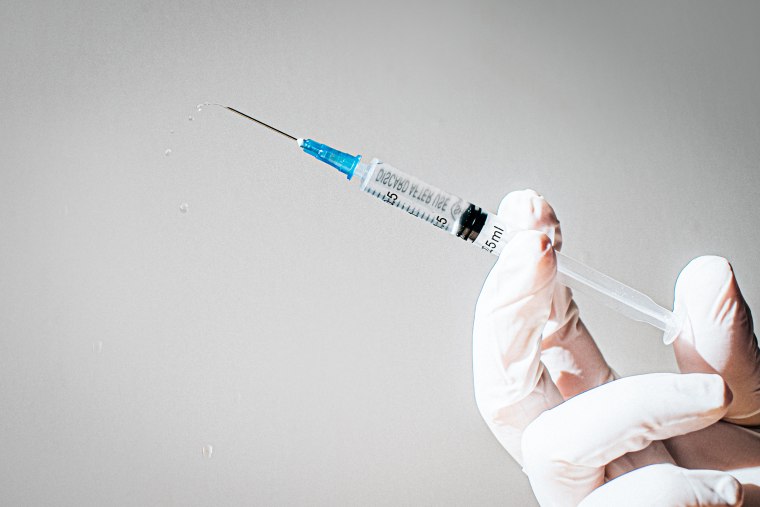
The Centers for Disease Control and Prevention is poised to alert doctors nationwide about fake Botox injections that have already hospitalized at least four people.
The CDC said Wednesday that it's coordinating a “multistate outbreak investigation into a few botulism-like illnesses in several states" caused by botulinum toxin injections, commonly called Botox, that weren't given in a medical office.
Health departments in Illinois and Tennessee have reported cases possibly linked to counterfeit Botox, with two people in each state hospitalized. Two other cases were reported in Tennessee but weren’t serious enough to warrant hospitalization.
Additionally, on Thursday NBC News confirmed four cases in Kentucky and a suspected case in Washington state. In Kentucky, two individuals were hospitalized, although all four are now recovering, according to the Department of Public Health.
Clostridium botulinum is a nerve toxin that relaxes facial muscles that would otherwise cause wrinkles. Botox is generally considered safe, but too much in the wrong places can be damaging, according to the CDC .
Dr. Adam Friedman, a dermatologist and professor and the chair of dermatology at George Washington University, said it’s difficult to ensure quality of products that don’t have reputable sources.
“You’re spinning the wheel of terror when it comes to these counterfeit products,” Friedman said. “If something seems too good to be true, chances are it is too good to be true.”
Warnings nationwide about medical procedures at unregulated med spas are rising. The Illinois patients received injections from a nurse “who was performing work outside her authority,” according to the state’s Public Health Department.
Patients “reported symptoms similar to botulism such as blurred/double vision, droopy face, fatigue, shortness of breath, difficulty breathing, hoarse voice following injection with either Botox or a possibly counterfeit version of the product,” Illinois public health authorities said.
Erika Edwards is a health and medical news writer and reporter for NBC News and "TODAY."
Huntsville PD on scene of standoff at apartment complex on Sparkman Dr.
MADISON CO., Ala. ( WAFF ) - Multiple units with Huntsville Police Department SWAT are on the scene of a standoff near Sparkman Dr.
According to officials on scene, Huntsville Police responded to a domestic violence call at an apartment complex.
At this time the victim has come out of the apartment but the suspect has barricaded themself in the apartment and will not come out.
An official on scene also says children are allegedly in the apartment with the suspect but officers have not seen them yet.
A WAFF 48 News Crew is on the scene.
This is a developing story and it will be updated as more information becomes available.
Click Here to Subscribe on YouTube: Watch the latest WAFF 48 news, sports & weather videos on our YouTube channel!
Copyright 2024 WAFF. All rights reserved.

Man killed overnight after crashing into Tennessee River

Heavy rain, gusty winds possible late Wednesday into Thursday morning

Teacher faces termination after calling in sick for 2 days to attend a concert in Nashville, district says

Expired pork, rusty ice machines and another downtown Huntsville hot spot on Kitchen Cops’ trouble list

Country singer’s daughter arrested in Millbrook for indecent exposure
Latest news.

Rogersville man accused of rape, incest, and sodomy

Colbert Co. man accused of killing Sheffield man found not guilty

Former Limestone County Sheriff Mike Blakely granted parole

IMAGES
VIDEO
COMMENTS
Complex patients are increasingly common in primary care and often have poor clinical outcomes. Healthcare system barriers to effective care for complex patients have been previously described, but less is known about the potential impact and meaning of caring for complex patients on a daily basis for primary care providers (PCPs). Our objective was to describe PCPs' experiences providing ...
Public Health & Policy > Medicare Calif. Docs Among Top Billers for Complex Visits. by Lisa Aliferis, April Dembosky and Lisa Pickoff-White May 22, 2014
1.1. Patients are more complex. The aging of the primary care population coupled with better disease prevention and treatment efficacy means that more patients are living longer with multiple comorbidities that require complicated medical regimens. 1 By 2020 there will be an estimated 130 million Americans with one or more chronic conditions. 2 Patients with multiple chronic conditions have ...
Mayo Clinic Complex Care Program: Realize the value of high-quality care. If your employees or members of your medical plan are experiencing fragmented care, ineffective treatments, potential misdiagnoses or difficulty accessing specialized care for complex conditions, Mayo Clinic can help. At our campuses in Arizona, Florida and Minnesota ...
Dr. Daniel Ngui, BSc (P.T), MD, CFPC, FCFP, Family Physician, discusses Annual Complex Care Planning Visits with your Family Physician" 130422 Views Video transcript
Percent distribution of complex visits, by time-based visit levels and type of specialty, 2013-2016. FM/GP, family medicine and general practice; IM, internal medicine. ... (NIH Director's Early Independence Award, 1DP5OD024564, to Dr. Song) Author information. Authors and Affiliations. Wang 625, Massachusetts General Hospital, 15 Fruit St ...
Complex care is a person-centered approach to address the needs of people who experience combinations of medical, behavioral health and social challenges that result in extreme patterns of healthcare utilization and cost. Complex care works to eliminate gaps in healthcare by delivering integrated services for people whose healthcare needs ...
Visit Kremlin is on top of things to do in Moscow. A place of power for centuries, the Kremlin then shows us a whole different image when viewed from the inside. If you want to visit Moscow in 2 days, the Kremlin is certainly one of the must-see places in Moscow. Opening hours: Daily from 10 a.m. to 5 p.m., except Thursday.
An estimated 250 000-300 000 people work, live or visit the complex at any moment. Now «Moscow-City» occupies more than 60 hectares and includes 19 buildings, including «Federation» and «OKO» towers, known as one of the tallest skyscrapers in Europe. The construction of «Moscow-City» takes place on the Presnenskaya embankment of the ...
Explore the Kremlin Museums: Discover the rich history and art collections housed in various museums within the complex. 3. St. Basil's Cathedral. The renowned St. Basil's Cathedral, an iconic landmark in Moscow, is famously recognized as the Cathedral of the Intercession of the Most Holy Theotokos on the Moat.
Last Updated on January 6, 2024 by Irena Domingo. Moscow City is the city of skyscrapers, in true New York City style. Dazzling skyscrapers with observation decks, futuristic hotels, panoramic restaurants or a modern shopping center are just some of the attractions of this city of business and entertainment, for those who want to visit something beyond the Red Square or the Kremlin.
These include 1. Urban polyclinics with specialists in different areas that offer general medical care. 2. Ambulatory and hospitals that provide a full range of services, including emergency care. 3. Emergency stations opened 24 hours a day, can be visited in a case of a non-life-threatening injury.
As it is, many doctors diagnose the condition based on two of three factors: Irregular periods. High androgen levels. Multiple follicles on the patient's ovaries. But these three factors don't ...
Walking tour around Moscow-City.Thanks for watching!MY GEAR THAT I USEMinimalist Handheld SetupiPhone 11 128GB https://amzn.to/3zfqbboMic for Street https://...
I was on no medication at all on a regular basis," Gibbon, of Santa Monica, California, told NBC News. When he developed a cough and then lost weight, Gibbon got a chest X-ray and CT scan of his ...
EPIC MOSCOW Itinerary! (2024) Moscow is the heart of Mother Russia. Just the mention of this city conjures images of colorful bulbous pointed domes, crisp temperatures, and a uniquely original spirit! Moscow has an incredibly turbulent history, a seemingly resilient culture, and a unique enchantment that pulls countless tourists to the city ...
🎧 Wear headphones for the best experience.For watching on a big screen 4K.In this video, we will take a walk among the skyscrapers of the Moscow City Intern...
Under the piazza levels the 2-storey retail mall connects the Evolution Tower with metro station and pedestrian bridge over Moscow river, thus integrating the new development into the large Moscow-City district, the Europe's newest and most ambitious high-rise cluster (7 of 10 highest European skyscrapers ae located here), housing over 4 million square meters of office and retail areas with ...
Day 6 - Explore the Golden Ring. Creating the Moscow itinerary may keep you busy for days with the seemingly endless amount of things to do. Visiting the so-called Golden Ring is like stepping back in time. Golden Ring is a "theme route" devised by promotion-minded journalist and writer Yuri Bychkov.
The Moscow International Business Center (MIBC), also known as Moscow-City, is a commercial development in Moscow, the capital of Russia.The project occupies an area of 60 hectares, and is located just east of the Third Ring Road at the western edge of the Presnensky District in the Central Administrative Okrug.Construction of the MIBC takes place on the Presnenskaya Embankment of the Moskva ...
It is a fortified complex in the center of Moscow that was linked to all of Russia's most important historical and political events from the 13 th century. That Kremlin is composed of more than 15 buildings, 20 towers, and more than 1.5 miles of walls. The walls are 21 feet thick! ... Moscow is the city to visit. The Moscow Botanical Garden ...
Top Moscow Attractions Tickets. Purchase the Moscow City Pass and get access to some of the most iconic attractions like the Bolshoi Theatre, All-Russian Exhibition Center, Red Square, Moscow Zoo, and Kremlin. These attractions are an ode to the city's rich history and culture and reflect all strands of Russia's convoluted past.
Completed in 1961, it is the only modern building in the Kremlin. 2. Red Square. Lying at the heart of Moscow, Red Square is the most important and impressive square in the city. It is one of the most popular tourist attractions due to its wealth of historical sights and cultural landmarks.
Astrology Influencer Kills Partner and Eight Month Old Baby in Eclipse Day Murder-Suicide. The woman, who had over 100,000 followers on X, made a series of concerning posts leading up to the eclipse.
Isreali forces concluded a two-week siege of Gaza's largest hospital. Survivors say forces destroyed the complex beyond repair, killed medics, detained hundreds of innocent people and burnt homes.
On 22 March 2024, a terrorist attack carried out by the Islamic State occurred at the Crocus City Hall music venue in Krasnogorsk, Moscow Oblast, Russia.. The attack began at around 20:00 MSK (), shortly before the Russian band Picnic was scheduled to play a sold-out show at the venue. Four gunmen carried out a mass shooting, as well as slashing attacks on the people gathered at the venue, and ...
Dr. Adam Friedman, a dermatologist and professor and the chair of dermatology at George Washington University, said it's difficult to ensure quality of products that don't have reputable sources.
MADISON CO., Ala. - Multiple units with Huntsville Police Department SWAT are on the scene of a standoff near Sparkman Dr. According to officials on scene, Huntsville Police responded to a domestic violence call at an apartment complex. At this time the victim has come out of the apartment but the suspect has barricaded themself in the apartment and will not come out.
Visitor Center Hours. Tuesday through Saturday. 8 AM until 4 PM. Merritt Island National Wildlife Refuge, located along Florida's coast about 60 miles east of the city of Orlando, was established by agreement as an overlay of the National Aeronautics and Space Administration's John F. Kennedy Space Center. The refuge lies within one of the ...
Rory McIlroy hits from the fairway on No. 10 during a practice round for the 2024 Masters Tournament at Augusta National Golf Club. (Photo: Rob Schumacher-USA TODAY Sports) Golf Channel's Brandel Chamblee noted McIlroy's struggles out of the game - in his last five Masters, McIlroy averages 73.8 in the first round.